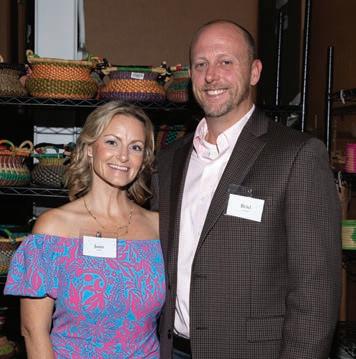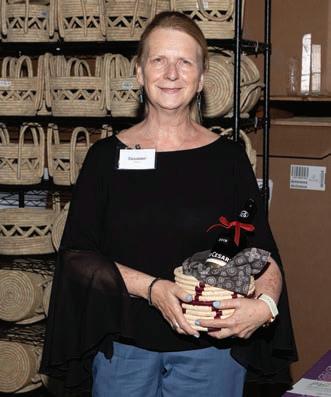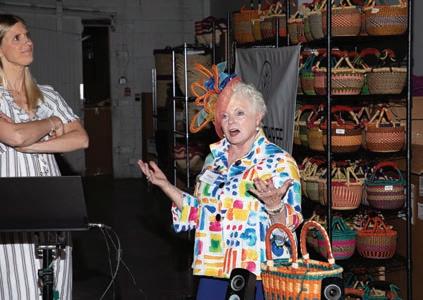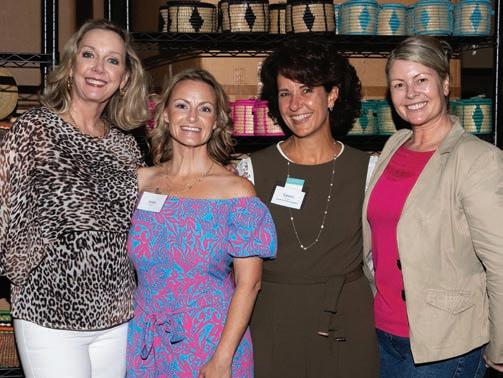










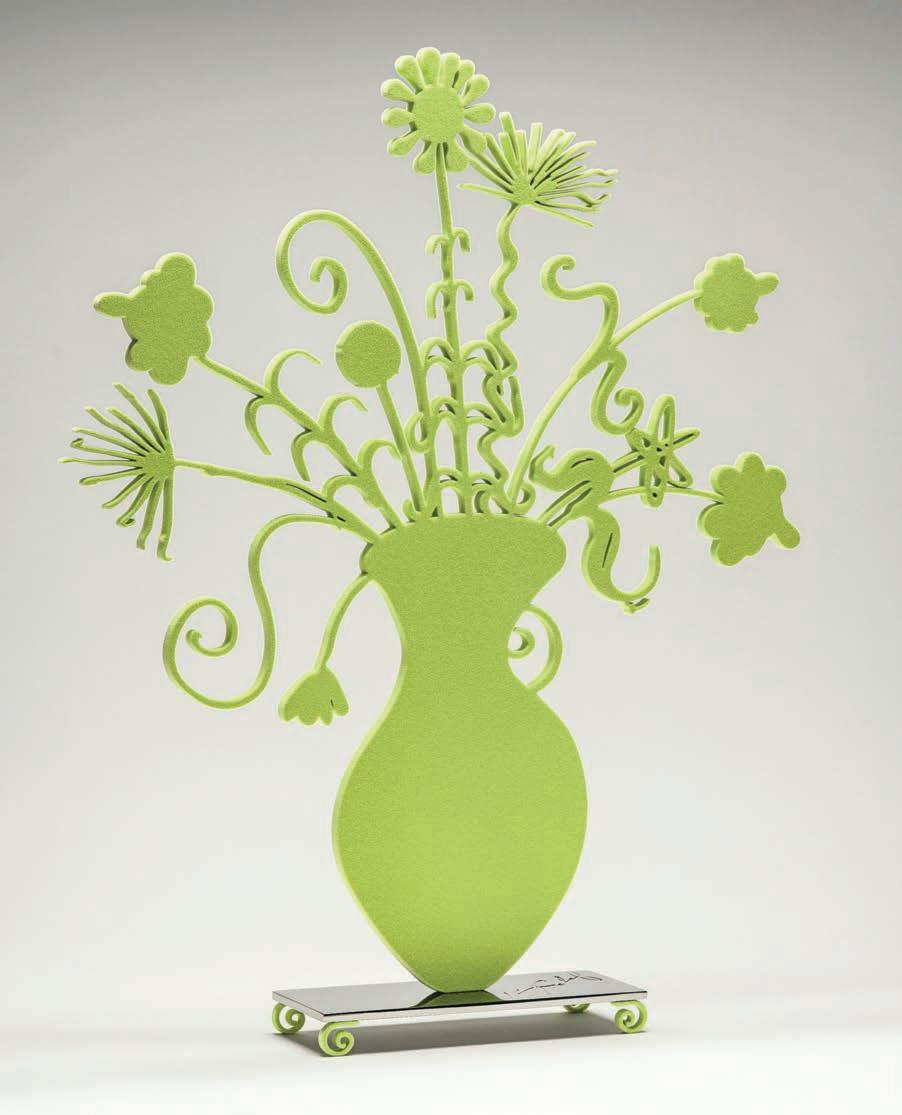




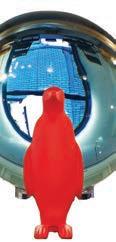
In celebration of Kit Heffern’s 50th anniversary at Elleard Heffern, the local Saint Louis fine jewelry company is honoring some of the city’s most dynamic women.
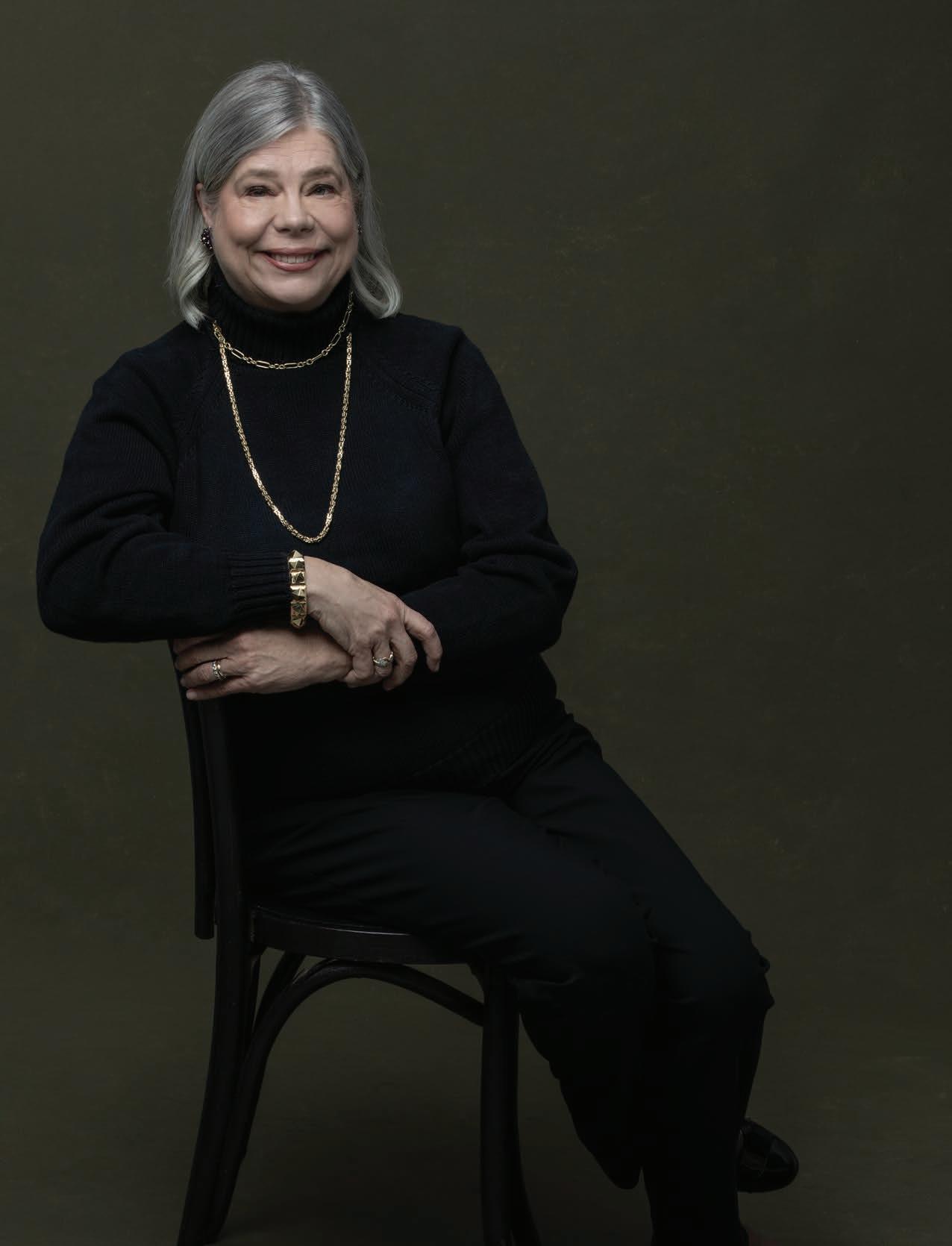
Active docent of The Eugene Field House
Family of historians and philanthropists dating back to 1840

Outstanding Philanthropist Award by the National Society of Fundraising Executives
Rozier Award for significant contributions to the field of historic preservation in Missouri Styles with Elleard Heffern
For those of you who follow such things, it’s true. I’m back.
After a lengthy hiatus, I’ve happily resumed my former spot as editor-in-chief. Retirement is perfect for some; it’s Cinderella’s glass slipper on the foot of one of her evil stepsisters for me. Not a great fit.
I am thrilled to be here, editing the magazine, and having the chance to ballyhoo my beliefs. Lord knows, I have a few.
I am one of those proud St. Louisans. Born and raised here, I left for decades pursuing greener horizons in the name of professional advancement. I loved Chicago and I adored New York. But I cherished coming home. Once back, I have stayed put. This is my kind of town. Here people (more often than not) are friendly and kind. They (usually) hold the door for you. They (usually) let you cut in on the highway. If you’re in a hurry, they (occasionally) will let you jump ahead in the line. They’re quick to offer a hand or join in a chat.
But when St. Louisans look at their own fair city, they—more often than not—dwell on the negative. It’s easy. It’s too easy because there is so much to lament. The shootings. The homeless. The poverty. The politicians. The potholes. The crazies running red lights on Kingshighway. Yes, there is an undeniable plethora of problems.
Yet, there is also plenty to applaud. St. Louis has people who are working tirelessly to make a difference. Go see StL City play and marvel at the beautiful (and immaculately clean) stadium. See all the fans decked out in their pink and blue gear, pick up dinner at one of the local restaurants selling there. Watch the St Louligans’ waving those oversized flags. Hear the deafening pounding of drums. And, quietly thank Carolyn Kindle and the entire Taylor clan.
In the pages of this month’s issue, there are several examples of things going exactly right. The boutique hotel chain, 21c, has transformed the dilapidated downtown YMCA into an exquisite mix of contemporary art museum, fine dining, and elegant digs. Phil Hulse, the CEO and founder of Green Street Real Estate Ventures, has been buying up acres upon acres of land and plenty of it lies way east of Forest Park. As is the company’s wont, they purchase St. Louis landmarks which have seen better days (decades) and breathe new life into those crumbling walls.
In the upcoming editions of Sophisticated Living St. Louis, we’re going to highlight the positive and the people who are bound and determined to improve both the city and its lifestyle. We want to spotlight the latest and greatest in everything from architecture to the arts, restaurants to retail, sports, stars and more. We want to feature people who are proud to be from or live here in St. Louis.
I know I am.
And, it’s great to be back.
Christy Marshall, Editor in Chief EditorSTL@slmag.net

PUBLISHER
Craig Kaminer craig@slmag.net
EDITOR IN CHIEF
Christy Marshall EditorSTL@slmag.net
DIGITAL CONTENT EDITOR
Grayling Holmes DigitalSTL@slmag.net
ADVERTISING
Cortney Vaughn Cortney@slmag.net
Rachel Sokolich Rachel@slmag.net
Karen Palmer Bland Karen.palmer.bland@gmail.com
CONTRIBUTORS
Writers
Grayling Holmes
Design
Stephanie Grateke
Photography
Alise O’Brien
Jennifer Silverberg
Carmen Troesser
SOPHISTICATED LIVING MEDIA
Eric Williams
Bridget Williams
Greg Butrum
Jason Yann




Fall into great finds at Colonial Marketplace. With more than 20 unique boutiques, great eats, and best-in-class services, you can eat, shop, and experience—all in one place.

The Return of Nomination to St Louis! Exclusively at YLANG YLANG.



Absolute Athlete Drip $99

Black eyeglasses from Versace are perfect for focusing at work or relaxing at home. Prices vary

Aviator Nation
Puremeso Acid Wash Button Up in Wine - impossibly soft and stretchy fit with a polished look.

$98
B12 Injections - Increase energy levels, combat fatigue, speed up metabolism and help improve sleep patterns.

$10 each
Vintage Cherry Suit in Navy. $140
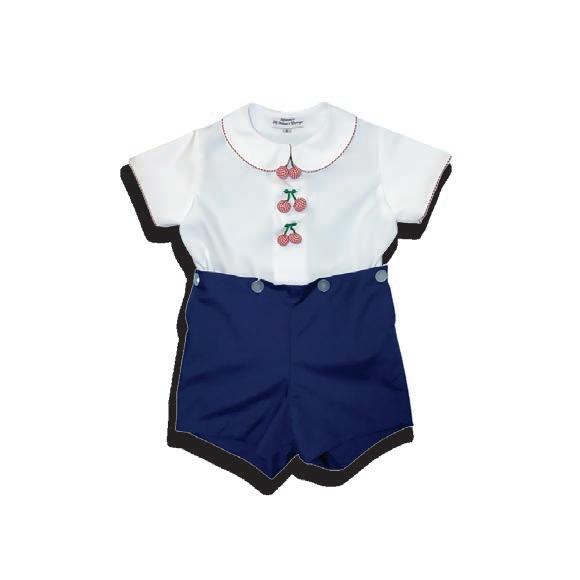

Classic Cherry Dress in Royal Blue Check. $150
Metal Detox shampoo detoxifies hair, removing accumulation of metal particles. The Masque protects hair to maintain color vibrancy. 10 oz shampoo $30 8 oz masque $45

Triple Berry Waffle
$15
 Classic Stripe Hoodie. $185
Classic Stripe Hoodie. $185
“To him, all good things—trout as well as eternal salvation—come by grace and grace comes by art and art does not come easy.”
Amelia Tufts and Gabe Batson know all too well about the challenges of art and the passion required to achieve perfection. You can see it in each of their bespoke fly rods; exquisite rod cases, purses and trunks, and their carefully crafted canoes.

You might assume their company is based in, say, Montana.
It’s not. It’s in Maplewood.
The couple first met 18 years ago in Portland, Oregon. She was working at Voodoo Doughnut with Gabe’s roommate. She grew up in St. Louis; he’s a native of Westchester, New York. She didn’t fish; he did.
“I noticed people were fly fishing and it seemed out there the best way to catch steelhead and trout and the species of fish that were in the rivers we were fishing in,” Gabe says. “I started buying these old books on fly fishing and every single one of them mentioned you have to get a bamboo rod if you’re going to fly fish, because that’s the ultimate in performance.” Then he started to investigate how to make his own.
“Gabe is really a self-taught person,” Amelia says. “He really dives deep when he’s learning about something.” After Gabe lent her a rod and reel, she taught herself how to fish and also started
making rods several years later. Their company is Tufts & Batson (tuftsandbatson.com).
The intricacies of making a bamboo rod are “very involved and it takes a million steps,” Amelia says. It took Gabe nearly two years to make his first one in 1999. He met a mentor, a retired high school history teacher from California, who offered to teach him. Then Amelia and Gabe ran into Daryll Whitehead, who had been crafting rods for more than 35 years. They found him in a supply shop turning a piece of mastodon ivory into the reel seat for a fly rod.
“I’m like, this is something interesting,” Amelia recalls. “He saw a desire in us that was there and a willingness to take criticism. We brought everything we had made. And he’s like, ‘Well, yeah, if you’re serious about making something really good, I would throw these away.’ That was hard.”
In 2008, the couple moved from Portland to Sweet Home, Oregon and for the next five years, learned from Daryll. “We moved down there specifically to learn the craft of making the best fly rods in the world with this mentor,” Gabe says. “He is a really good teacher because he didn’t show us by rote, that this is the way it’s done. He didn’t even show us his own designs until after we were here in St. Louis and were up and running as a company, because he didn’t want us to merely imitate how he did things.
If you’re in the market for a bespoke fly rod, a handmade trunk covered in a Chanel tweed, or a custom-made canoe, you may think you’d have to travel far and wide. You don’t.
By Christy Marshall / Photography by Carmen Troesser

“Instead, he just exposed us to the world of bamboo rods and what made this maker great and what made this historical figure important and how it worked,” Gabe continues. “He kind of lifted the curtain on the mechanics and the underlying fundamentals, the principles of bamboo fly rods. He let us pick and choose on our own and learn on our own.”
While they were perfecting their designs for the fly rods, the couple weren’t cottoning to the small-town life of Sweet Home. At the end of 2012, they moved to Maplewood.

“I have family here and old friends who I’ve stayed in touch with,” Amelia says, “It just felt like a really comfortable place to come home to. And, it just turned out to be an amazing move for us.”
The couple’s fly rods caught the eye of fly-fishing guru Carmine Lisella, the owner of Jordan-Mills Rod Co. Until about five years ago, he published small booklets twice a year on the sport. “And then one day I’m reading it and I realized we’ve got three rods in there, and he’s saying all these wonderful things about us,” Gabe says.
“It felt validating,” Amelia says. “That we are really rod makers.” The orders started streaming in by handwritten letters, emails,
phone calls, through proxies, direct messaging and friends. The cost of a rod starts at $3,500 and goes up to $10,000. The lead time runs from five months to a year.
The process begins with talking to the client, determining their preferences. “It’s almost like tailoring a suit,” Gabe says. Amelia explains that they ask a series of questions: What does he or she have in mind? What is his or her favorite rod like? What do he or she want to see in a new rod? What isn’t the client getting? What kind of flies do they use? Do they want a slow-action rod or a fast one? Then the couple takes the buyer outside to the neighboring yard and watches them cast a rod.
“We get to know them as a person and what they like, and sometimes that triggers a bit of inspiration in terms of materials,” Gabe says.
The materials include the fabric lining and covering the box holding the rod. “We’ve purchased vintage saris from India and we made it part of the story of the life of the rod,” Gabe says. “We almost build a history into the rod so that it has that kind of an experience. When you open it, it’s almost like an artifact that you’re discovering instead of just a brand-new product.”

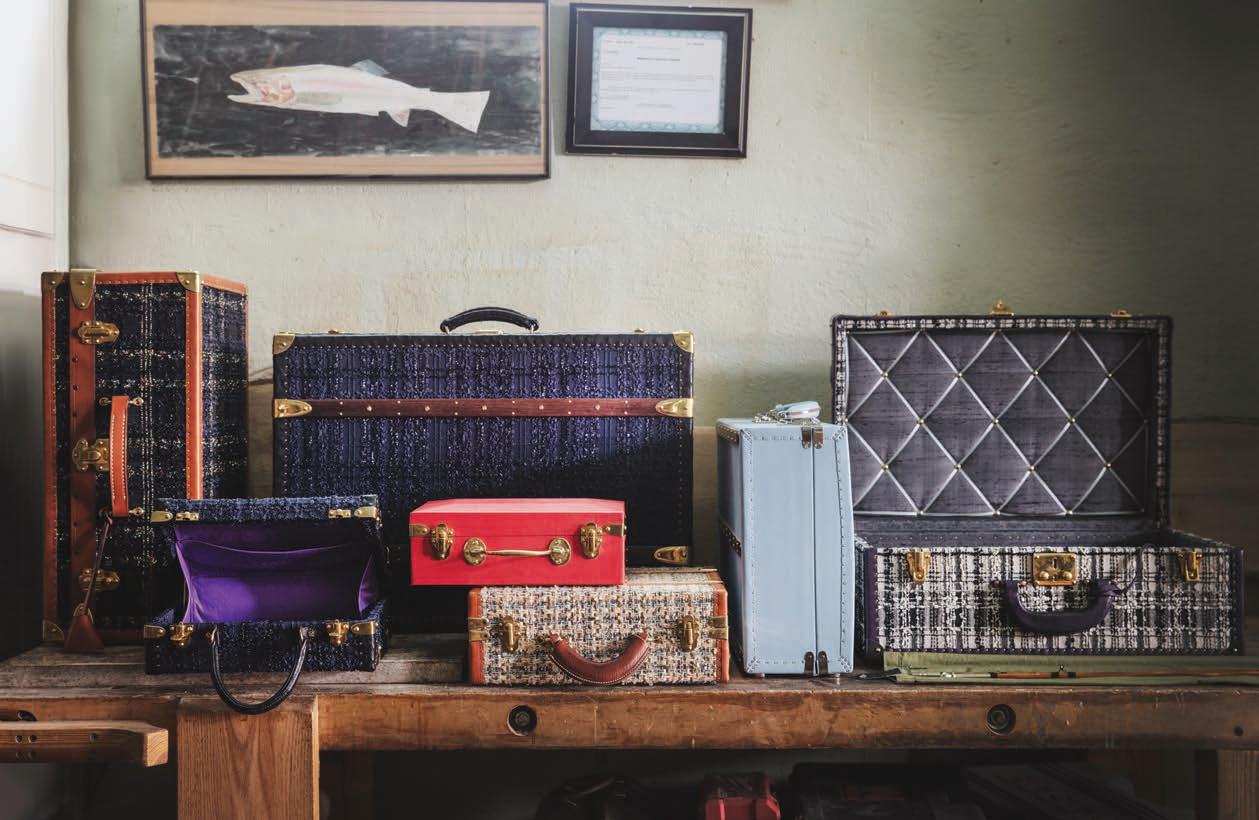 Tufts and Batson trunks
Tufts and Batson trunks
Starting in 2020, those boxes have led to a second line marketed by Tufts & Batson: what they call trunks and the layperson would be inclined to dub purses, suitcases, and trunks. All of them are stunning purses and suitcases that should either be used on a private plane or put out on display in a house.
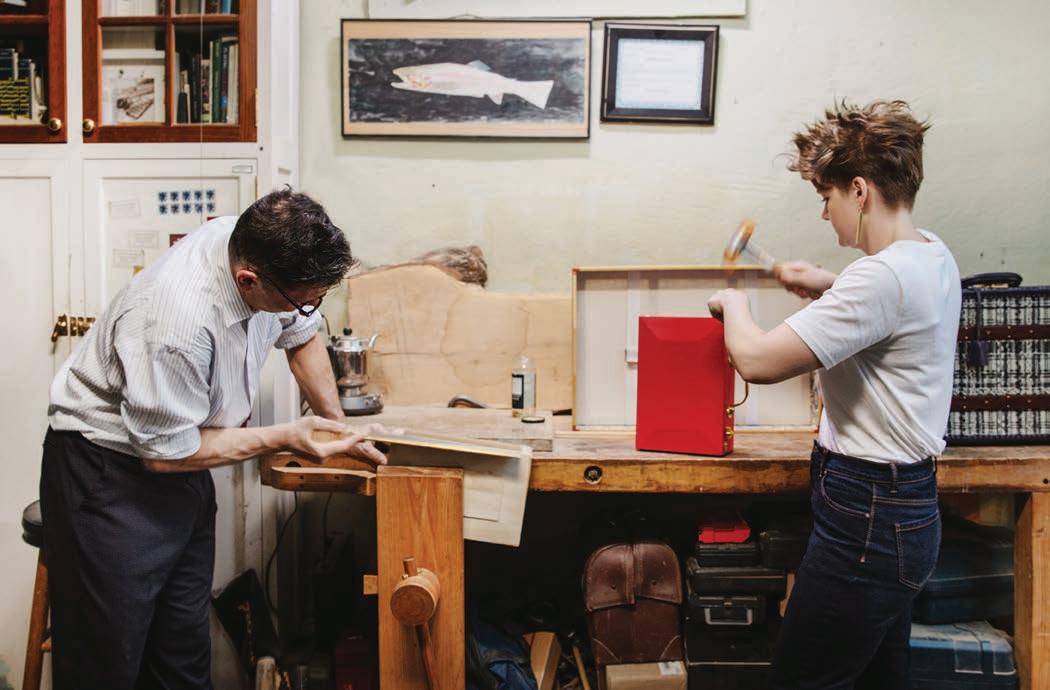
The couple makes the purses/trunks out of Kiri wood. “It’s the highest weight to strength ratio,” Gabe says, adding it’s fireproof, bug proof and warp resistant.
“We want to make sure that every detail is right,” Amelia says. The fabric is from Chanel, the hardware from Paris, and they apply the leather pelts, make the handles and the brackets themselves. The trunks include lingerie drawers. All custom-ordered, the prices start at $2,000 for the small trunks/purses; $8,000 for the trunks.
According to Amelia, clients have bought them for a variety of uses ranging from holding a collection of Hermes scarves or old photos to using the larger trunk as the base for a coffee table. “We build these to last for generations,” she says. “We know their beauty will grow over time.”


But the product line doesn’t stop there. During Covid, the couple decided to start making canoes. Gabe had seen a man holding one in the palm of his hand.
“I was like, that is really cool,” Gabe says. “So, I started investigating how those are made. I ended up meeting someone who teaches how to make them and we started making them. The fun thing that happened is we realized because of our fly-rod experience we could add all sorts of things to the canoes that we
didn’t see on canoes prior. There was one watershed moment when we were finishing a canoe for a dear friend of ours and I just had this tug within me. I asked Amelia to look at the problem of the gunnels. She convinced me to do the thing that I wanted to do, but dared not to do, which was to cover the gunnels in leather. Then that led to the leather seats and then making the removable floor in the bottom leather, so that every way you interact with the canoe is with this buttery smooth leather. It’s durable and it’s beautiful.”
The leather is the same one used for horses’ bridles. The canoe frame is covered in an impregnated fabric that looks like canvas. “We started painting it all these wonderful colors,” Gabe says. “It grows organically.” A one-person canoe only weighs 35 pounds and sells for approximately $3,500; a 15-footerwith two seats retails for $6,000.
The couple’s creativity knows no bounds.
“We’re just creative people,” Amelia says. “We can’t help ourselves.” The latest venture is perfume, now under development.

“Eventually, we hope to have an entire lifestyle brand including a fragrance and additional accessories, all with the art of travel and adventure in mind,” Amelia says.
“We have a lot of things we still want to do,” Gabe adds. “It would be so wonderful to be able to make those a reality. Part of being able to do that is growing as a business so that we can invest more into making more beautiful things like this.”
Amelia smiled and added, “We really do put our heart and soul in it.” sl



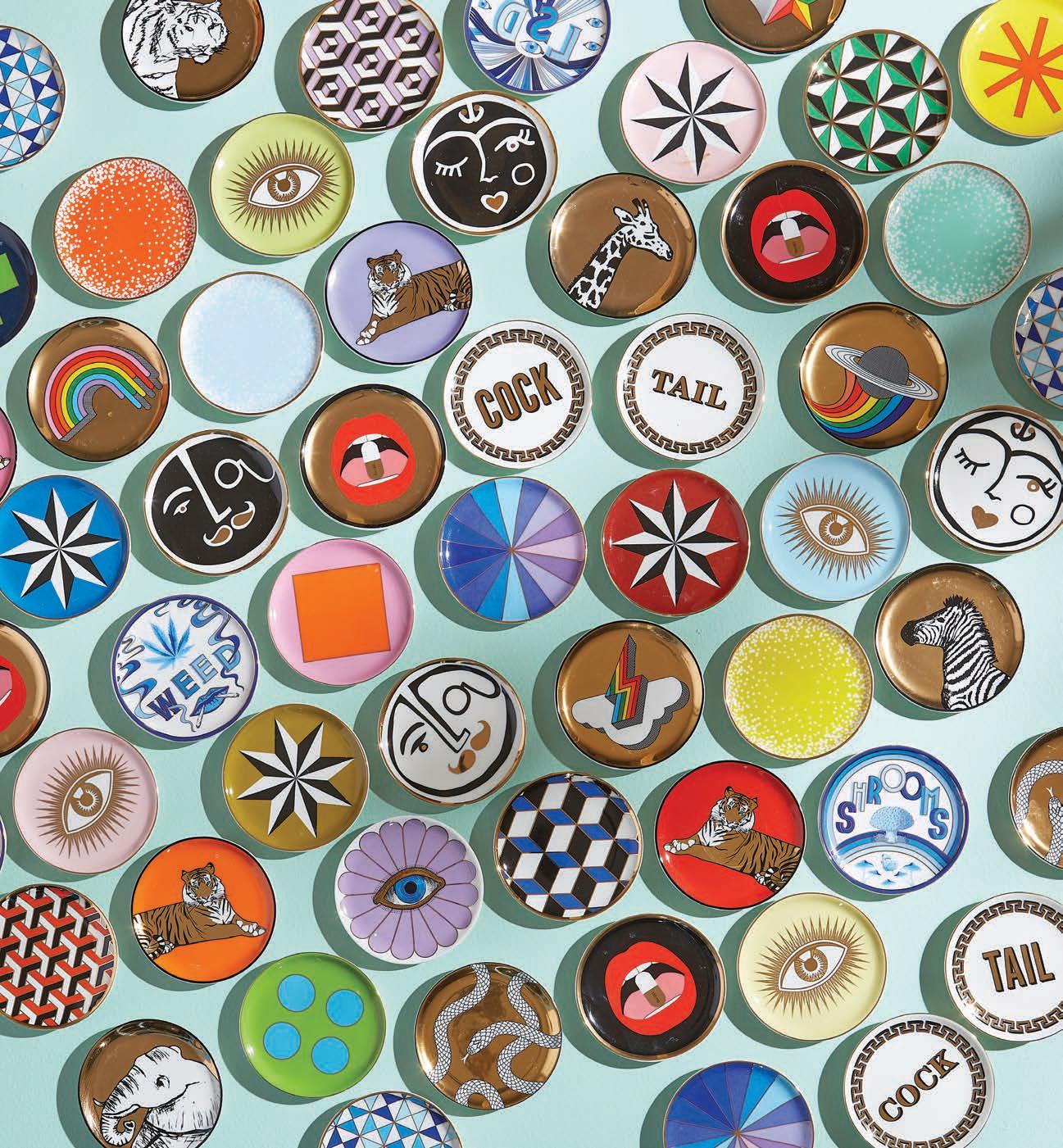
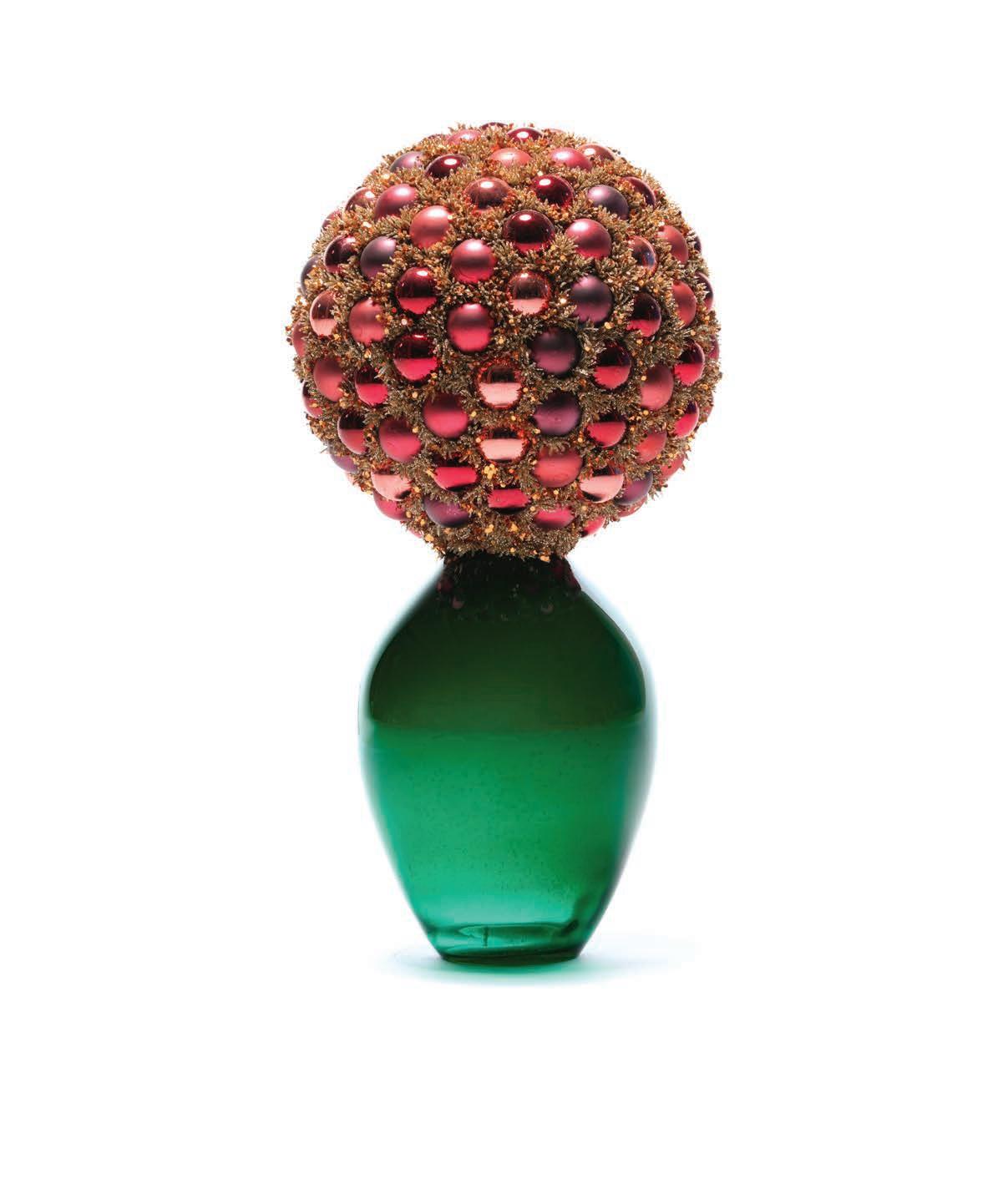
In 1990, I worked in the Shell Building on the corner of 12th and Locust and played racquetball three blocks up at the YMCA. It wasn’t the best of neighborhoods, but since then there have been a lot of positive developments including residential housing on Washington Avenue, the Aquarium at Union Station, City Park, Stifel Theatre, The Foundry, The Armory, and the soon to open 21c Museum and Hotel.
For years, city champions have lobbied the boutique hotel chain – founded by Laura Lee Brown and Steve Wilson – to open a 21c here. They didn’t have any luck.
Until now.
Welcome to the 21c Museum Hotel St. Louis, a groundbreaking concept that revolutionizes the way we experience art. If you didn’t collect before your stay, you are sure to get the itch by the time you check out. Already operating in 10 cities across the United States, the 21c Museum and Hotel not only showcases contemporary artworks but also offers a luxurious and immersive stay for art enthusiasts and travelers alike.
The 21c Museum and Hotel was born from the vision of a couple with a passion for art, a desire to revitalize communities through culture, and, as heirs to the Brown-Forman fortune,
the wherewithal to do it all. In 2006, they transformed a series of historical warehouses in Louisville, Kentucky, into the first 21c Museum and Hotel. The goal was to create a space where contemporary art could be accessible to all, blurring the lines between museum, hotel, and cultural center.
Today, the company has expanded beyond Louisville to Cincinnati, Bentonville, Durham, Lexington, Oklahoma City, Nashville, Kansas City, Chicago, and now St. Louis. Each has its own unique character and artistic offerings. The founders’ commitment to showcasing innovative and thought-provoking works has remained steadfast, as has their dedication to providing exceptional hospitality experiences.
In St. Louis, the boutique chain bought the downtown YMCA, originally built in 1926. “One of the biggest challenges, but also one of the biggest opportunities in our minds, was to breathe new life into this historic and significant building for St. Louis,” says Molly Swyers, former chief brand officer and now consultant to 21c. “Obviously, there was a lot to do to update it both for contemporary use and because certain parts of it had fallen into disrepair. “
The lobby greets you like an expansive living room with contemporary art and a lot of soft seating for relaxing and

hanging out. On the second floor, the common space, which was once the gym’s gymnasium, is dedicated to a gallery and event space for the museum. Among the historic elements saved is the original running track, and exposed brick walls. Some of the other spaces on the second floor have a more contemporary feel.
What sets 21c St. Louis apart is its exceptional curation of contemporary art that spans a diverse range of mediums, styles, and themes. The museum’s exhibitions are not confined to traditional galleries; they spill out into lobbies, hallways, and even guest rooms, blurring the boundaries between art and daily life. In the new St. Louis hotel, the 14,000 square feet of exhibition space is seamlessly integrated into all areas of the property. There are opportunities to discover art around every corner. From the moment they step inside, guests are welcomed by mesmerizing installations that ignite the senses The museum’s rotating exhibitions feature renowned artists as well as emerging talents, ensuring a constant flow of fresh and stimulating experiences. With thought-provoking pieces, interactive installations, and immersive technologies, visitors are encouraged to engage with the art, fostering dialogue, and introspection.
“We have some really special site-specific art installations,” Molly explains. “Those will probably be one of the biggest
unexpected elements as people come in. When people experience a 21c I think they’re surprised by the quality of the artwork and the amount of it that’s available to the public for free 24/7. For those who aren’t familiar with the 21c concept, I think that in and of itself is sort of surprising. A lot of people will show up to check into the hotel, not realizing that they’re experiencing a contemporary art museum as well.”
While 21c’s commitment to art is unparalleled, it is equally dedicated to providing exceptional hospitality. The hotel portion blends in perfectly with the art experience, offering stylish and luxurious accommodations. Each of the 173 rooms is thoughtfully designed with sleek and contemporary furnishings that complement the artistic ambiance. The upper floor rooms provide breathtaking views of St. Louis city.
The designers have kept the original racquetball courts and converted them into spectacular guest rooms. The pool has been restored with its Rookwood tile but the original slogan “Swim for Life” was left on the bottom of the pool. The management leaned into the Y in YMCA and added the Locust Street Athletic Club. For hotel guests it’s an amenity; for locals it’s an opportunity to join as a member of the new fitness club.
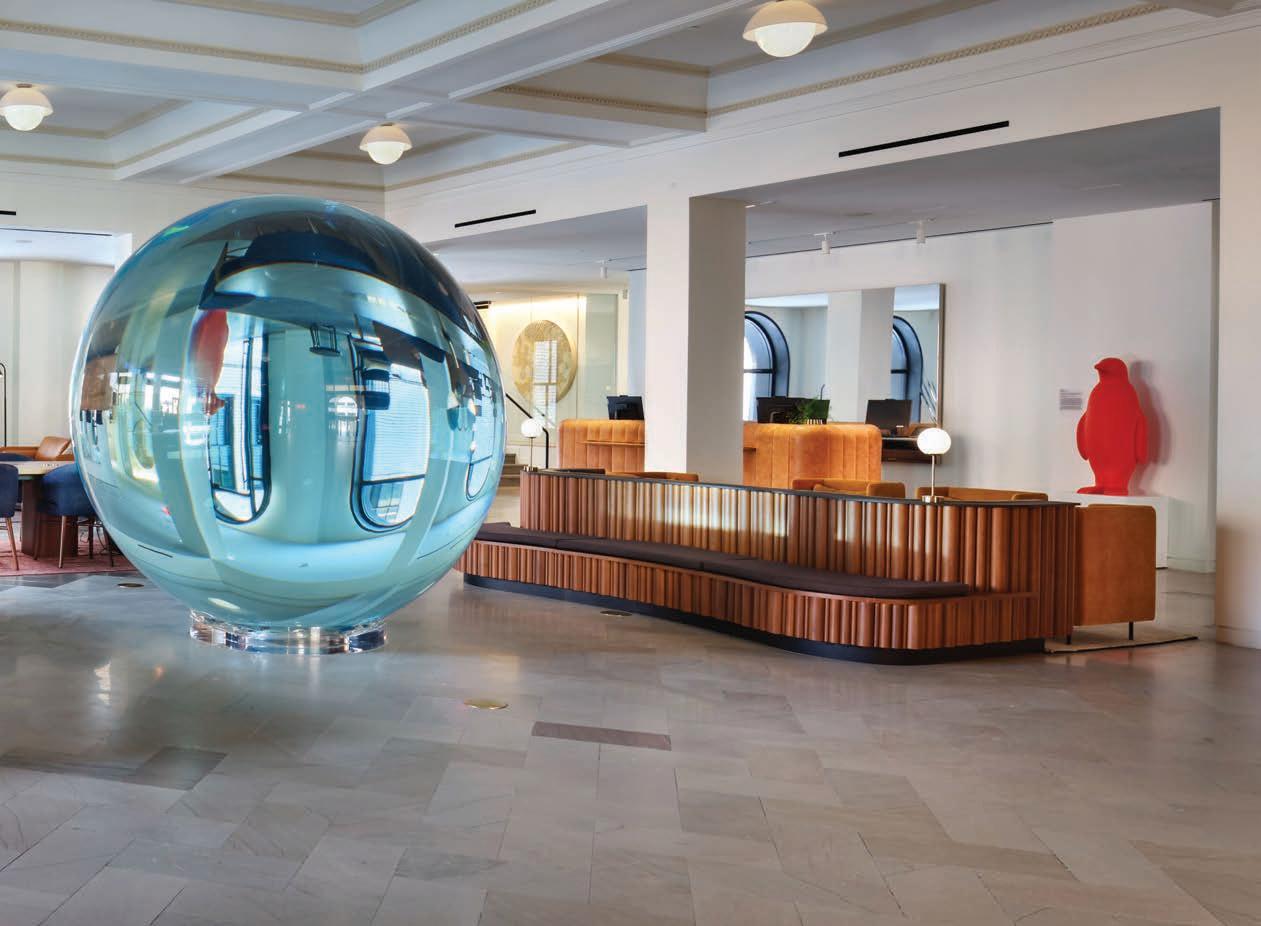

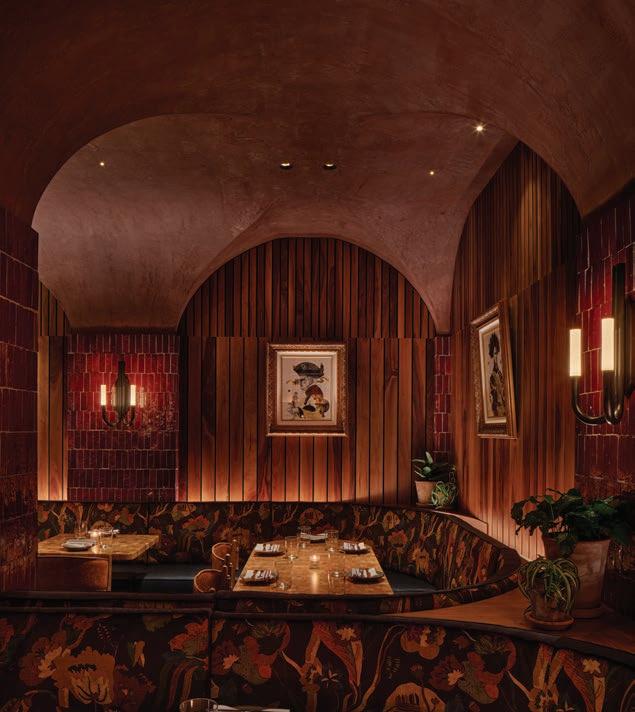
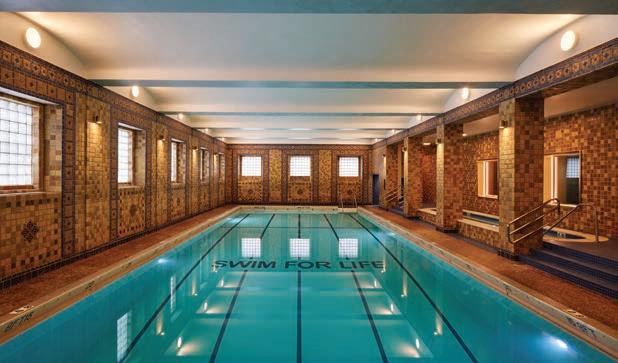
 Facade of 21c Museum Hotel St. Louis in the newly restored YMCA building on 15th and Locust.
Stunning and intimate Idol Wolf restaurant’s main dining room.
Museum’s main gallery in the former YMCA gymnasium
Facade of 21c Museum Hotel St. Louis in the newly restored YMCA building on 15th and Locust.
Stunning and intimate Idol Wolf restaurant’s main dining room.
Museum’s main gallery in the former YMCA gymnasium
The hotel’s restaurants offer culinary experiences that reflect the creativity and innovation found in the art exhibitions. The menus often highlight the connection between art, culture, and community. Inspired by the rich culinary traditions of Spain, the team at Idol Wolf — 21c’s intimate restaurant headed up by Chef Matthew Daughaday — takes a playful approach to tapas-style dining by combining local and seasonal ingredients with classic Mediterranean sensibilities.
Idol Wolf’s pintxos and tapas-style small plates anchor the menu while larger plates influenced by the paellas, seafood, and stews of Northern Spain round it out. Whether a person is dining solo at the bar or at a large table with a flock of friends and family, the menu is designed to be sampled from, with waves of food hitting the table in an exciting fashion that is inspired by the rich culinary traditions of the area.
The restaurant will initially be open for dinner service, with weekend brunch to follow in the coming months. An extensive spirit list will also be available, along with both old and new world cocktails and thoughtfully crafted zero-proof options. Unique sangrias and gin and tonics — prepared with Spanish wines and spirits and seasonal fruit and herbs — pair perfectly with every
dish and serve as an added bonus to the global wine program, which places heavy emphasis on Spanish varietals.
Idol Wolf will feature indoor and outdoor seating for over 100 guests plus a 14-person private dining area, as well as a lounge area, bar, and billiards room. The contemporary space is a feast for the eyes thanks to décor touches which fuse naturally into 21c Museum Hotel St. Louis’ art-influenced vibe and communityfocused cultural programming. From the historic lobby, Idol Wolf lures one in with graduating levels of immersion — from the double height naturally lit bar to the intimate firelit private dining room with deeper infusions of color. Materiality, tones, and textures are inspired by flamenco dancing, horseback riding, and the tapas culture found throughout Spanish heritage.
“We are thrilled to bring our love of Spanish cuisine to St. Louis, where travelers and locals can come together to enjoy food and beverages that spark conversation and create connection,” says Chef Daughaday, who is known throughout the city for his culinary work at Reeds American Table and Juniper. “Idol Wolf will add breadth to the roster of outstanding dining available in St. Louis while speaking to the city’s history, and we are thrilled to be throwing open our doors to this wonderful community.”

A second restaurant, Good Press, was designed to be a hub for hotel guests and downtown residents alike. Breakfast and lunch will be served daily and seating will be available in both the café and library. By utilizing local roasters, growers, and purveyors like St. Louis-based Big Heart Tea and Northwest Coffee, Good Press is committed to always putting the best of what the city has to offer front and center. Whether quickly fueling up in the morning or setting up shop for the afternoon, customers can expect to find great coffee, simple food, and the ambient buzz of community. Dylan Rauhoff and Chef Daughaday will oversee both concepts as Director of Food & Beverage and Executive Chef respectively. They are joined by Chef de Cuisine Jonathan Duffe, who began his career working for Chef Daughaday at Reeds.
All of the artwork in Idol Wolf, the main restaurant located on the main floor, was made by Carlos Gamez de Francisco. The paintings in the restaurant are ink paintings with some watercolor and graphite.

Over the bar on the south side is another work by Carlos Gamez de Francisco, called “Mind Your Manners II”, and was commissioned for 21c St. Louis. The painting highlights Idol Wolf’s Spanish-inspired cuisine, while paying homage to the history of Missouri. The artist includes a honeybee and bluebird, the State’s official insect and bird; the feathers are included in reference to Native American headdresses, and the figure’s European clothing represents later settlement and control of indigenous populations.
Multiple pairs of contemporary sunglasses suggest the possibility of adopting new and diverse perspectives.
On the north side of the bar is Andy Bultó’s “Garden of Memory II”, which was also commissioned for the space and pays homage to the history and legacy of 21c St. Louis. The use of gold leaf in the painting aligns Bultó’s work with the practices of Old Master European painters, who often used gold leaf to indicate the divinity or status of their subjects. Here, anonymous, everyday people are endowed with significance, while their blurred faces reflect the passage of time and the impermanence of memory.
The next exhibition is “Future Revival: Digging into Yesterday, Planting Tomorrow” featuring artists Myrlande Constant, Jeannette Ehlers, Isaac Julien, Kapwani Kiwanga, Hew Locke, Ebony G. Patterson, Duke Riley, Yinka Shonibare, Hank Willis Thomas, and Kehinde Wiley.
“The intention was always to rotate exhibitions that are curated by our chief curator, Alice Gray Stites, and she works with our founders to plan and organize exhibitions that change out at least on an annual basis,” Molly explains. “So, one of my favorite things about 21c is that when an exhibition changes out, it really transforms the experience. If you came last month and it was one exhibition. Then you come back, it can be completely different. Whereas, a lot of hotels have to wait seven to 10 years for any major refresh or renovation. In our case, the experience evolves with regularity. “
21c goes beyond just hosting exhibitions and events; it actively engages with its surrounding communities. Through partnerships with local artists, schools, and organizations, the museum and hotel foster creativity and collaboration, making a meaningful impact on the cultural fabric of each city it calls home.

Seeing itself as the Impact Hospitality leader is more than marketing speak. 21c hires impact players in virtually every role. Prior to accepting the role as Director of Community Impact at 21c, Christopher Randall was a former marine and law enforcement officer who transitioned to community service in St. Louis, first at the non-profit Gentlemen of Vision and then as the community impact manager at KSDK-TV.
Chris is responsible for diversifying the 21c team and vendors. Rather than purchasing from the big national players, they’re spending money in the community so, “we can make a large impact with local families or local small businesses,” he says.
I asked Chris about overcoming the fear of some guests coming downtown. “It took a multitude of things to create these problems and it’s going to take a multitude of people to create the solutions,” he says. “It can’t fall just on law enforcement. It’s going to take businesses like 21c to create unique solutions. It’s gonna take courageous business leaders to stand the ground and fight, and not to run to outer areas, to the counties, and away from the city.
“The opportunities to see some of the art and some of the displays that we’re going to have within our museum, we’re going to be an attraction for St. Louis,” Chris continues. “And so that’s naturally going to bring people downtown. The impact work will also bring, attention to our property that the average hotel just doesn’t have the opportunity to engage in such an intentional way. I have faith and confidence that our offerings from the restaurant to the coffee, to the gym, and, of course, the art are going to bring people who haven’t been downtown in years.”
And it all goes back to the organization and its focus on youth empowerment, and racial and social equity. This is part of 21c’s continuous give back and impact. Where other places might just do this for a month or might just do it for a week, at 21c this goes all day long, all year long.
The 21c Museum and Hotel has emerged as a pioneer in the world of contemporary art, redefining the way we experience culture and hospitality. Its innovative approach to merging art with exceptional accommodations has captivated visitors and art enthusiasts from around the globe. Through its thought-provoking exhibitions, immersive installations, and luxurious amenities, 21c continues to shape the cultural landscape of cities, leaving an indelible mark on the art world. Whether you are a seasoned art aficionado or a curious traveler, a visit to 21c promises an unforgettable experience where art and hospitality intertwine in perfect harmony. sl


Having grown up in a first-generation immigrant family, I know what that’s like and the expectations that come with it. Education comes first, then hard work, take nothing for granted, and stay humble. Foye Oluokun and his brother, Fade, are first-generation Americans (born to Nigerian immigrants) who are smart, extremely hard working, and despite their football player statures, are as soft spoken as they come. Foye recalls, “My mom worked most nights
and my dad worked out of town for most of my childhood. So, my brother and I were motivated by seeing what our parents were doing to give us the opportunity to succeed. If we didn’t do what needed to be done while our parents were off working, we would be disciplined. We understood that our parents sacrificed so much that we couldn’t let that go to waste. It’s kind of our family’s goal for my brother and I to succeed and we see it as our duty.

“My parents set the standard for me early not to accept mediocrity,” Foye continues. “I really don’t like failing. But sometimes you have to fail; you have to learn when you fail. You just can’t fail twice. Like if we got a C on a test, we knew we were not going to ever get a C in the class.”
Today Foye plays linebacker for the Jacksonville Jaguars; he recently signed a new contract for $45 million for the next three years. Did that go to his head? Hardly. In the offseason, Foye interned in the front office for the Brooklyn Nets to get experience and, when he can no longer play professional football, a leg up for a job one day on a professional sports team. The truth is, Foye is an excellent basketball player, and while in high school at John Burroughs in St. Louis, he thought his future may involve a basketball rather than a football.


Before Foye dreamed of professional sports — or sports of any kind — he was — and still is — a student. In high school, he earned top grades and was highly regarded by his classmates and teachers. It came as no surprise to anyone when he went to Yale University. Foye always had a goal to go Ivy and he did it with flying colors.
“In high school, I was just trying to become some finance guy and someday invest in businesses,” he says. “That’s all I thought about. I was pretty good at math and I liked learning about what I read about. My parents were pretty strict growing up, so just getting the grades was the goal of high school. I was always told, ‘Just get the right grades and you can get into whatever school you want.’”
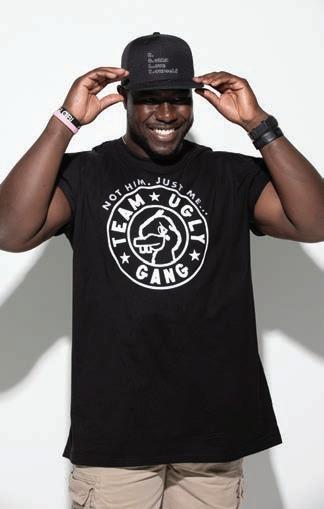
While at Yale, Foye received As and an occasional B, all while playing four years of D-1 athletics. Each year he seemed to grow in size and stature, always exceeding his coaches’ expectations. He moved from playing cornerback to safety, and eventually to linebacker, all while quietly breaking Ivy League records. If you didn’t know Foye or watch the Yale Bulldogs each week, you may have missed his brilliant performances because he didn’t always get the recognition some of the other players received. But he quietly and humbly worked hard, pushed himself, and by the time he was a senior he won All Team Ivy and Defensive Player of the Week on
multiple occasions after racking up hundreds of tackles, fumble recoveries, and interceptions throughout his career.
Many coaches and recruiters didn’t give Foye much of a chance to play at the professional level. Few Ivy Leaguers do. He was never scouted even though he was breaking records; he wasn’t really encouraged to pursue a professional sports career, and he certainly was never recruited by the pros or invited to the NFL Combine. One day things changed.
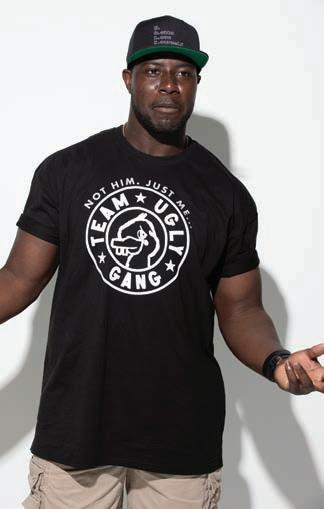
When he was wondering if he should retire from the sport after his senior year at Yale, Foye called his high school football coach, who happened to be Pro Bowl quarterback Gus Frerotte, to ask for advice. Gus, who was head coach for two seasons at John Burroughs and led the team to two state championship appearances, had been watching Foye at Yale. He encouraged him to assemble a highlight reel and send it to him as soon as possible. Gus shared it with friends in the NFL and before long, Foye became a prospect. But before any team was ready to recruit him, Gus told Foye that he had to get bigger, faster, and stronger to play in the NFL.
Foye vividly remembers that day when the opportunity to continue playing was reignited. But the trainer Frerotte recommended was in Denver and he fetched a high price to take on promising young athletes. Foye couldn’t afford the cost of entry. His peewee football coach and booster, Manne Palan, placed some calls to other Burroughs parents and before long, Foye had the resources to train with Loren Landow and spent 3 months in Denver before a try out at the Fordham University senior pro day.
“Gus sent my tape to Landow, who is now the head strength and conditioning coach for the Denver Broncos and who is known for training athletes for their pro day and combines,” Foye says. “He trained a lot of the Denver Broncos who in their offseason would stay in town just to train with him. He trained Chris McCaffrey since he was little and he killed his combine. Landow’s world-renowned. People come to him for advice all the time. And
he looked at my tape. They’d already started their session but he said, ‘This guy (Foye) has a legit chance.’”
It’s not easy making it to the pros, but for someone who played in high school in the shadows of Ezekiel Elliot who was a five-star recruit at Ohio State University and then star running back for the Dallas Cowboys, someone other than Foye would have given up. He easily could have figured out that his high GPA in finance from Yale would have been a surefire road to success on Wall Street. But Foye continued to dream big in his own firstgeneration kind of way and always stayed committed to his goals.
Foye’s first NFL opportunity came when the Atlanta Falcons drafted him in the sixth round of the 2018 draft. At first, he played on special teams but didn’t start. He quickly established himself as a reliable and hardworking player, earning a starting role later in his rookie season. Oluokun’s ability to both read offenses and make tackles earned him respect from his teammates and coaches.
After four seasons with the Falcons, Foye became a free agent in 2021 and caught the attention of the Jacksonville Jaguars. The team recognized his potential and signed him to a contract. It didn’t take long for Oluokun to make an impact in his new jersey, quickly becoming a key contributor on the field.
One of the standout qualities of Foye is his versatility. He is equally proficient in pass coverage and run defense. His speed and agility allow him to cover tight ends and running backs effectively, while his strength and tackling ability make him a force to be reckoned with against the run. He has a natural instinct for finding the ball carriers and bringing them down with authority.
In addition to his physical abilities, Foye is also known for his intelligence and football IQ. His experience as a safety in college gives him a unique perspective on the game, allowing him to make quick decisions and react to plays effectively. His ability to anticipate and diagnose plays is what sets him apart from other linebackers in the league.

Foye continues to impress with his consistent performance and leadership skills. He has become an integral part of the
Jacksonville Jaguars’ defense, not only leading the team in tackles and demonstrating his ability to make game-changing plays, but he is also the leading tackler in the NFL. His passion for the game, coupled with his exceptional talent, makes him an exciting player to watch. He is also one of the team captains.
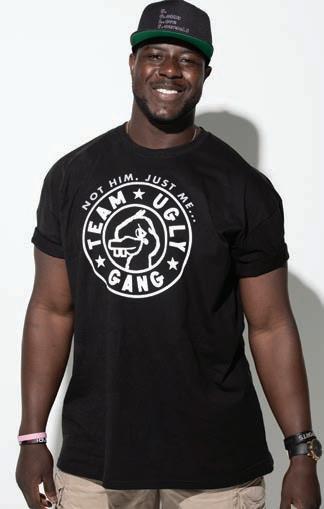


Off the field, Foye is also making a positive impact. He actively engages in community service and was awarded the NFLPA Community MVP in 2020 for his work with the Atlanta Falcons Youth Foundation and his efforts in promoting literacy in underserved communities. Foye’s dedication to giving back shows his commitment to making a difference both on and off the field.
When he’s back in St. Louis, Foye always takes time out to meet with the Burroughs students and players, and volunteers his time and treasure to Lift for Life, which he supports as much as he can.
Things that would have disheartened other people have always made Foye stronger. He remembers in college when some other students called him ugly.
“So, I reached out to my six best friends and said, ‘Let’s call ourselves the Ugly Gang’,” Foye says. “No matter how I look, forget about trying to be the prettiest person on the block. Use those experiences to promote confidence in yourself. Now I say, if you’re not confident in calling yourself ugly and being confident in whatever your appearance is, you can’t be part of the Ugly Gang which now stands for: U Gotta Love Yourself.” U.G.L.Y. has quickly become Foye’s platform for community outreach to kids and a brand which other players are wearing to promote the message of self-confidence.
Foye and the entire Oluokun family are one in a million. They are great examples of superior parenting, respectful kids, hardworking members of the community, and always doing what is right. For me, they are a reminder that growing up in an immigrant family has the potential to be a real advantage. If you ever have a chance to meet Foye, his radiant smile and personality will speak volumes about his character and his journey as an extraordinary person who is proud to call St. Louis home. sl
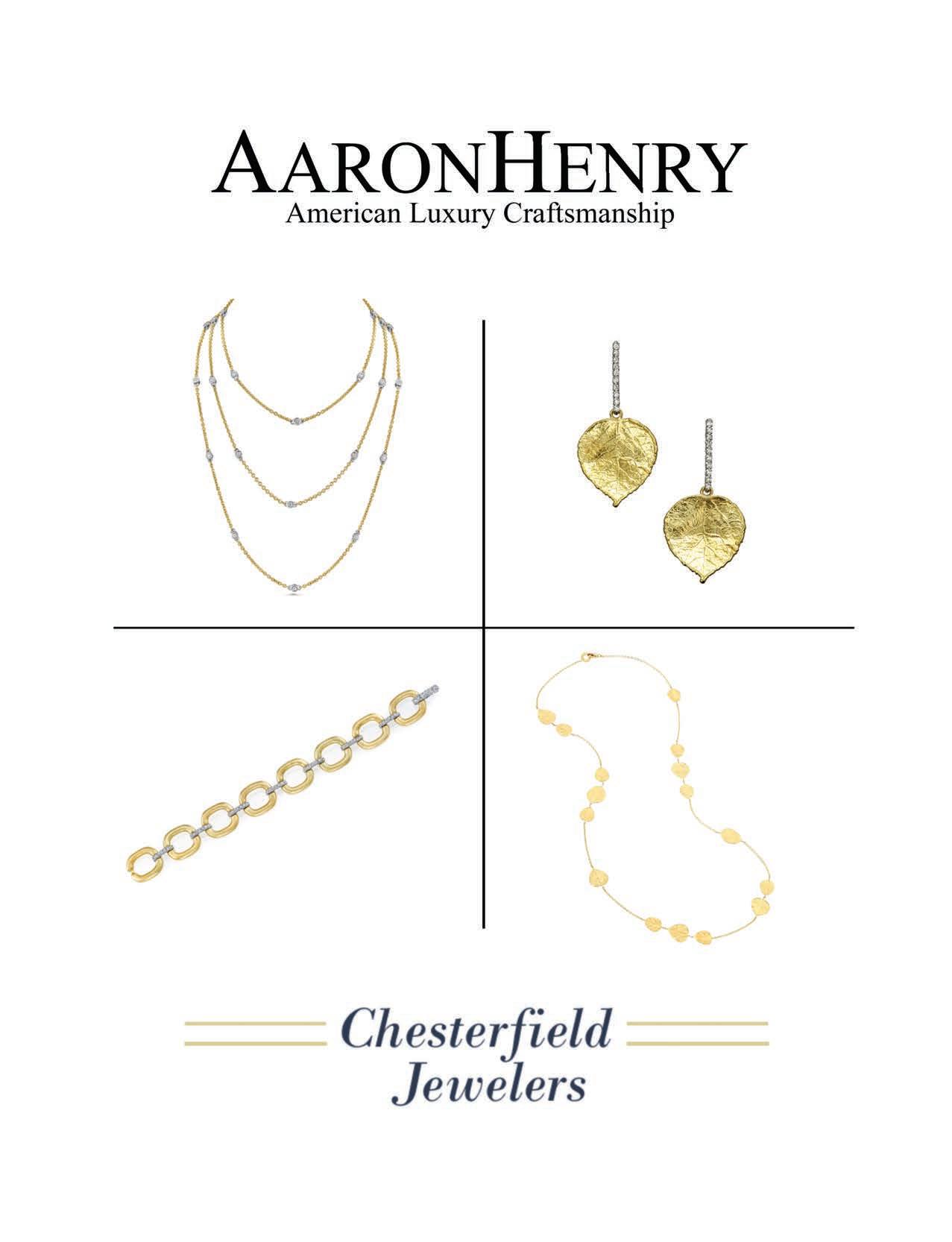



In September, the eyes of the interior design world collectively cast its discerning gaze on Paris for the Maison&Objet show and Paris Design Week. With Vivant, Vivants, which translates to 'alive, living' as the theme of the fourth edition of Paris Design Week and "quest of pleasures," the stated mission of Maison&Objet's fall edition, we're singling out a pair of designers who embody these concepts by marrying an adherence to time-honored techniques with forward-looking idealism.
Franco-Swedish and a École Nationale Supérieure d'Architecture de Paris-La Villette graduate, Bina Baitel is both an architect and a designer. Baitel's youth in the Middle East imbues her work with multiple influences, enabling her to explore the question of cultural interpenetration on formal, functional, and symbolic levels.
After founding her design and architecture studio in Paris in 2006, Baitel's creations have made their way into museums and international fairs (Milan, Dubai, Paris, New York, Venice, Basel) and

have been snatched up for public and private permanent collections. At Paris Design Week, she will unveil the Bina Baitel Collection, showcasing 30 pieces characterized by an invitation to contemplative and interactive experiences.
Baitel says that each piece, developed through proprietary manufacturing processes and technologies in collaboration with the finest artisans in Europe, “tells a story materialized through a dedicated plastic expression, generating new typologies of objects.” The designer prompts us to question our relationships and interactions with the things surrounding us while she explores their common codes to propose concepts with strong inspirations. Her innovations include a lamp made entirely of flesh-colored leather, an interactive circular wall light ringed with fur, a stool inspired by the world of haute joaillerie, and a sofa inspired by the fluidity of maritime landscapes. These highquality creations express the artist's embrace of a constant dialogue between traditional craftsmanship and innovative experimentation.
Parisian designers and artisans Franck Genser and Bina Baitel employ a transdisciplinary approach to bring elegant and exciting interiors to life.Architect and designer Bina Baitel.


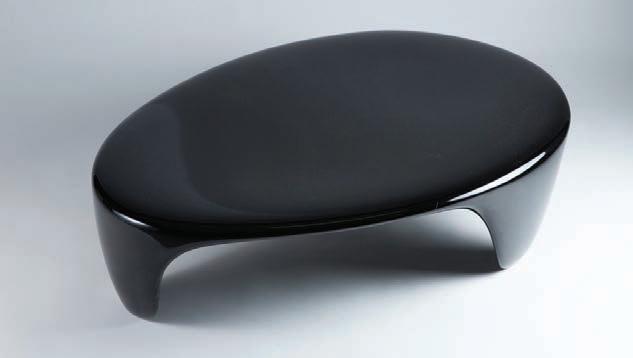


 Photo of Franck Genser by Vincent Leroux.
Furnishings from Bina Baitel’s new 30-piece collection.
Photo by Didier Delmas.
Fur-Light, by Bina Baitel is an interactive luminaire. Its sensitive fur, embedded with invisible sensors, reacts to the user's caresses to turn on and adjust the light as desired.
The PAD Lamp from Bina Baitel is made entirely of flesh-colored leather.
Photo by Florian Klein.
The Naïa sofa by Bina Baitel.
Photo by Stéphan Briolant
Photo of Franck Genser by Vincent Leroux.
Furnishings from Bina Baitel’s new 30-piece collection.
Photo by Didier Delmas.
Fur-Light, by Bina Baitel is an interactive luminaire. Its sensitive fur, embedded with invisible sensors, reacts to the user's caresses to turn on and adjust the light as desired.
The PAD Lamp from Bina Baitel is made entirely of flesh-colored leather.
Photo by Florian Klein.
The Naïa sofa by Bina Baitel.
Photo by Stéphan Briolant
Since 2015, Franck Genser, an engineer-turned-entrepreneur, has turned out extraordinary pieces from his Paris atelier. Cabinetmaking, tapestry, art foundry, and alabaster work are among the skillsets he calls upon to breathe life into his sculptural pieces, combining exceptional craftsmanship with timeless elegance. As a Gestalt therapist (a form of psychotherapy that emphasizes personal responsibility and focuses on the individual's experience in the present moment), Genser says he remains fascinated by the essence of objects, their impact on individuals, and the constant interaction between humans and their environment.
At the heart of the Franck Genser workshop, the art of lacquer takes center stage, inspired by his extensive journeys and encounters with gifted artists. Among them, the revered lacquer master Nagatoshi Onishi profoundly impacted Franck Genser's work. Fueled by infinite patience and an unwavering quest for perfection, Onishi's influence is unmistakably evident in Genser's exquisite creations.Among these exceptional works, the Onishi coffee table is a testament to the rich legacy of Japanese vegetable lacquer. Painstakingly crafted using the Urusgi technique, the table undergoes more than 24 meticulous lacquering stages, each separated by precise sanding to achieve an impeccable finish. The result is a masterpiece that boasts sleek lines, sophistication, and a profound tribute to the art of Japanese lacquerwork.
Woodworking is another of Gesner's cherished traditions, bringing forth remarkable pieces that embody the essence of exceptional furniture. Under the skilled hands of master craftsmen,
rough wood transforms into exquisitely curved forms, reflecting the designer's vision. Merging the best of modernity and tradition, the iconic Décision chair, inspired by Émile-Jacques Ruhlmann, a French furniture designer and interior decorator who was one of the most influential figures in the Art Deco movement, balances two finely sculpted solid American walnut volumes with four elegantly designed legs.
An ongoing affinity for the delicate art of alabaster and Ruhlmann's legacy prompts Genser's team to hand-select some of these precious stones from the same deposit once mined by Ruhlmann in the 1920s. The workshop's Toutaime lamp enhances alabaster's natural transparency and facets while bathing interiors in a soft, diffused light.
The Piscine coffee table is a key piece in the atelier's table collection that demonstrates the workshop's skill in bronze with a whimsical touch. The table's ladder-like base is waxed brass, while the deep blue bronze tabletop is achieved through the hot patina technique.
Looking to the future by taking innovation to new heights, Gesner's studio is a pioneer in fusing traditional craftsmanship with cutting-edge technology. Engineers within the workshop focus on robotics projects, giving rise to imaginative creations, from touch-activated lamps to dome-shaped wall screens and even a serving droid for champagne glasses and bottles. Gesner says that these technical innovations, combined with human artistry and inspiration from his imagination, will continue to result in functional, artistic, and emotional furniture pieces. sl

Porsche Commemorates the 60th Anniversary of the 911 with the 911 S/T
 Written by Andre James / Photography courtesy of Porsche Cars NA
Written by Andre James / Photography courtesy of Porsche Cars NA
Porsche is celebrating the 60th anniversary of the 911 with a special edition built for maximum driving enjoyment. With a limited run of 1,963 examples, the Porsche 911 S/T offers a lightweight design and a purist driving experience. An optional Heritage Design Package, which will appeal to Porsche collectors and those with an affinity for nostalgia, draws inspiration from the racing version of the 911 S from the late 1960s and early 1970s.
As the name identifies, the 911 S/T is the descendant of a particularly performance-focused version of the first 911 generation. From 1969, Porsche offered a special race version of the 911 S, internally called the 911 ST. Modifications to the chassis, wheels, engine, and body significantly improved acceleration, braking, traction, and cornering grip. Large spoilers and other aerodynamic aids were not yet used in these models. The new 911 S/T takes up the spirit of the original 911 S (ST) and transfers it to the current model generation.
Weighing in at just 3,056 pounds, this exclusive model, the lightest of the 992 generation, unites the strengths of the 911 GT3 with Touring Package and the 911 GT3 RS to deliver a unique combination of agility and driving dynamics. For the first time, it combines the naturally aspirated, 386 kW (525 PS) 4.0-liter high-revving boxer engine from the 911 GT3 RS with a manual gearbox and lightweight clutch. The compelling soundscape of the standard lightweight Sport Exhaust system heightens the exhilarating driving experience.
The 911 S/T's particularly nimble and agile handling, designed for maximum driving enjoyment on winding country roads, reflects a focus on GT and motorsport expertise. Unlike the 911 GT3 RS, the direction of the development of the 911 S/T has been not on track use but rather for journeys on public roads. Every steering
movement and every ounce of pressure on the accelerator or brake is implemented immediately and precisely. The 911 S/T is the only 911 of the current generation to combine a double-wishbone front-axle design with a multi-link rear axle without rear-axle steering.
Among other measures, the 911 S/T achieves its particularly agile and direct handling through consistent lightweight design. The hood, roof, front fenders, and doors, with their striking inlets, are made of carbon fiber reinforced plastic (CFRP), as are the rear axle anti-roll bar and shear panel (stiffening element on the rear axle).
Porsche also fits the anniversary model with magnesium wheels, the Porsche Ceramic Composite Brake (PCCB) system, a lithium-ion starter battery, and lightweight glass, all as standard.
A new exterior color, Shore Blue Metallic, and Ceramica wheel rim color are exclusive to the optional Heritage Design package. Upon request, a starting number from 0 to 99 and decorative foil can be applied to the doors. The classic-style Porsche crest from the original 911 that adorns the front, the center caps of the wheels, the steering wheel, the headrests, and the car key underscores the historical roots of the 911 S/T. The interior also features cloth seat centers in Classic Cognac with black pinstripes, which are another homage to heritage. Two-tone semi-aniline leather trim in Black/ Classic Cognac with extensive leather surrounds, a roof lining in perforated Dinamica, and other elements from Porsche Exclusive Manufacture round out the package. The Porsche logo and the 911 S/T model designation on the car's rear are in gold.
The new Porsche 911 S/T carries an MSRP of $290,000, excluding $1,650 for delivery, processing and handling. U.S. deliveries are expected to begin in Spring 2024. sl






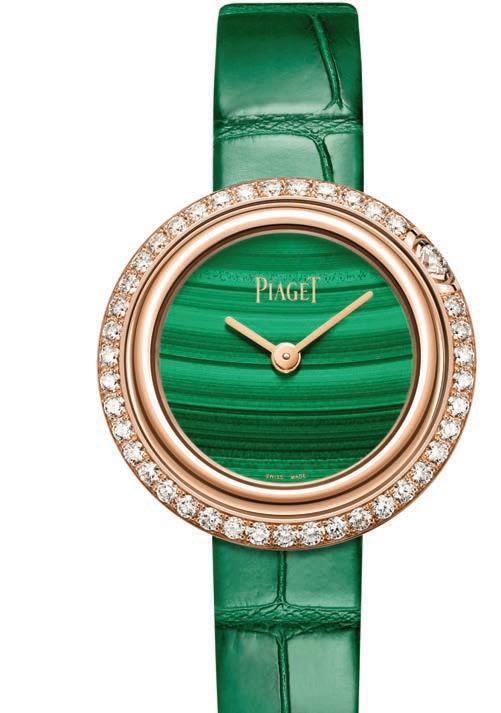


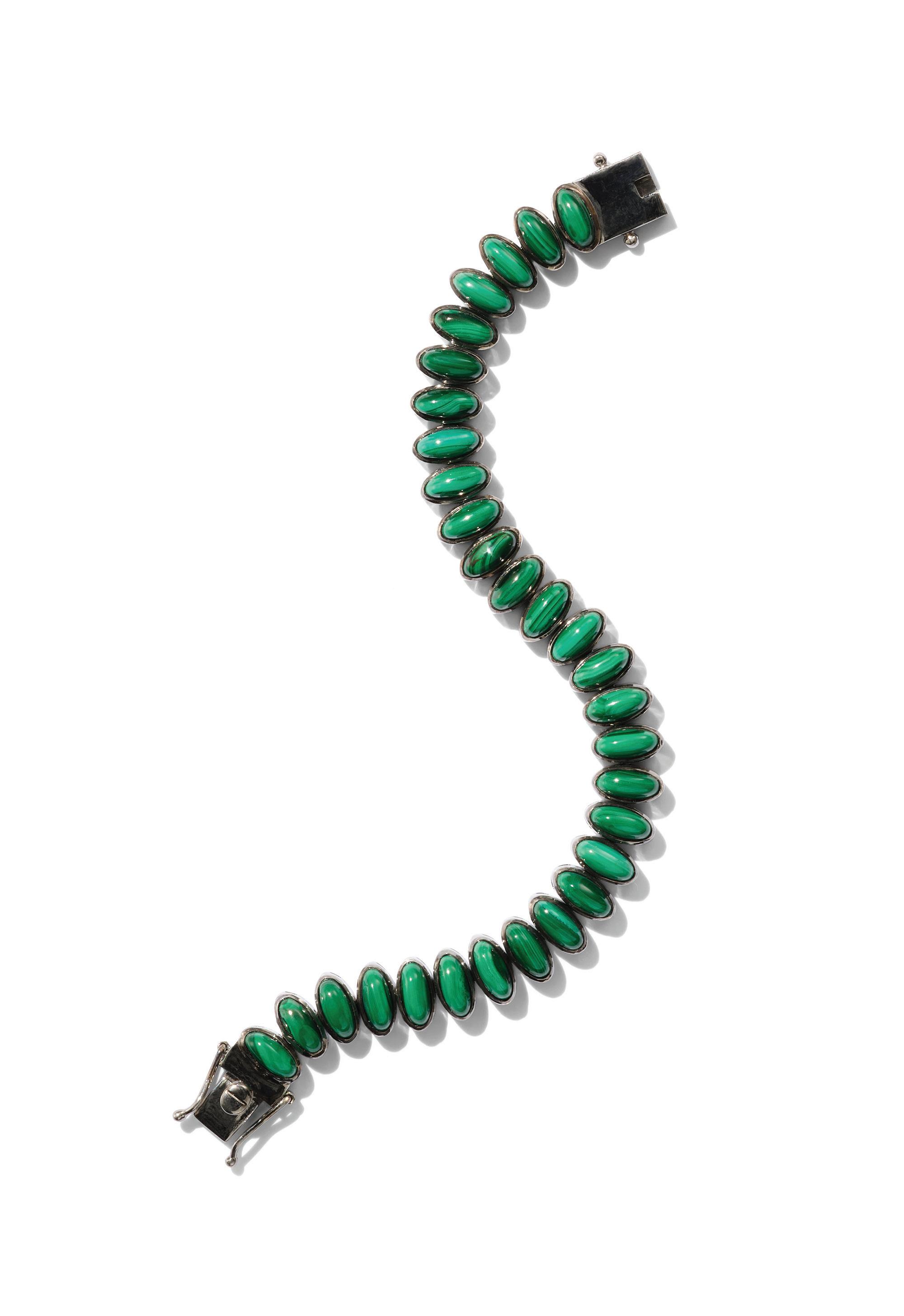 Compiled by Bridget Williams
Compiled by Bridget Williams
Kavant & Sharart Talay Wave Flow earrings ($3,260; kavantandsharart.com). 70s bangle from Jenna Blake ($23,200; jennablake.com). Pebbles






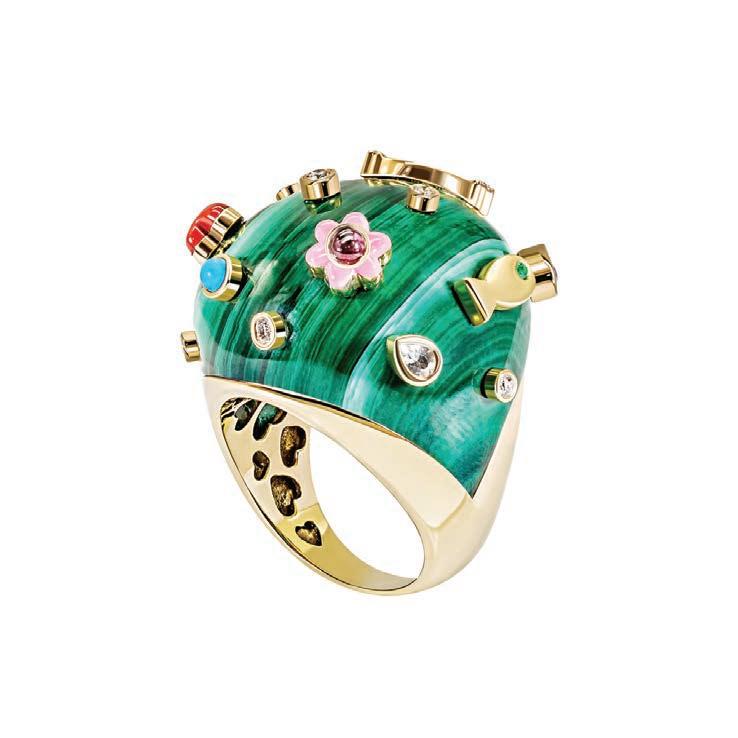
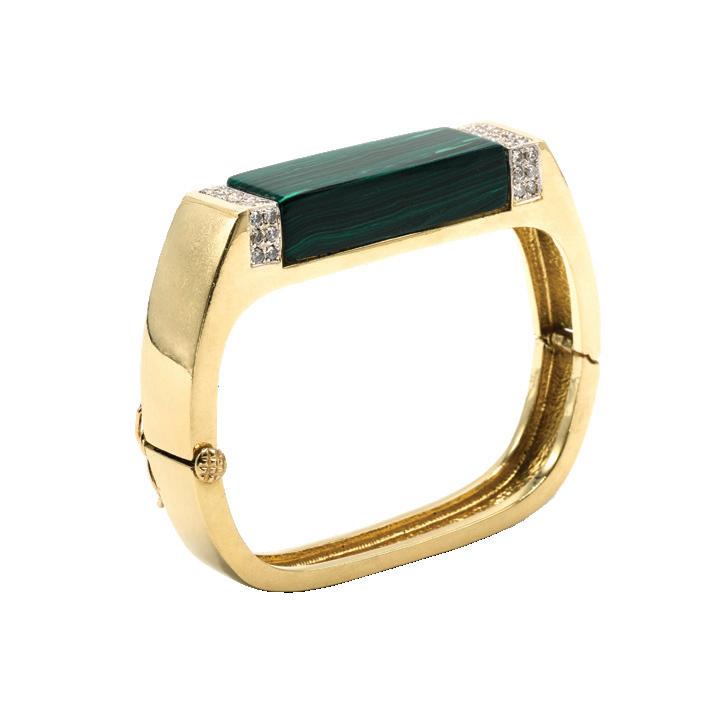





 Compiled by Bridget Williams
Compiled by Bridget Williams
MAREI New York Alexandria tassel earrings ($4,000; mareinewyork.com). Alison MacLeod Catkin Gossamer Web Earrings ($3,676; alisonmacleod.com). Nikos Koulis Jewels Together earrings (nikoskoulis.com). Reza Corne D’Abondance earrings ($256,000; worldofreza.com). Sia Taylor Sunrise earrings ($6,000 siataylor.com).




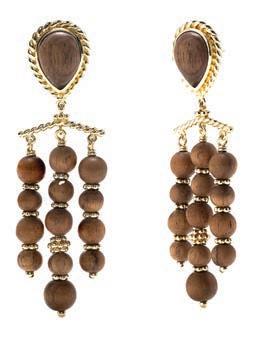









"If you want to really get away from it all where no one can find you, then you're heading to the right place," remarked my Uber driver as we set off from the terminal at the Savannah airport to the private embarkation dock on Hilton Head to catch one of 18 daily round-trip ferries to Daufuskie Island's Haig Point. A strict no phones policy inside the ferry boat for the duration of the 30-minute voyage helped ease me into a more chill state of mind and make my acquaintance with the first of many locals who were all quick to extol the benefits of living in the car-free development.
The architecturally unique array of homes, cottages, and townhomes within Haig Point (boasting some of the highest average home prices in South Carolina) are carefully positioned among 1,100 acres on Daufuskie Island, a mixture of waterfront, woods, and manicured golf greens that are bordered by the Atlantic Ocean, Caliboque Sound, and the Cooper River. From Haig Point's 150-year-old Lighthouse, you can spy Hilton Head's red-and-whitestriped Harbour Town Lighthouse (an eight-minute boat ride away).
With a fascinating history of human habitation dating back 9,000 years, the entirety of Daufuskie Island, whose name comes from the Muscogee language, meaning "sharp feather," has been named to the National Register of Historic Places. Spain claimed the Island in 1521 and enlisted the Native American population to fight off advances by the French and Scotts. Daufuskie's "Bloody
Point" is named after a trio of brutal battles between 1715-1717. Occupied by Union soldiers during the Civil War, the Gullah people (freed enslaved people) returned to work in the oyster and timber industries. The Gullah population of 2,000 dwindled to roughly 60 after the Island's economy gradually declined. Still, Daufuskie's remoteness allowed the language and customs of the Gullah people to remain well-preserved.
Since the beginning, Haig Point has been committed to the preservation of the Island's history. After purchasing the land in the 1980s, the original developers hired an archaeologist and historical architect to locate and restore sensitive sites. In conjunction with the Daufuskie Island Historical Foundation, in 2014, Haig Point, whose ownership was transferred to the members in 2001, restored a trio of former slave quarters dating back to the 1820s. Located near the ferry dock and the Strachan Mansion, a circa 1910 home barged to the site from St. Simon's Island in 1986, the ruins are a fine example of Tabby homes, a building material comprised of burned oyster shells, lime, sand, and water. Careful attention has also been given to preserving "Constitution Trees," massive twohundred-year-old Southern Live Oaks surrounding a fountain and dwarfing the 40-foot tower of the nearby Lighthouse. The tree's graceful, outstretched branches, festooned with resurrection ferns and Spanish moss, recall Charleston's famous Angel Oak.
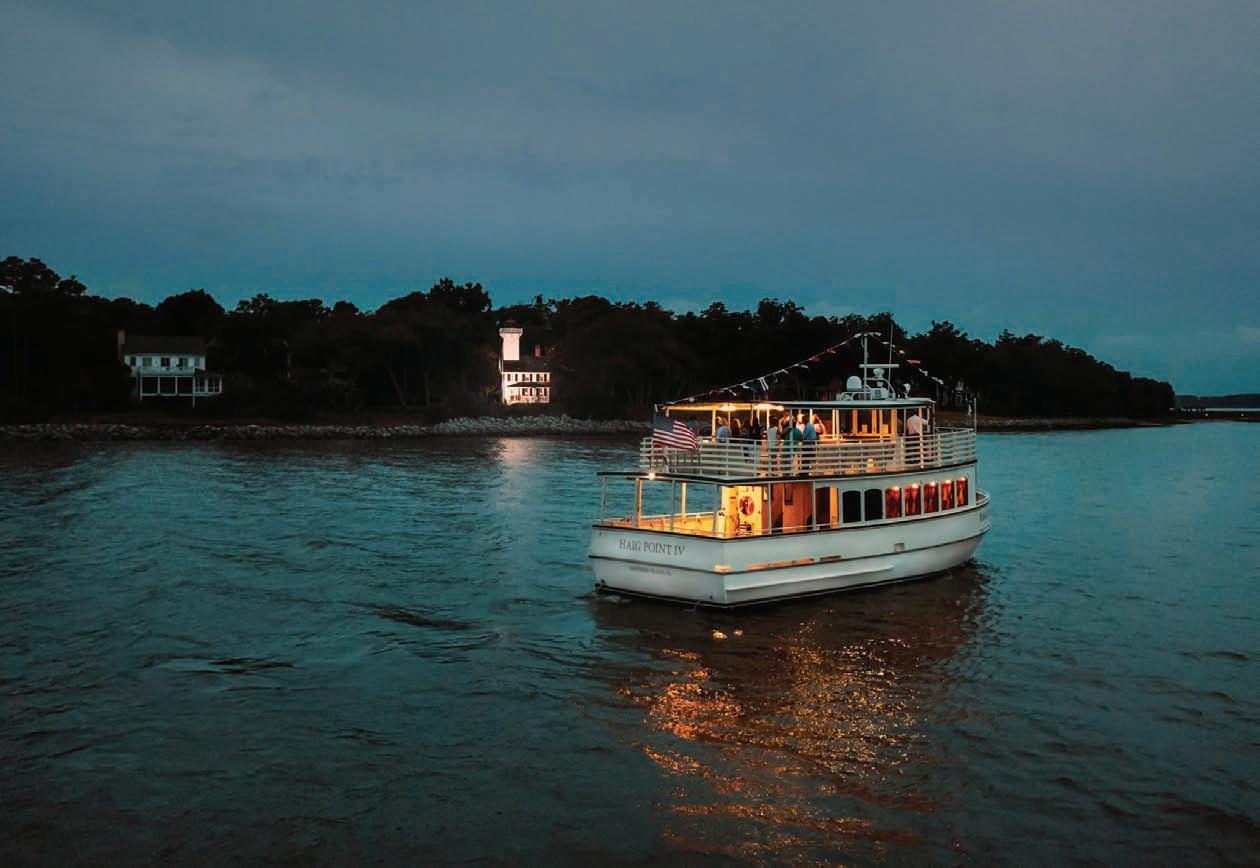
Haig Point is easy to define by what's missing, and how that enhances life in the Lowcountry.



 Haig Point's 150-year-old Lighthouse
The Strachan Mansion is a circa 1910 home that was barged to Haig Point from St. Simon's Island in 1986.
Haig Point's 150-year-old Lighthouse
The Strachan Mansion is a circa 1910 home that was barged to Haig Point from St. Simon's Island in 1986.
The Strachan Mansion is a hub of community life, with a coffee house, souvenir shop, a small grocery and meeting areas on the first floor and guest accommodations on the second floor. A large waterfront lawn with croquet and bocce areas is also a popular site for wedding receptions and special events. The Haig Point Club facilitates a strong sense of community, and homeowners are offered two levels of membership: the highest tier provides unlimited access to 29 holes of golf. Designed by Rees Jones, the 20-hole, par 72, 7,380-yard Signature Course has made Golf Magazine's list of "Top 100 in the World." For those new to the game or don't want to commit to a full day of play, the par 36 9-hole Osprey course is an ideal option.
Tennis pro Ron Gwyn provides regular clinics at the Haig Point Tennis and Pickleball Center, which has received an Outstanding Facility award from the USTA. Two of the six HarTru® courts are lighted, and the site plays host to the Daufuskie Island Adult Championships, featuring amateur play for men and women in both singles and doubles, with divisions for adults aged 35 and older.
Adjacent to the tennis center, a large fitness center overlooks a five-lane lap pool reserved for adults. The Beach Club at Calibogue Club, which overlooks the beaches of Calibogue Sound, is the site of a second family-oriented pool.
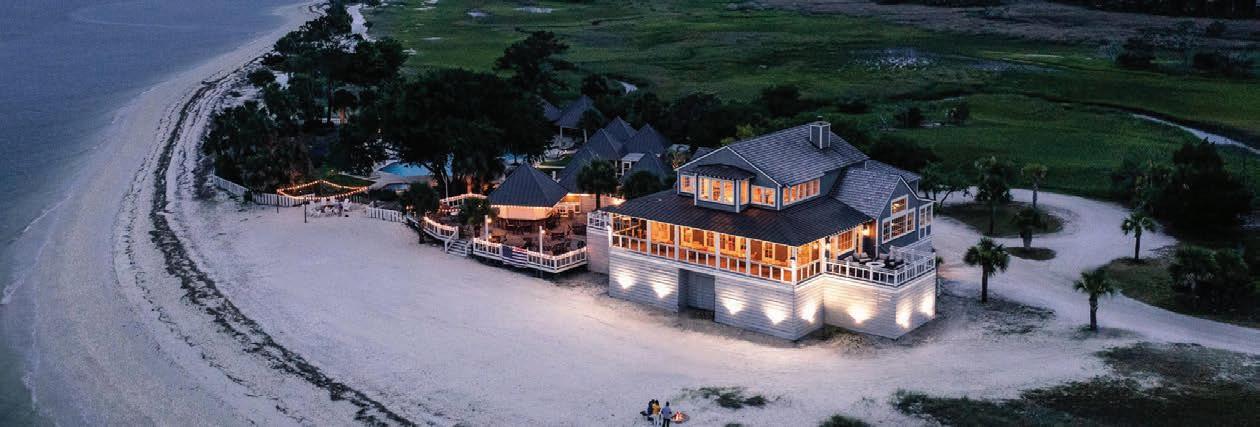
A private equestrian center with a 12-stall barn supported by an accomplished team of equestrians offers members every service from grooming and boarding to lessons and trail rides.
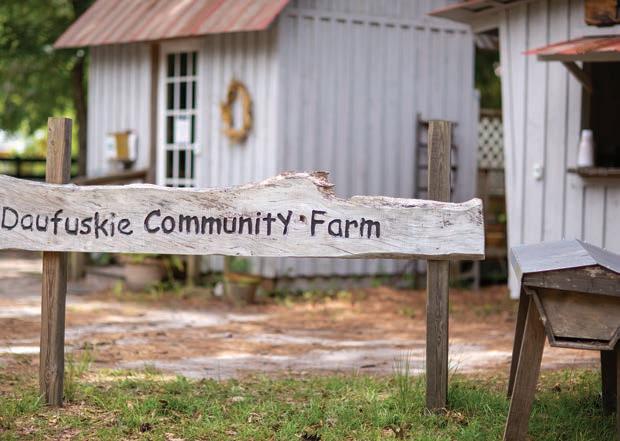
With no grocery store on the Island, I'd be tempted to rely on the culinary team at Haig Point's various dining options for sustenance. Sourcing locally from land and sea, the dining outlets offer everything from elevated Lowcountry fare to tried-and-true favorites to satisfy even the finickiest eater. Even though I was visiting solo, in the spirit of Southern hospitality, I never dined alone as current homeowners invited me to join them each meal. Everyone seemed genuinely interested in knowing what brought me to the Island and sharing the unique path to what drew them there.
However, even with all the human-made amenities, I quickly found that my favorites were those offered by Mother Nature. Early risers who take to traversing the one-mile-long Beach Road are rewarded with spectacular sunrises. Low tide provides DIY oyster harvesting and sand dollar gathering. Constant coastal breezes are ideal for kite flying.
Between 500-600 people live on Daufuskie Island full-time. Outside the gates of Haig Point lies a tight-knit and surprisingly rich and resourceful cultural community. Tour Daufuskie (tourdaufuskie.com) offers a guided History & Artisans tour led by an island resident, providing a historical overview and a fascinating
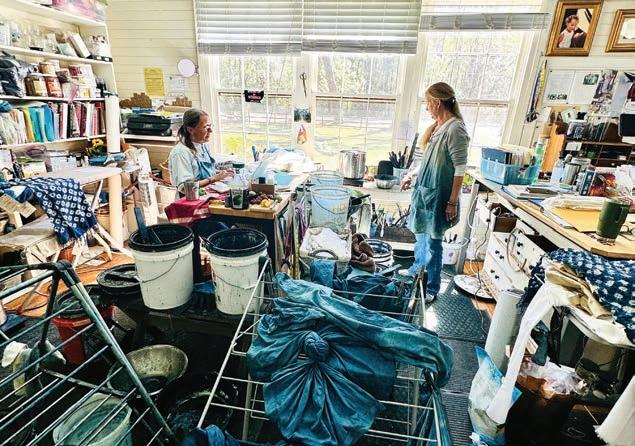 The Calibogue Club at dusk.
The Daufuskie Community Farm is committed to bringing sustainable and organic farming to the island.
The Calibogue Club at dusk.
The Daufuskie Community Farm is committed to bringing sustainable and organic farming to the island.
insight into what it's like to live in a teeny, isolated town. We ogled the quirky artworks at Iron Fish Gallery & Studio (ironfishart.com), where customers pay on an “honor system” and learned how the beautiful natural indigo-dyed textiles are made at Daufuskie Blues (daufuskieblues.com), which operates out of the Maryfields School, made famous by Pat Conroy in his book, The Water is Wide Always keen to converse with a fellow Kentuckian, I hopped on a beachcruiser to visit Daufuskie Island Distillery (daufuskierum.com). Tony Chase, a long-time resident of the Bluegrass and a former pharmacist, perfectionist, and serial entrepreneur, retired to Haig Point with his wife Christy, only to "unretire" a few years later by opening a distillery on a 12.5acre site in 2015. Obsessed with quality and being as hyper-local as possible, the business launched with 54 barrels of rum and has since added flavored vodkas and rums, infused simple syrups and ready-to-drink cocktails. At the time of my visit, several barrels of bourbon were aging in the warehouse, created using a mashbill recipe shared by legendary distiller Lincoln Henderson. In a nod to Kentucky's claim that there are more barrels of bourbon aging than people, Chase remarked that he'll have a far easier time reaching that mark on Daufuskie, where bourbon ages differently due to the climate. "There's no cold season to stall the aging, so a four-year aged bourbon tastes like an eight-year," Chase explained.

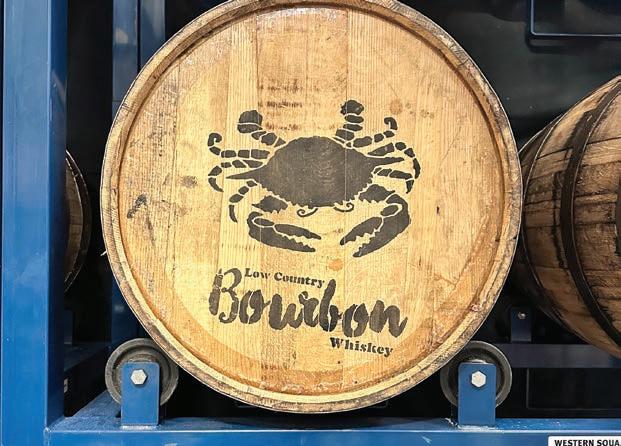
Hugely successful from the get-go, Chase has added a food truck, serving as many as 200 "smash burgers" on their busiest days. For the high-octane entrepreneur who has owned 61 different companies, Daufuskie's business environment is a horse of a different color. Staffing and affordable housing remain a constant struggle, so he's establishing a nonprofit dedicated to building and renting affordable housing for Island workers. "Daufuskie is black or white, which you either love or hate," Chase said. "I've definitely learned to be a little more laid back."
On my way back to the airport after my stay at Haig Point's Strachan Mansion, I shared the ferry with a group of teens heading to school on the mainland. Typically, when I come across a pack of kids this age, they all have their heads buried in their phones, but here, where it's not allowed, some chatted and laughed with youthful exuberance, others found a quiet corner to read; and, procrastinators after my own heart found a space to spread out and frantically work to finish up homework. It was a refreshing change of pace that recalled a line from Haig Point's marketing material: "It is not an escape from life, but a deeper immersion into it." sl
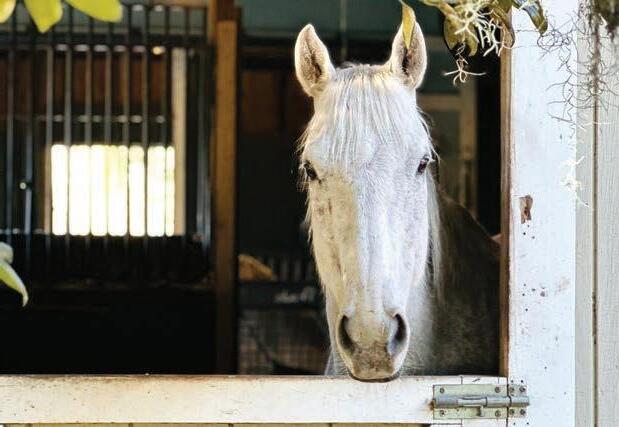 Non-members wanting to experience the Haig Point homeowner lifestyle can register for the Daufuskie Island Marathon on January 13th, 2024; the annual Haig Point Foundation Golf Tournament in the spring; or book a Discovery Visit at haigpoint.com/discovery-visits/.
For two decades, The Iron Fish Gallery has operated on an honor system with customers signing in, noting the piece they took and whether payment was left in the honor box or if they want a call to pay via credit card.
A horse at Haig Point's private equestrian center.
Non-members wanting to experience the Haig Point homeowner lifestyle can register for the Daufuskie Island Marathon on January 13th, 2024; the annual Haig Point Foundation Golf Tournament in the spring; or book a Discovery Visit at haigpoint.com/discovery-visits/.
For two decades, The Iron Fish Gallery has operated on an honor system with customers signing in, noting the piece they took and whether payment was left in the honor box or if they want a call to pay via credit card.
A horse at Haig Point's private equestrian center.
 Compiled by Victoria Chase
Compiled by Victoria Chase
Using narration adapted from Davis’ own words and a unique undulating visual style that reflects Davis’ constant musical changes, this graphic novel follows Davis through four decades of musical innovation centered around his quest to find a mysterious sound he heard on a moonlit country road as a child. Dave Chisholm (author & illustrator) — Miles Davis and the Search for the Sound, hardcover, 150 pages, Z2 Comics (available September 26)

Rick Rubin, a nine-time GRAMMYwinning producer, named one of the 100 most influential people in the world by Time and the most successful producer in any genre by Rolling Stone, shares the path of the artists as a road we can all follow. “I set out to write a book about what to do to make a great work of art. Instead, it revealed itself as a book on how to be,” says Rubin. Rick Rubin—The Creative Act: A Way of Being—hardcover, 432 pages Penguin Press
Bobby Berk, a design expert and Emmynominated TV host of Netflix’s Queer Eye, shows you how designing your space, no matter what size home you have, has an immediate, visceral, and undeniable impact. Bobby Berk — Right at Home: How Good Design is Good for the Mind — hardcover, 304 pages, Clarkson Potter (available September 12)

From ancient castles to sturdy Georgian manors and modest farmhouses, the rich history of the 15 homes featured here offers a unique insight into the Irish temperament and an exploration of a style of decoration that, while adapted to meet 21st-century demands, still retains historical integrity. Robert O’Byrne—Romantic Irish Homes— hardcover, 176 pages, CICO Books
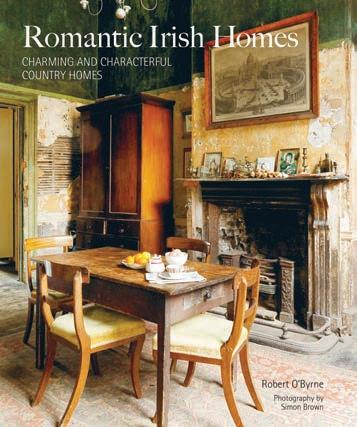
A look at thoughtfully matched, excessive, but on-point, more-is-better spaces worldwide and the passionate creators behind them. Living to the Max: Opulent Homes and Maximalist Interiors—hardcover, 256 pages, gestalten; us.gestalten.com.

As the first-ever account of how the Popes’ presence has shaped the history of Rome, this book illuminates the lives of the men who have sat on the throne of Saint Peter, alongside the bold and curious actions of the men, women, and children who have shaped the city with them, from antiquity to today. Jessica Wärnberg—City of Echoes: A New History of Rome, Its Popes, and Its People—hardcover, 448 pages, Pegasus Books (available September 5)
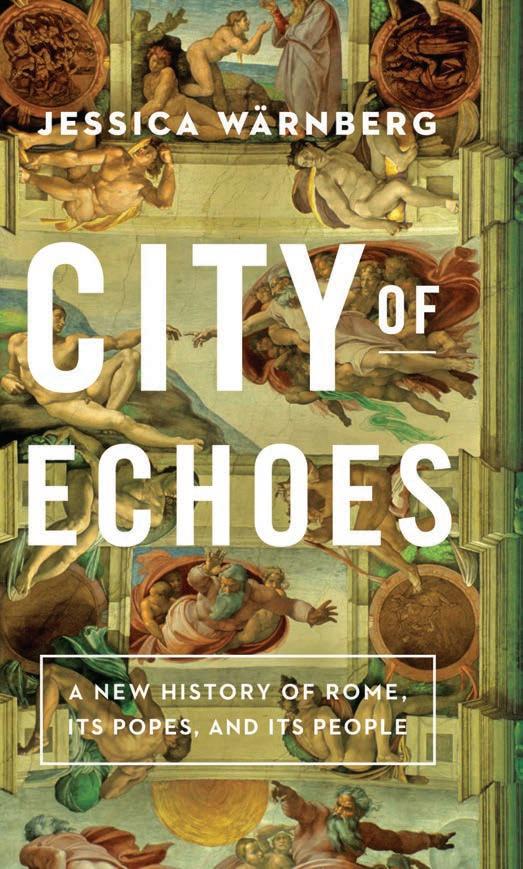
Looking to literature, film, architecture, and art history, artist Noah Davis, who died from cancer in 2015 at 32, permeated his paintings with emotion and imagination. This book delves into the Los Angeles-based artist and activist’s impact and legacy. Noah Davis, Helen Molesworth, Franklin Sirmans, Lindsay Charlwood, Thomas J. Lax, Glenn Ligon, Julie Mehretu, and Fred Moten—Noah Davis: In Detail —hardcover, 208 pages, David Zwirner Books (Available September 12)

A celebration of German home baking from Jürgen Krauss called "possibly the best-loved contestant in Great British Baking Show history." A self-taught baker, Jürgen draws on the flavors, techniques, and memories from his childhood, his European travels, and his wife's Jewish heritage to create this collection of authentic German baking recipes. Jürgen Krauss—The German Baking Book: Cakes, Tarts, Breads, and More from the Black Forest and Beyond— hardcover, 208 pages, Weldon Owen

This book is a vivid chronicle of a couple’s four-year, 40k journey across several countries and continents via bicycle. Olivier Van Herck & Zoë Agasi—Leaving the Comfort Zone: The Adventure of a Lifetime—hardcover, 320 pages, gestalten; us.gestalten.com.

Recreate recipes from the hit series as prepared by "Gator," the on-set caterer for the Paramount Network show's cast and crew since season one. Gabriel "Gator" Guilbeau—Yellowstone: The Official Dutton Ranch Family Cookbook—hardcover, 176 pages, Insight Editions (available on September 12)

'li' o 'taph, [bib-lee-uhtaf, -tahf]: a person who caches or

After exhausting my arsenal of automotive knowledge in conversation with Roger Ormisher, Vice President of Communications and PR for McLaren in The Americas, at an exquisite lunch at Aperture Cellars served on a table embellished with bright orange flowers that recalled the head-turning McLaren Artura parked nearby, our table topic took a philosophical turn. Roger asked me and my tablemates if our minds would be at ease if today were our last. Had we gotten everything out of life we wanted up to this point? It was a poignant reminder of why moments matter. Just an hour before, I was behind the wheel of an Silica White Artura, enjoying a windows-down driving experience that allowed the intoxicating scents of redwood and sea air to commingle, feeling the pulse-quickening acceleration, and noticing how certain exhaust notes made the hair at the back of my neck stand on end. It was one of the rare instances where I enjoyed being fully present to live in the moment. And, though I'm not quite ready to punch out on my life's time clock, a lifelong chase after carpe diem, which on this day included thoroughly testing the Artura's cornering capabilities, means that, like my delicious lunch that day, nothing is left on the table.
While I would have accepted an offer to pilot the Artura down my street, given the opportunity to do so through the varied terrain of California's Sonoma County, starting from the Montage in Healdsburg was a no-brainer. The evening before our drive, we took a deep dive into the McLaren culture during an alfresco dinner at

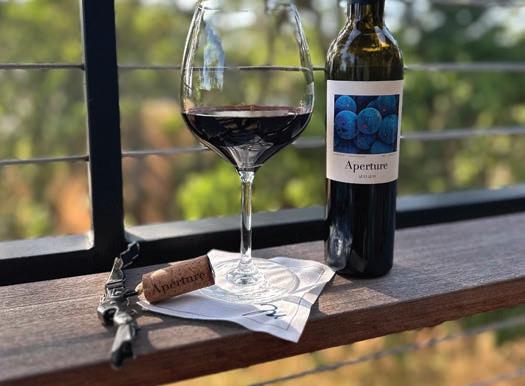
the Montage. As the last rays of sunlight cast a golden hue on the vineyards weaving through the luxury wine country hideaway, an A-list team of Ormisher, Nicolas Brown, President of McLaren Americas, Jo Lewis, McLaren's Head of Color and Materials Design, and Nolan Gray, Product Pricing and Fleet Specialist, shared the story of the world's last independent small volume manufacturer of high-performance vehicles.

"Motorsports are the core of our DNA," explained Brown. He went on to illuminate how the Artura, McLaren's first-ever seriesproduction High-Performance Hybrid (HPH) supercar, represents the distillation of more than a half-century of McLaren's expertise and experience in race- and road-car engineering. Artura, the name for this "clean sheet" design, comes from combining "art" and "future."
Extremely lightweight even with the battery, McLaren engineers employed a 'form-follows-function' design philosophy in devising the all-new McLaren Carbon Lightweight Architecture (MCLA), uniquely optimized for HPH powertrains and built in-house. A single MCLA tub is strong enough to withstand the weight of 15 Arturas stacked on top of it. Audiophiles will appreciate the tubmounted subwoofer's clean, crisp sound free of vibrations. Sexy and supercar go hand-in-hand, and the exterior's super-formed aluminum panels perform like Spanx in accentuating Artura's sinuous curves with a functional 'shrink-wrapped' look.
A pair of Arturas parked outside Aperture Cellars A dinner party celebrating Artura at Montage HealdsburgDesigned around the driver, "it's all about having fun behind the wheel at any speed," remarked Brown. And, with an all-new twin-turbocharged 3.0-liter V6 petrol engine with an E-motor and energy-dense battery pack, producing combined outputs of 671bhp and 530lb-ft, there's plenty of fun to be had. Rather than just becoming a garage trophy, McLaren owners put three times more miles on their supercars than other top-tier manufacturers in this realm.

A mandate to cut weight without cutting corners resulted in several innovations, including a first-to-market domain-based ethernet electrical architecture that's twenty-five percent lighter and allows for over-the-air updates. Not only are the Pirelli P ZERO™ CORSA tires extra grippy, but their innovative Pirelli Cyber Tyre® technology allows for real-time data collection resulting in improved handling.
While all the engineering and performance aspects are undoubtedly important and exciting, if the package isn't captivating, then it's all for naught. That's where Jo Lewis comes in. A master’s graduate of the Royal College of Art specializing

in textiles and technology, Lewis worked for Stella McCartney before moving to the automotive industry. Her involvement with Artura stretches back to 2016. "Design is cross-functional with engineering," explained Lewis, who added that McLaren's small volume means that customers get closer contact with corporate in the bespoke realm via McLaren Special Operations.
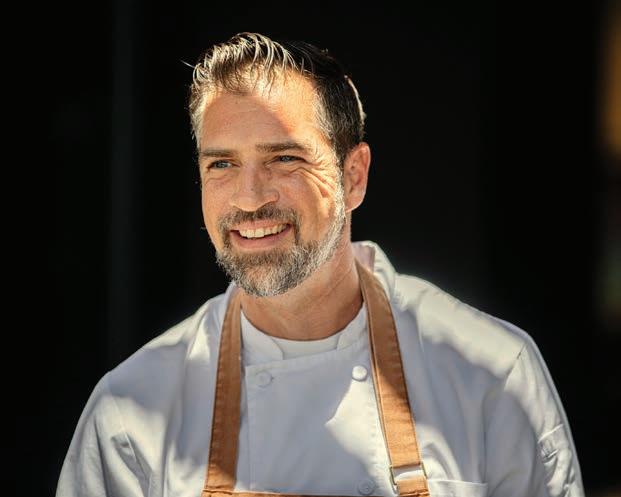
Applying NASA-level knowledge to her craft, Lewis’ portfolio of innovations is quite impressive. A newly developed method for leather interiors leans on her aerospace experience to deliver thirty-percent weight savings. She's devised ways to make cashmere applicable in an automotive setting, taking advantage of its wicking abilities. "Slip and grip" embossing in key touchpoints makes getting in and out of a McLaren easier. Ultrafabric, derived from the yachting sector, is durable, lightweight, and weather-resistant. If seeing your name in lights is insufficient, Lewis has found ways to weave it into your carbon fiber dashboard (even using 24-karat gold). Available contour paint jobs highlight the Artura's aerodynamics akin to contouring cheekbones with bronzer.
 Chef Jamil Peden during lunch at Aperture Cellars
Chef Jamil Peden during lunch at Aperture Cellars
Fog shrouded the Healdsburg hillsides on the morning of my drive. Nolan Gray escorted me to my Silica White Artura with a sumptuous all Alcantara interior, including the steering wheel, making it feel so luxurious in my hands. The scissor doors opened effortlessly, and a single finger provided enough force for closing. I sank into the Clubsport bucket seat, and at the push of a button, the Artura started in EV mode, and I set off like a silent assassin buzzing through the vineyards.
Knowing that 0-60mph straight-line acceleration is achievable in 3.0 seconds, I anxiously looked for a wide-open straightaway to switch the powertrain mode into Track to test the stat. As soon as I pressed the accelerator, the back of my head pressed into the seat, prompting me to yell "woohoo!" out of the open windows. In the interest of safety (and not wanting to go to jail!) I resisted finding out if sprinting 0–186mph takes a reported 21.5 seconds, so I'll have to take McLaren's word for it.
Throughout my roughly 50-mile journey over varied terrain, I switched between Artura's four powertrain modes: E-mode,
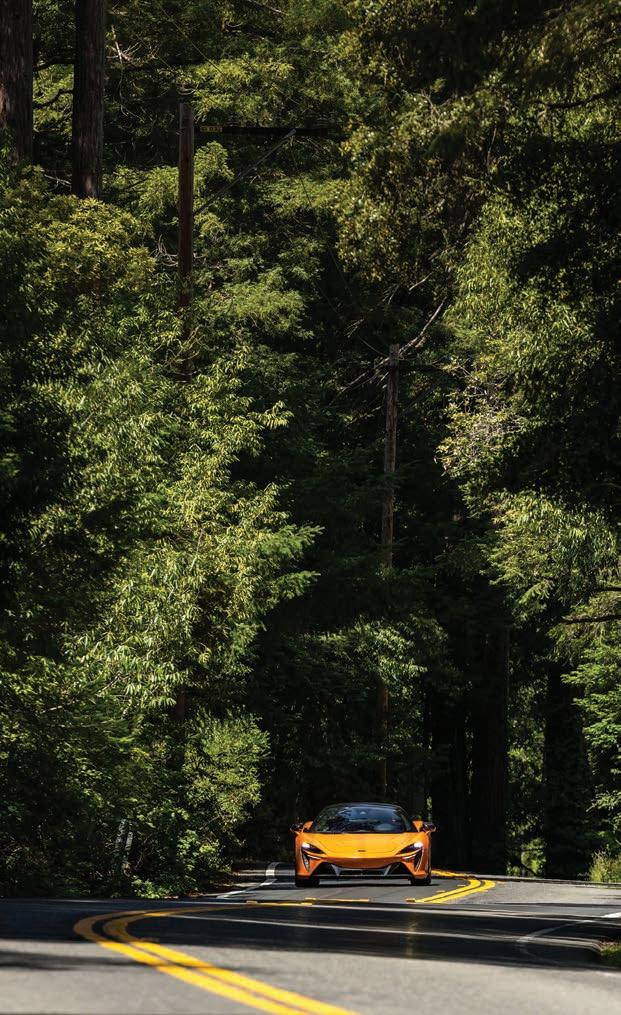
Comfort, Sport, and Track. Artura can drive up to 11 miles on battery power alone, and when I found I'd nearly exhausted its EV range, I switched to Sport mode to replenish the battery. I became giddy when a "Curves Ahead" road sign popped up, knowing that I'd be able to hug them as tightly as an old friend. At the halfway point, our driving group convened at The Birds Café in Bodega Bay, and our tricked-out Arturas in hues ranging from lowkey to lookat-me created quite a stir. "I guess I'm a car girl now!" exclaimed one of my colleagues from New York City, who said she "didn't get car people" until she got acquainted with Artura.
Truth be told, no one needs to own a McLaren, but at the end of the day, getting from point A to B is entirely more exhilarating for those wanting to squeeze every last drop out of life.
Artura is priced from $233,000 for the standard specification. Every McLaren Artura comes as standard with a five-year vehicle warranty, a six-year battery warranty and a 10-year body perforation corrosion warranty. More information is available at https://cars.mclaren.com/en/artura. sl
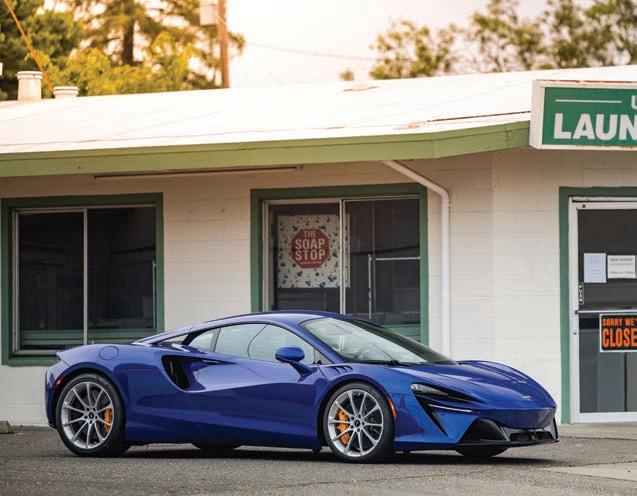

 Written by Claire Williams
Written by Claire Williams
While he doesn't have a flickering cigarette sticking out of his mouth and isn't sporting a marinière, (the classic French striped shirt), Jérôme Peter does embody the essence of a true Frenchman and wine aficionado. With family hailing from Corsica and Alsace, Jerome's upbringing educated his palette with tastings from acidic Rieslings to crisp Rosés. In his 20s, an internship in the wine industry with his stepfather in the mid-90s allowed Peter to take a deep dive into wines of the world, meeting winemakers and discovering varietals from South America to China. In the process, he found a new love and passion for wine. Peter equates the feeling of finding a wine you love to "clicking" with a newfound love interest, saying, "When you know, you know that there's an instant chemistry."
After his stepfather's passing just a few years later, Peter decided to honor the man who introduced him to his newfound amour by embarking on what would turn out to be a lengthy career in the wine world.
Like a faithful partner, he has spent over 20 years working in the wine industry for Carrefour, the eighth-largest retailer in the world by revenue, following trends and selecting wine for its outlets year after year. Peter says his tenure is long enough that he was there when premium bag-in-box wine was a foreign concept and continues with him navigating the current biodynamic revolution. Peter's longevity in the French wine trade has made his name uttered in the same breath as renowned stars of the industry he frequents, such as winemaker Gérard Bertrand (well known for his collaboration on Hampton Water Rosé with Bon Jovi) and
sommelier Gérard Margeon. Over the past two decades, Peter has encountered specific wines that have stood the test of time to remain among his favorites in a market where tastes, flavors, and trends evolve more rapidly than we realize.
Peter says that for him, tasting wine is a spiritual experience, something he calls "tasting the blood of the land," with each bottle bringing out a different emotion while telling the story of the winemaker and the terroir. Peter says Salvador Dali said it best with his maxim, "The connoisseur does not drink wine but tastes its secrets." Peter will take hours to make sure his roti de porc is the perfect complement to his bottle, not the other way around (and if there's no wine on the table, he says it's not a meal).
As a youthful wine drinker, Peter gravitated towards bold and fruity wines and still enjoys them today. Gérard Bertrand's Cigalus wine from Pays d'Oc (the southern coast of France) is a wine he says everyone likes. It comes from a region with plenty of sunshine, and the wine boasts a balance of ripe black fruit such as blackberries, black cherries, and plums with grilled spice and toasted oak, imparting flavor that even the most stubborn wine drinker will enjoy.
Made from Gamay grapes, Henry Marionnet's Tourraine Gamay 1ère Vendange (hailing from the Loire Valley region) is a lesser-known variety that is the cousin of pinot noir and with whom it shares similar tasting notes. Peter says he opens a bottle almost every evening at dinner with his wife, and it's worth noting the wine contains no sulfites, which, according to some reports, should give you less of a hangover and headaches after drinking, hence the easy drinking quality of the wine.
French wine connoisseur Jérôme Peter shares a few of his favorites.
For those more inclined to white wines, Peter enjoys Domaine Grist's Cotes d'Auxerre Chardonnay, sharing the taste of Burgundy without breaking the bank. It's a toasty wine with ripe fruits that pairs well with chicken and seafood, and if you're feeling like embracing the art de vivre of the French, foie gras. “A tremendous value for the price, finishing with pleasure and soul,” remarks Peter.
If you're lucky enough to get your hands on a bottle, one of Peter's favorite big, sunny, and fruity wines is from critically acclaimed Domaine Peyre Rose. Marlène Soria founded the estate in the late 1990s in the village of Saint-Pargoire in the south of France, where her plan to make wine for herself and friends resulted in international success and even attention from Robert Parker. Peter says the small size of their operation means they only produce around 30,000 bottles a year, and they age them for up to a decade to let each bottle reach its full potential before they're sold. Peter still has a bottle of 2003 in his cellar, and he describes the flavor as "bold and balsamic."
For those looking for something other than a fruit-forward wine, Peter recommends Chateau Rayas, started by the godfather of Chateauneuf-du-Pape, Jacques Reynaud; their wines are some of the most sought-after in the region. The wines are aromatic and complex, and Peter singles out their herbaceous character.
Moving outside of France, Peter gravitates to Italian wines. Among his favorites is an expressive Castello Banfi Brunello di Montalcino that's intense with ripe red fruit combined with more complex notes of licorice and pipe tobacco.
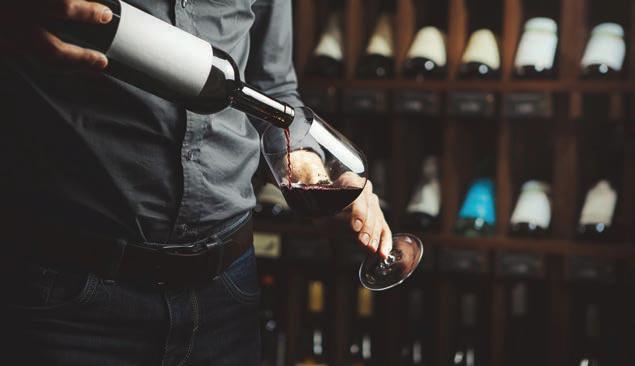
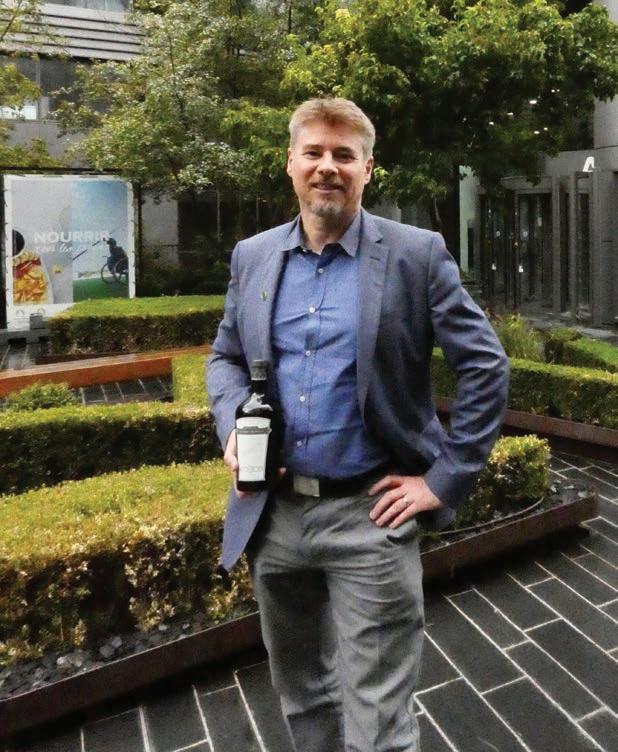
To finish his evening on a sweet note, Peter enjoys the awardwinning Château la Varière's Bonnezeaux, Les Melleresses, a sweet
wine that combines citrus fruits, sweet spices and tropical fruits. And when it comes to bubbly, Peter says you can't go wrong with the classics: Krug champagne delivers rich and layered baked bread and brioche notes, while one of his other favorites, Taittinger Champagne, has ripe fruit, honey, and brioche aromas but is rich and creamy on the palate. During his career, Peter has been lucky enough to drink all the terroirs of France and even some of the rarest, such as Romanée Conti, which he says you should not pass up if given the opportunity to taste it. Not averse to change, Peter constantly discovers new wines to add to his favorites list. As the climate, trends, and even our palates evolve, there's a never-ending list of wines to choose from, and there are always new gems to unearth. sl
Jérôme’s Cellar Standouts
• Gerard Bertrand Cigalus Pays d’Oc
• Henry Marionnet’s Tourraine Gamay Première Vendange
• Goisot Côtes d'Auxerre
• Domaine Peyre Rosè Languedoc Roussillon
• Château Rayas Châteauneuf-du-Pape
• Sauternes Château d'Yquem 1989
• Grange des Péres Languedoc Aniane Vin de Pays

• Domaine LeFlaive Puligny-Montrachet
• Domaine Jean-François Ganevat, Jura
• Taittinger Champagne
• Krug Champagne
• Château la Varière Bonnezeaux Les Melleresses
• Brunello di Montalcino Castello Banfi
Leprechaun lore aside, I've always found Ireland to be enchanting, particularly the myriad green hillsides of the rural countryside that stand in contrast to skies that are shrouded in clouds roughly half of the time, and which make the occasional pop of sunshine seem all the more magical.
My Irish eyes were smiling during my most recent visit, which began with a whirlwind two nights in Dublin at The Merrion Hotel (merrionhotel.com), followed by another three at Sheen Falls Lodge (sheenfallslodge.ie), situated along the famed Wild Atlantic Way. But honestly, how could I not love a place where, after introducing myself, the locals are quick to remind me that my name is indicative of a strong woman and the name of one of three of the country's national saints?

Located in an upscale neighborhood steps from the National Gallery, The National Museum of Ireland, and the "golden mile" around St. Stephen's Green, the five-star The Merrion represents a triumph of thoughtful historic preservation. The hotel comprises four Georgian townhouses, the oldest dating to the era when American Colonists were busy tossing tea into the Boston Harbor. The two-year restoration commenced in the mid-1990s, resulting in interiors that mirror the handsome exterior: elegantly understated and dignified.
The present owners claim one of the largest collections of 18th and 19th-century art in Ireland and generously share it with hotel guests in public and private spaces. Art enthusiasts will want to avail themselves of a self-guided audio tour and partake of a whimsical afternoon Art Tea, in which the accomplished pastry chefs create edible works of art inspired by works in the hotel's collection.
The wings of the hotel envelope a beautifully landscaped garden with water features and a glass-enclosed walkway leading from the historic structures to the modern wing, which includes a large spa complex with an indoor pool. Accordion doors along one wall of the aptly named Garden Terrace restaurant bring the outdoors in; the elevated environs draw in stylish local "ladies who lunch" like bees to the hives on The Merrion's rooftop.
The labyrinth-like cellar bar is housed in the property's original wine cellar, offering plenty of cozy nooks for a candlelight dinner. Waterfall-inspired stained-glass windows, an homage to the cascades dotting the famed Ring of Kerry, are inset among the thick stone walls. In a city with no shortage of pubs, this watering hole is popular with locals who come to imbibe its two bespoke ales, lemon gin, and listen to traditional Irish music on Thursday evenings.
When the calendar flips to March, everyone purports to be Irish, a claim that's partially attributable to the fact that some 10 million Irish have left their homeland since the 1800s. It's mind-boggling that today, 70 million people claim Irish heritage, more than ten times the country's total population, which makes ancestry tourism a big deal. Dublin's subterranean Epic Museum (epicchq.com), the world's first fully digital museum, traces 1,500 years of Irish immigration, including the accomplishments of some of its most famous (and infamous) sons and daughters, who I was surprised to learn include Che Guevara, Muhammad Ali, Gene Kelly, Walt Disney, Tom Cruise, Robert DeNiro, and Barack and Michelle Obama, among many others.
A City-to-Countryside Tour of the Emerald Isle
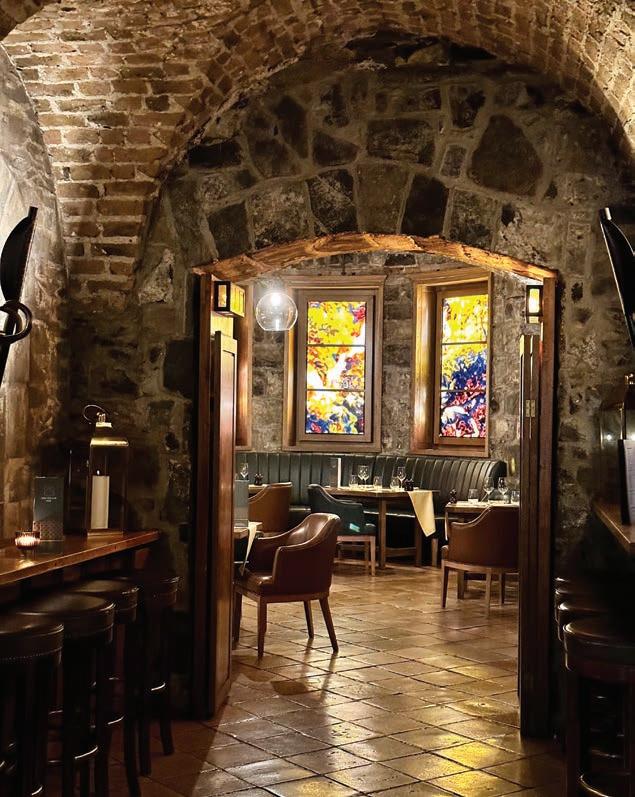
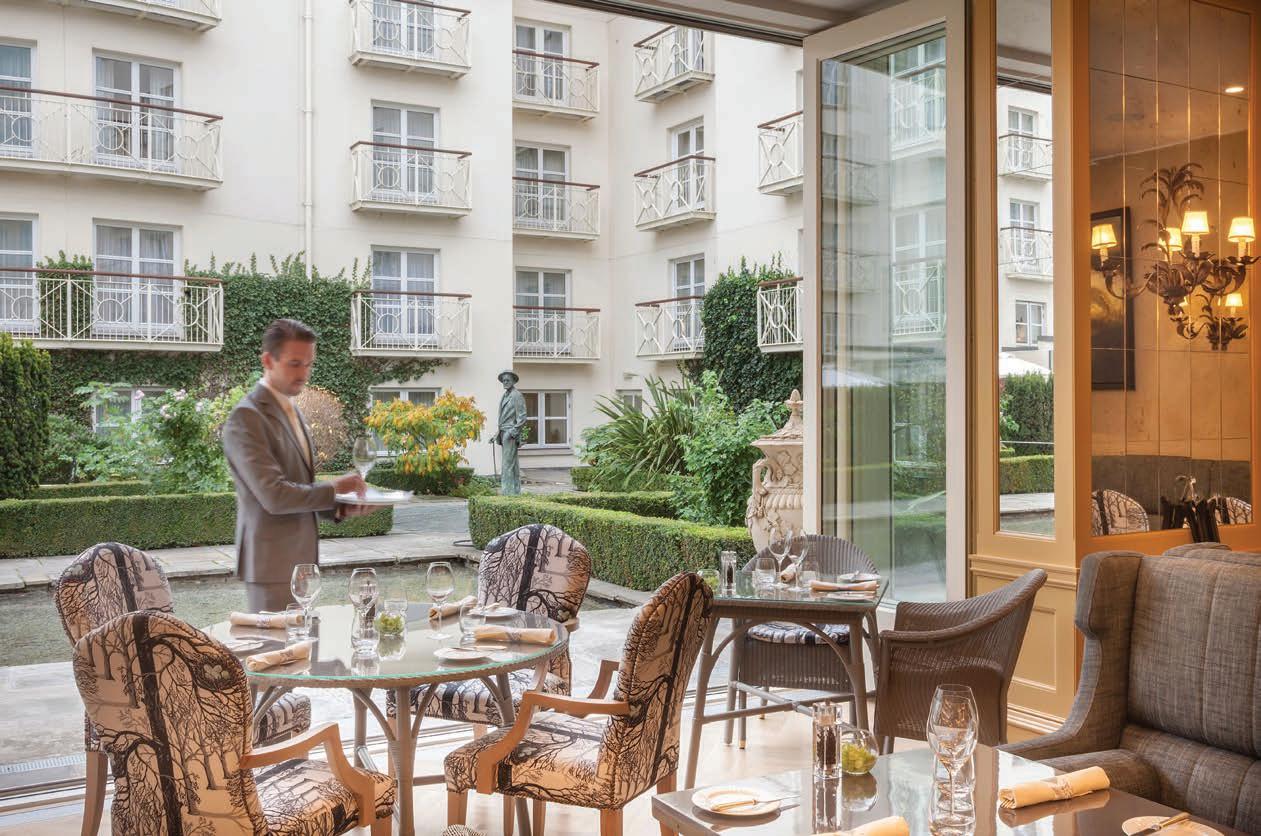 The Garden Terrace Restaurant at The Merrion
The Garden Terrace Restaurant at The Merrion
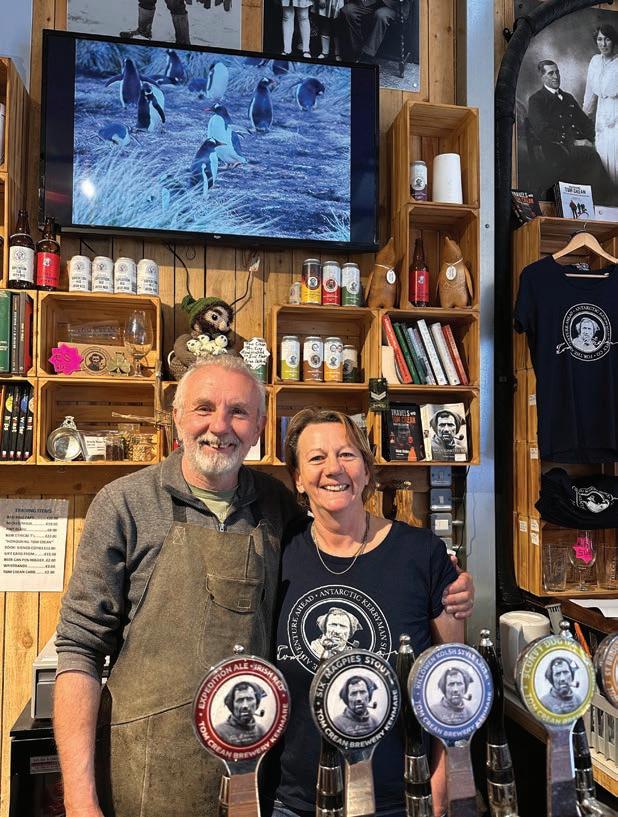


 French chocolatier Benoit Lorge at his eponymous shop in Kenmare.
Accessible only by ferry, the 37-acre Garnish Island in Bantry Bay boasts extensive gardens with several unique structures.
A feast of locally sourced Kenmare delicacies at Heidi Ryan's Wholesome Food, organize.d by Kenmare Foodie Tours.
French chocolatier Benoit Lorge at his eponymous shop in Kenmare.
Accessible only by ferry, the 37-acre Garnish Island in Bantry Bay boasts extensive gardens with several unique structures.
A feast of locally sourced Kenmare delicacies at Heidi Ryan's Wholesome Food, organize.d by Kenmare Foodie Tours.
Dublin is a great town for wandering. If you're a James Joyce fan, you must stop into Sweney's Pharmacy (sweny.ie), whose lemon soap is famously featured in Ulysses (and still available for purchase today). With disheveled gray hair that calls to mind Einstein's coif and a silk tie peeking out from his down jacket that lends the air of eccentric aristocrat, owner and polyglot J.J. Murphy preserves the tiny shop as it appeared in Joyce's time. Smelling of stale tobacco and dusty old books, Murphy is quick to pick up his guitar to serenade visitors and invited us to return for a scheduled reading of Joyce's works.
If music history gets your heart racing, you'll want to arrange a tour of Windmill Lane Studios (windmilllanerecording.com). Rather nondescript from the outside, Brian Masterson and James Morris opened it in 1978, and it remains one of Ireland's largest recording studios. U2 was famously the first Irish band to record there, becoming part of a motley mix of bands and artists that includes Simple Minds, Kate Bush, AC/DC, Hozier, The Spice Girls, Kylie Minogue, Niall Horan, Lewis Capaldi, Van Morrison, and Ed Sheeran. Their studio tour allows you to mix a session with their virtual band and receive the MP3 file as a one-of-a-kind souvenir or, in my case, a painful reminder that even though I love to sing, I can't carry a tune.
No visit to the capital of the Republic of Ireland would be complete without a pub tour. During ours, led by Perfect Pint Tour (theperfectpinttour.com), we visited both well-known and local's only watering holes and learned all about the letters and numbers
found on a Guinness pint glass; that a good Irishman (or woman) finishes a pint in seven sips or less; and, that foamy rings from topto-bottom evidence a perfect pour. We even went behind the bar to learn from time-tested pint perfectionists who seem to eschew any interest in crafty cocktails.
The concierge at The Merrion can arrange a guided hike along the Cliff Path Loop that follows the contours of the wildflowercovered cliffs of the Howth Peninsula, just east of central Dublin. Ideal for a day trip; even though it's just a short drive from the bustling city, it feels worlds away.

After a few days exploring Dublin, we hit the M7 to Sheen Falls Lodge in County Kerry. En route, we enjoyed a thoroughly entertaining rest stop at the Barack Obama Plaza, located next to the village of Moneygall. Essentially a fast-food-laden truck stop, a small second-floor museum highlighting US Presidents with Irish heritage is surprisingly well executed.
Sheen Falls Lodge, nestled amid the gently undulating landscape next to its namesake falls and overlooking Kenmare Bay, was built in 1765 as a private country house and debuted as a 72-room resort in 1991. Later additions to the original structure kept the same Irish plaster exterior and steeply pitched roof as the original home, which belies its grandiose scale, including a large Easanna Spa wing with a massive indoor pool. Spa treatments incorporate VOYA products, made with sustainably-harvested wild seaweed from Ireland's west coast.
All the guest rooms at this rural retreat, a Relais & Chateaux property, provide a view of the falls, Kenmare Bay, or both. Lodge guests are privy to 15 miles of private fishing on the river, and Sheen Falls has a strong commitment to conservation, ensuring that the native Wild Atlantic salmon who have inhabited these waters since the last Ice Age will continue to do so for generations to come.
Not wanting to squander a moment of the views afforded by the large terrace of my sprawling Signature Suite, I indulged in an elegantly presented alfresco breakfast each morning, allowing the soothing sounds of the falls to have my full attention. In addition to nine distinct room types, the property boasts a trio of storybook thatched roof cottages and a pair of bayfront villas for rent, each beautifully, uniquely, and luxuriously outfitted.
In addition to fishing, Sheen Falls offers scores of activities such as horseback riding, tennis, bike riding, sporting clays, guided walks and hiking, archery, kayaking and paddleboarding, golf, photography excursions, and falconry. Liam Regan, a licensed falconer and wildlife biologist from Killarney leads the falconry program. His calm demeanor makes even the most reluctant ornithologist comfortable as he demonstrates the skills of the forest's apex predators.


Dining options on the property include the newly opened Stables Brasserie & Bar, housed in the property's original horse stables. Casually elegant, it's quickly become a favorite of locals from the nearby town of Kenmare. The Falls offers a more elevated dinner experience. A recent addition is the Mediterranean-influenced Nua Vista Restaurant, located at the Lodge's sister property, Ring of Kerry Golf Club (ringofkerrygolf.com). For a more bespoke experience, private dining is available in several unique spaces, including the candlelit wine cellar, one of the largest private cellars in Ireland. Take advantage of a G&T in the cozy Sheen Bar, made with seacentric gin custom-blended by the nearby Isle of Barra Distillers specifically for Sheen Falls Lodge.
Sheen Falls has a symbiotic relationship with the quaint town of Kenmare. A local artist created the whimsical mural behind the reception desk; local products are among the gratis goodies in the minibar; the stoneware coffee set hails from Killarney; and a local wine shop selects the Lodge's wine of the month. Kenmare locals, a surprisingly cosmopolitan bunch for a city of just 2,300 residents, are proud that their village was awarded a gold medal in the 2022 TidyTown annual nationwide competition.
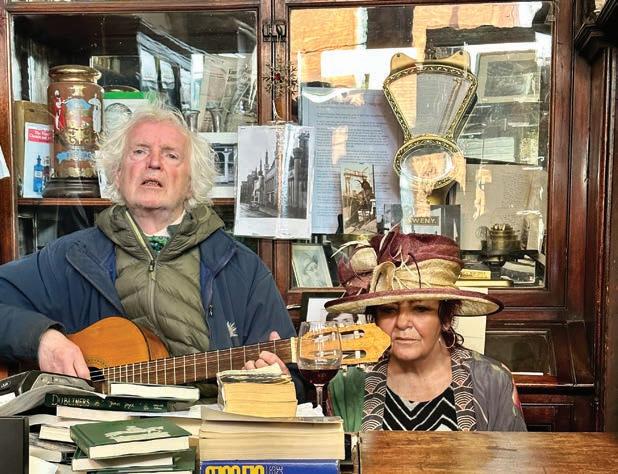
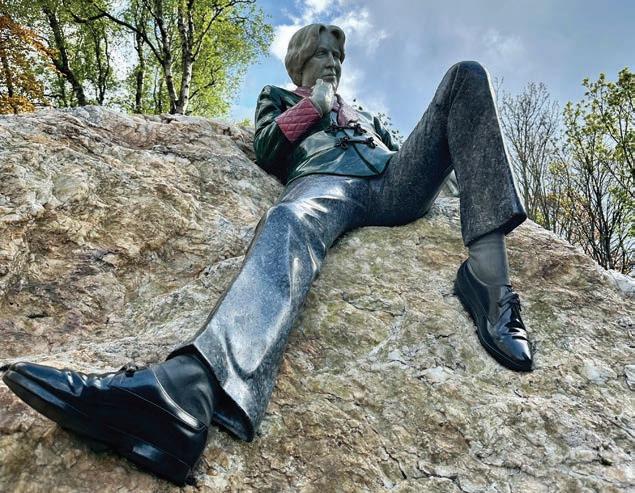 Liam Regan, a licensed falconer and wildlife biologist from Killarney leads the falconry program at Sheen Falls.
The Oscar Wilde monument in Dubin’s Merrion Square Park.
At Sweney's Pharmacy, made famous by James Joyce, proprietor J.J. Murphy is keen on entertaining visitors with a song.
Liam Regan, a licensed falconer and wildlife biologist from Killarney leads the falconry program at Sheen Falls.
The Oscar Wilde monument in Dubin’s Merrion Square Park.
At Sweney's Pharmacy, made famous by James Joyce, proprietor J.J. Murphy is keen on entertaining visitors with a song.
We enjoyed a half-day walking tour led by Kenmare Foodie Tours (kenmarefoodies.com), during which we sampled authentic French pastries at Maison Gourmet (maisongourmetkenmare. com), where the husband-and-wife owners hail from the Pyrenees; farmhouse cheese and charcuterie at Heidi Ryan's Wholesome Food, and award-winning, handmade chocolates from Lorge Chocolatier (lorge.ie), whose affable owner Benoit, a native of France, moved to Kenmare twenty-five years ago. Those with an adventurous spirit or just a fondness for craft beer will want to stop for a pint at the Tom Crean Brewery (tomcreanbrewerykenmare.ie). Another husbandand-wife enterprise, the duo are as passionate about their craft as they are about exploring the far corners of the globe. "We aim to produce a pint that doesn't cost the earth," explained Bill Sheppard, a former fireman from England who met his wife Aileen Crean O’Brien, a Kenmare native, while traveling in Goa, India. The couple worked with Dutch scientists to build a biodigester that converts the spent grain from distilling into high-protein silage to feed sheep. While sipping a St. Bridget Irish Lager, I learned that the patron saint was a brewer and several of the miracles attributed to her involved beer.
Garden enthusiasts should plan to visit Garinish Island (garinishisland.ie), accessible by ferry in the sheltered harbor of
Glengarriff in Bantry Bay, where languid seals blend in with rocky outcroppings. John Annan Bryce purchased the 37-acre island, which boasts a unique micro-climate, from the War Office in 1910 and tasked Harold Peto to execute extensive gardens with structures that include a clock tower, Grecian temple, Italian casita, and a Martello tower that dates to the Napoleonic Wars. Today the parklands are maintained by the Office of Public Works. After the tour, drive along the breathtakingly beautiful Healy Pass in the Beara Peninsula, dotted with solitary sheep whose wool bears colorful dots indicating its ownership, before stopping for super-fresh seafood lunch with the locals at Helen's Bar in Kilmackillogue Harbor.
Marveling at the moodiness of the Emerald Isle's landscape always evokes introspection for me. In-between songs at Sweney's Pharmacy in Dublin, Mr. Murphy recited a quote attributed to G.K. Chesterton: "The great Gaels of Ireland are the men that God made mad, for all their wars are merry, and all their songs are sad."
I'd argue that the scenery, well suited to wide panoramic shots that beg for a dramatic orchestral accompaniment, is more winsome than weary, particularly when combined with Ireland's enduring culture of hospitality consistent from city to countryside. sl



 A suite at Sheen Falls Lodge
The lobby at Sheen Falls Lodge
A tour of Kenmare in Sheen Falls’ 1936 Buick is a popular among guests.
A suite at Sheen Falls Lodge
The lobby at Sheen Falls Lodge
A tour of Kenmare in Sheen Falls’ 1936 Buick is a popular among guests.
($120) and printed skort ($95; fila.com). Vinglacé limited edition pickleball wine set in white ($149.95; vinglace.com). Anyone for Tennis biscuit box from Biscuiteers ($58; biscuiteers.com). Palissade bench from Hay ($1,045; us.hay.com). Spinshot player Pickleball machine (from $1,979; spinshotsports.com).


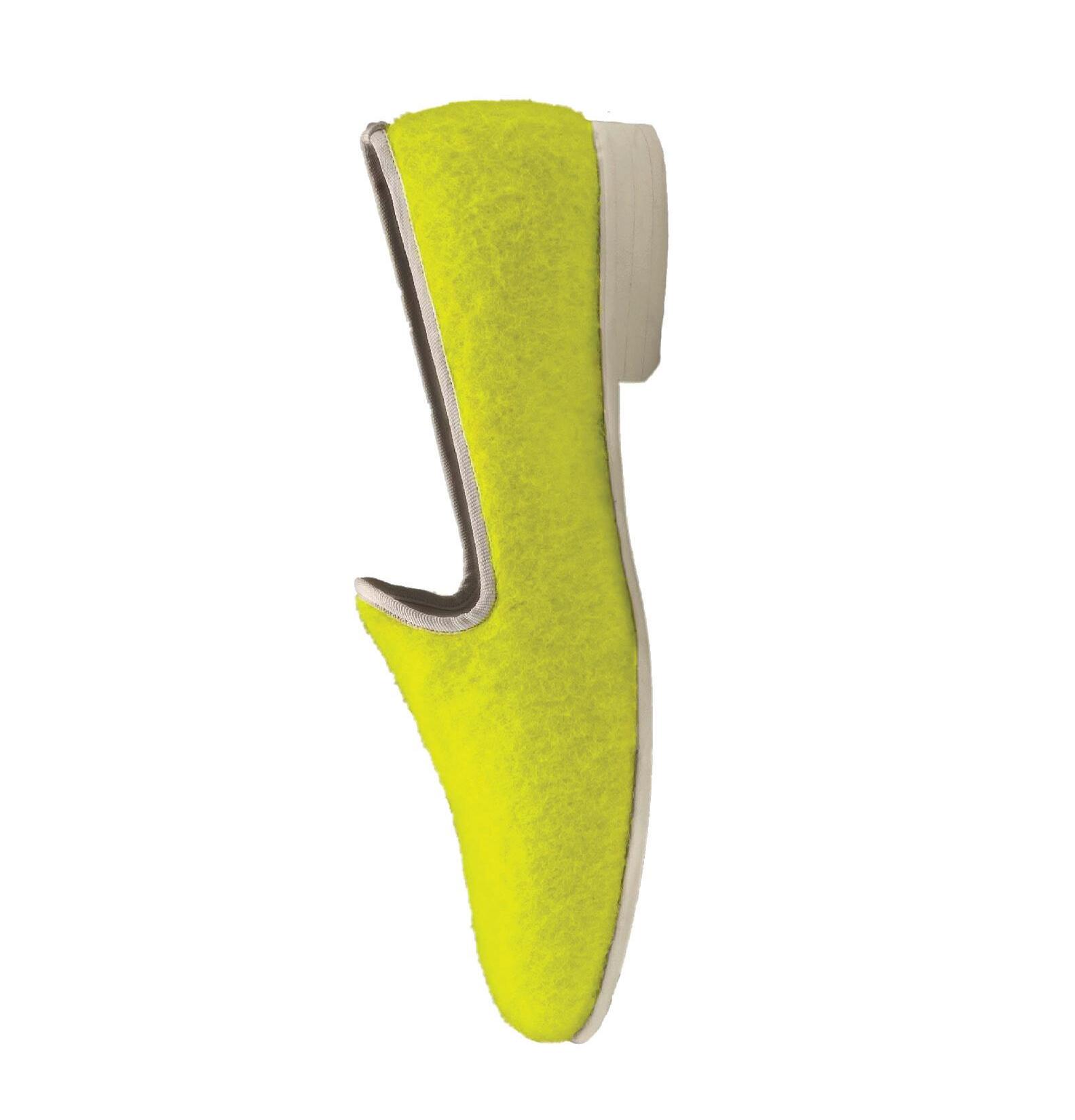



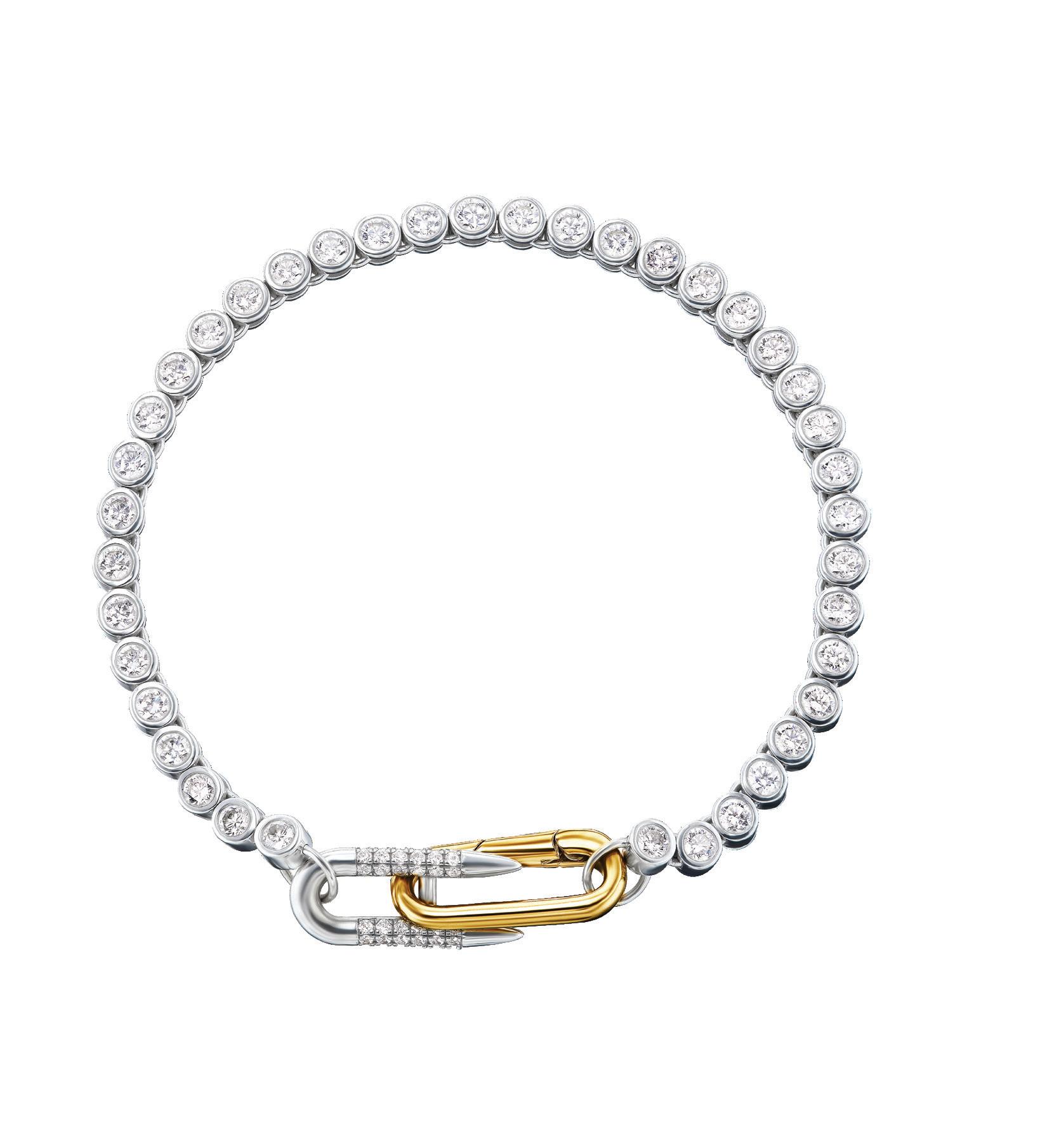
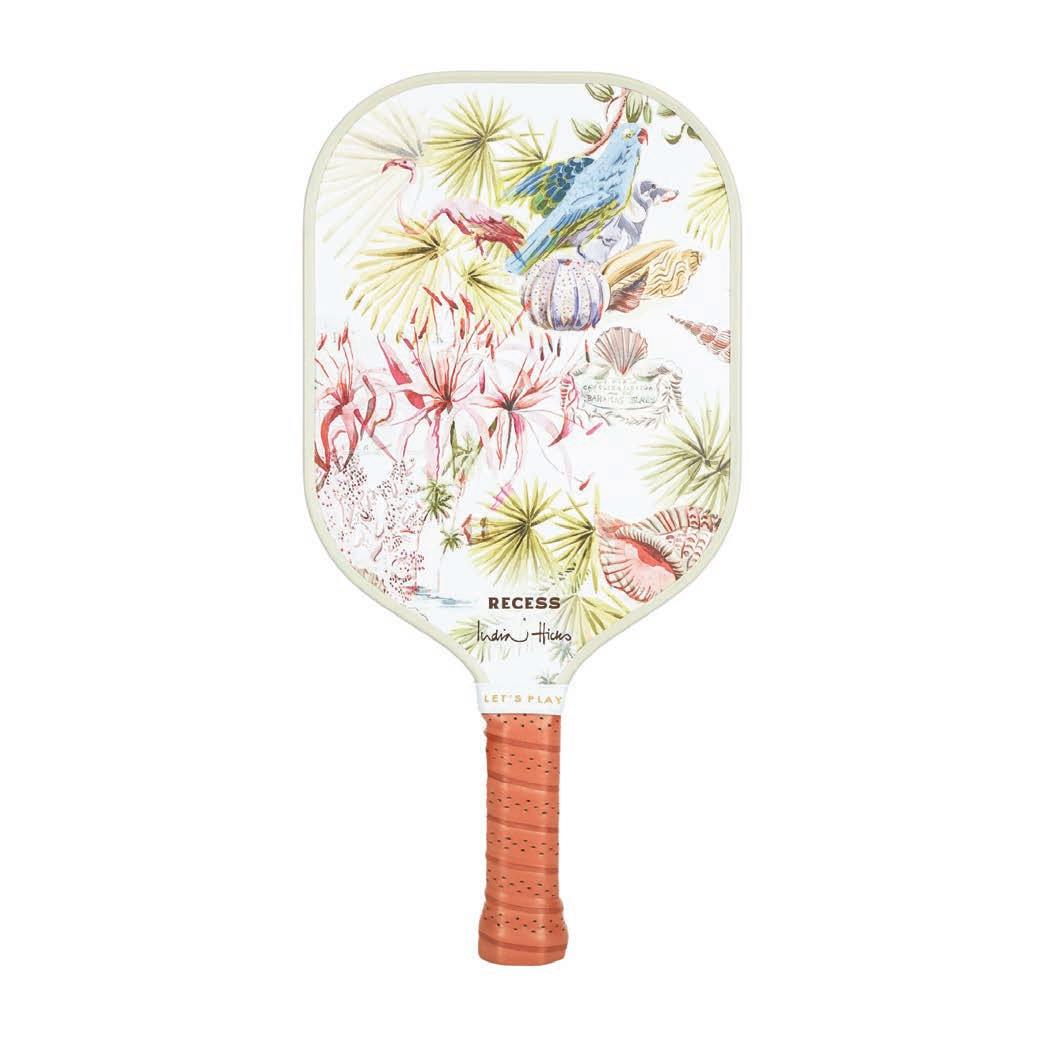





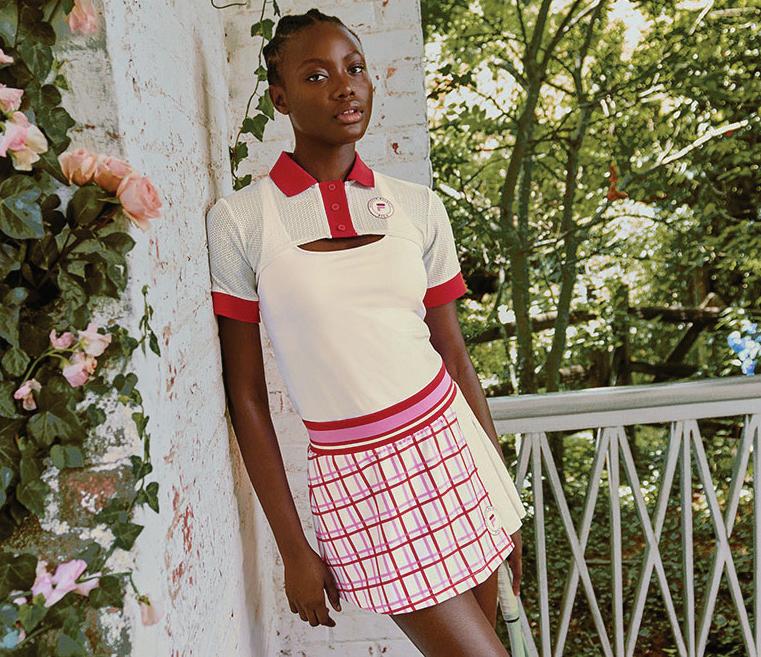


There are many reasons to visit New York City, and I have two: Amateur Night at the Apollo and Central Park. For my most recent sojourn, which included a stay at The Lowell (lowellhotel.com), I couldn't have gotten much closer to Central Park than if I pitched a tent under one of its 18,000 trees. And, if perks rather than parks are more your thing, you're a Birkin's-throw away from Hermès' Madison Avenue flagship. Walk just a little further for an actual breakfast at Tiffany’s at Daniel Boulud’s Blue Box Café on the fourth floor of the exquisitely renovated Landmark building on Fifth Avenue, which reopened to great fanfare this past April. Waiting to be discovered among its ten floors are a high jewelry workshop and an Audrey experience, where you can marvel at how teeny tiny Ms. Hepburn’s waist had to be to fit into that iconic Givenchy gown.
Nestled on a tony tree-lined Upper East Side block dotted with brownstones and offering the chance to rub elbows with neighbors counted among the world's wealthiest (a nearby ninebedroom townhouse was on the market for $28 million), the Lowell, one of the last privately owned hotels, was practicing stealth wealth long before it became a buzzword.
Stepping down into a small marble-floored vestibule that provides access to the chic Jacques Bar on the left and the hotel's reception room on the right, we were immediately entranced by the aroma of fresh flowers. Purpose-built as a 17-story hotel that opened

in 1927, notable features of the 74-room property include rooms with wood-burning fireplaces and furnished terraces, a rarity among NYC hotels. The Lowell's most recent $25 million renovation, overseen by current owner Dina De Luca Chartouni, and unveiled in 2017, cemented its consistent placement atop major travel magazines' lists of the world's best hotels.
Los Angeles-based interior designer Michael S. Smith devised the property's eclectic interior design scheme, imparting a uniqueness that looks like it was collected over time. Though it is as impeccably and elegantly outfitted as the rest of the property, guests generally don't linger long in the small lobby, preferring instead to seek repose in large and luxurious guest rooms and suites boasting loads of natural light and upscale amenities, including Chartouni’s own DDC28 bath amenities. The hotel’s residential feel made it fun to ponder living in the city for a hot second.
The army of attendants at the front desk projected the care and confidence of a team that's been at the helm for decades. The casual mention of a birthday resulted in the prompt delivery of a lovely card, a bottle of Cava, and a glass jar of colorful macaroons.
By and large, rooms at The Lowell are as much as 100 square feet larger than venerable peers like The Carlyle and The Pierre. Our 15th-floor suite boasted a separate living room with plush upholstery and an abundance of windows to admire the view of neighboring rooftop gardens, a Carrera-clad bathroom with a separate tub and
Written by Bridget Williams
The Lowell makes it easy to take a juicy bite from The Big Apple’s best offerings.
shower, and an elegantly understated bedroom so quiet that each morning, we remarked that for the first time, the sounds of the city didn't suspend our slumber. Not having read a physical newspaper in years, I looked forward to the daily doorknob delivery of the New York Times and the luxury of time and comfort to engage in an activity that felt akin to firing up a record player.
Throughout our stay, I gravitated to the first-floor Club Room at the rear of the property, which is reserved exclusively for guests. Deftly toeing the boundary where gilt and mirrors traipse from gobsmacking to gaudy, I relished concocting my vision of who'd live in such a place. Classic design elements culled from Greek and Roman influence spoke to someone well-versed in history; a plethora of coffee table books hinted at continuous curiosity; art spanning the centuries signaled an openness to beauty in all forms; and a series of photographs of Marilyn Monroe surmounting a pair of leopard-print upholstered slipper chairs added just a touch cheekiness to indicate someone who didn't take themselves too seriously.

It's always a treat when I can share something new with friends who live in the city, and it was fun to invite them for a private apéro in our temporary haven. "How did we not know about this gem?" they exclaimed while surveying the space.
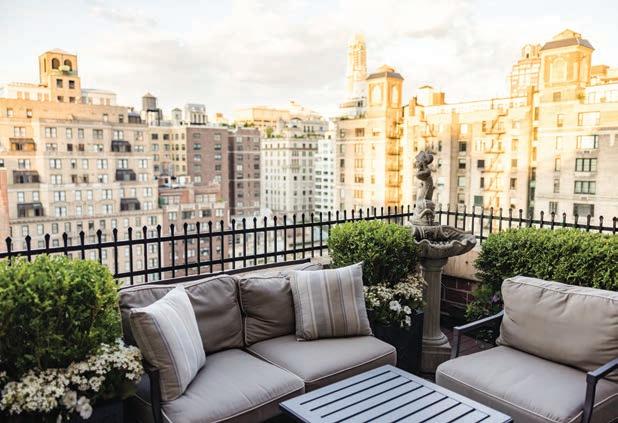
Arched French doors at the rear of the Club Room provide a view into the glass-ceiling orangery at Majorelle, The Lowell's elegant French/Mediterranean restaurant. Resplendent with a groin vault
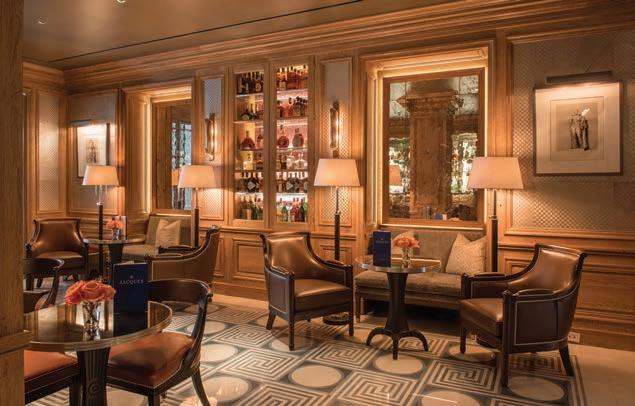

ceiling accentuated by French Art Deco pendant chandeliers and a graphic black-and-white marble floor, the space is punctuated by monumental and fragrant floral arrangements.
The lobby's grand marble staircase leads to the Pembroke Room, another of NYC's best-kept secrets. In this opulent, Europeaninspired salon, white-jacketed servers serve daily breakfast and weekend brunch for hotel guests. Also on this floor is a very wellequipped fitness room, which is quite large for a boutique city property.
With The Lowell located one-hundred-fifty feet from Madison Avenue and slightly more than one thousand feet from Central Park, we amply occupied our days by shopping and strolling, even walking all the way through the park to Harlem for our pre-show dinner at Vinateria (vinaterianyc.com), a lively Black-owned restaurant serving solid Italian and Spanish-inspired food without pretense.
While it's been a staple at the historic Apollo Theatre since the 1930s, I have been a fan of Amateur Night since college, when it would air on network television in the late night/early morning timeslot. I've attended in person four times, and I never fail to be entertained by the crowd and the rookie performers willing to go up against a "be good or be gone" audience whose display of dismay gets contestants promptly escorted by a tap-dancing "executioner" off a stage that's launched the careers of legends like Ella Fitzgerald and James Brown. For $30 a ticket, it's some of the best fun you can have on the cheap in the Big Apple.
Jacques Bar at The Lowell The Hollywood Suite at The Lowell.Here Lies Love sits at the opposite end of the entertainment spectrum (herelieslovebroadway.com). We were introduced to this new David Byrne and Fatboy Slim musical by dear friends who helped bring the disco-bio about Imelda Marcos to Broadway. Flirting with being among the top ten highest-grossing shows since opening in July, we celebrated the show's success and a pair of milestone birthdays with a prix fixe French/Korean feast at LittleMad (littlemadnyc.com). The restaurant's austere interiors, with overhead linear suspension lights casting an LED glow above chunky concrete tables with bench seating, belied the nuanced

flavors and beautifully presented dishes from Korean-born and New York-raised chef Sol Han's kitchen.
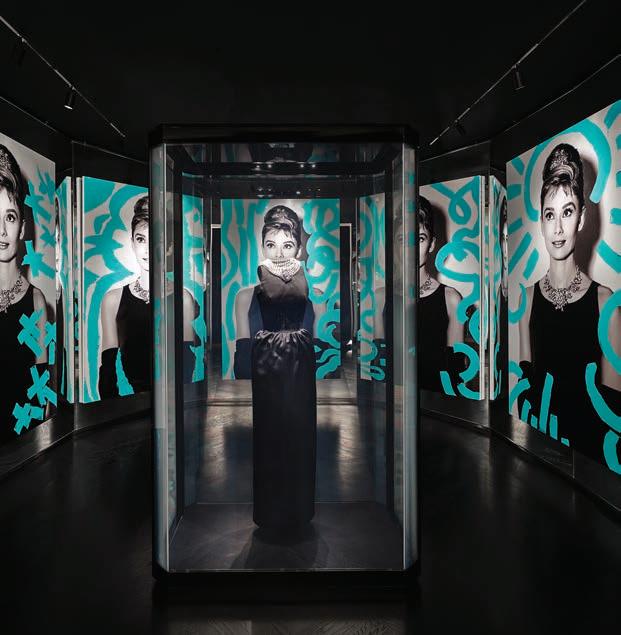
While NYC has long been known as "The City that Never Sleeps," it seems that COVID has left a melatonin-like effect on the fine dining scene. Running a little late for our 8:30 reservation, we sat down and found that we had mere minutes to submit our order to the kitchen at LittleMad before the cutoff. And even though we were the last to leave, we were happy knowing that our somewhat abbreviated evening could continue back in the comfy confines of the Club Room at The Lowell. sl
 An amateur vocalist performing during Amateur Night at The Apollo.
The Landmark, Tiffany's 5th Avenue flagship store.
The “Audrey Experience” on the fifth floor of The Landmark, Tiffany's 5th Avenue flagship store.
An amateur vocalist performing during Amateur Night at The Apollo.
The Landmark, Tiffany's 5th Avenue flagship store.
The “Audrey Experience” on the fifth floor of The Landmark, Tiffany's 5th Avenue flagship store.
When these homeowners came to Mitchell Wall Architecture & Design, they arrived with definite requests: a modern house with plenty of open space and room for a family of five, an in-law suite for the husband’s father, and clear views into an adjoining golf course. And one more caveat: They had their eye on a highly desirable plot on one of Ladue’s country club grounds, which had laid vacant for 40 years.
How is that possible?
“The reason nobody had ever built on it was it has this unbelievable grade that dropped off front to back,” says Tom Wall, architect and owner of Mitchell Wall. But if they abided by Ladue zoning ordinances, the only option was to design a onestory house with a two-story walkout.
Not possible. It wouldn’t work.
“A one-story house wouldn’t be high enough to even see over the road much less the golf course that lay behind,” Tom says. “We designed a house that worked with the site. It is a twostory home with a three-story walkout in the back.” Fully aware the design ran counter to all the city’s rules, the team, including the late Greg Garrett, the original Mitchell Wall architect on the project, went to Ladue’s Zoning Board of Adjustment and
successfully pled their case. They got the variance and the go ahead for Minton Homes LLC to break ground.
“We wanted to be able to see the view so we wanted floor to ceiling windows,” the homeowner says. “And we wanted something unique that we weren’t seeing everywhere.”

But the first and foremost concern was that the house suit everyone — including and most significantly, the homeowner’s dad.
“We wanted to build a home that worked for us now and going forward,” the homeowner says. “The project started as a means to allow my father to live with us. We wanted to provide him with his own space within the house but in such a way that we were able to maintain an element of separation and independence for him and our existing family of five.” The layout includes an apartment complete with living room, kitchen, breakfast room, bedroom suite and a large closet.
The homeowners also wanted the house to be smart. Einstein, Nicolas Tesla smart.
So as the electrical, plumbing and HVAC were being planned, Walbrandt Electric & Technology came in to insure the 10,000-square-foot house was prepared to handle the technology available now—and in the years to come.
The homeowners wanted a contemporary house fit for six and equipped with the latest and greatest in technology.
Meet Josh, a fundamental A.I. house manager. “Josh is an amazing complement to the Crestron control system that automates the home,” the homeowner says. “We can open blinds, adjust lights, turn on TVs and music in traditional ways — with handheld remotes, and touchscreens installed throughout the house as well as our phones — but we can also control it with our voice. Simple, intuitive commands anyone can use to perform multiple tasks, no matter where you are in the home and without the need for physical interaction with devices. And Josh provides security that other voice control platforms cannot.” According to Tom Wall, the technology installed in the home even includes sensors on the roof that filter the amount of light outside so that inside it is in sync with the residents’ Circadian rhythms.
Yet another component of this home is its low maintenance. Every element of the house is designed to be maintenance free. The exterior is clad in stone and a metal that looks like wood. The three-sided fireplace is covered in a “porcelain that looks like Corten Steel,” says Emily Castle, owner of Emily Castle Design.
The heating and cooling is geothermal. “We took a lot of steps to make sure it was an ecological home,” Tom says. “It has a lot of passive and active features.”
Sometimes houses overwhelm their owners. The upkeep. The clutter. The gardens. The hassle. The everything. After building their last home, these homeowners decided they no longer wanted the elements integral to a traditional design. They went modern minimal

that followed a new mantra: No chintz. No color. No tchotchkes. The family sold their previous house … and (with the exception of four swivel chairs) everything in it.
They enlisted the expertise of Emily Castle. In all of her storied career, she confessed this house was her first foray into modern design.
“[The wife] had strong feelings about this being a quieter home, a more relaxing place, and not as formal [as their previous house],” Emily says. “Everything is new.”
Befitting a contemporary home, all the walls are white. The finishes and furnishings are various shades of beige. The flooring is white oak. Construction took 18 months, all during the pandemic. The family moved in July 2022.
“There is a warm, inviting natural flow throughout the house,” the homeowner says. “Emily Castle was able to create beautiful, comfortable environments throughout with so many amazing details that we certainly wouldn’t have been able to achieve on our own.”
A dramatic entryway looks through the house onto the lush woods bordering the golf course. “You could be in Colorado,” the homeowner says. The living room opens up into the dining room and then kitchen. At the end of the room, glass doors reveal a balcony overlooking the pool, with its infinity edge. Protected against nature’s elements with retractable Phantom Screens, the area is replete with outdoor TV and heaters and speakers squirreled away in the ceiling.

 The design of the Lapchi rug in the living room is actually a recreation of the sound waves of the homeowner’s favorite song, “Bad” by U2. The three-sided fireplace is clad in a porcelain that looks like steel.
The design of the Lapchi rug in the living room is actually a recreation of the sound waves of the homeowner’s favorite song, “Bad” by U2. The three-sided fireplace is clad in a porcelain that looks like steel.
Built for the children and their friends, Emily Castle says the couch is easily converted to beds for sleepovers. “I think it’s the children’s favorite piece of furniture in the house,” she says.



In their previous home, the couple had teak furniture on their deck. No more. “This time around, they wanted comfortable furniture and no maintenance,” Emily says.
Both the in-law suite and primary bedroom suite are on the first floor. Upstairs, the three children have their bedrooms and a communal spot. “We wanted to give the kids their own entertainment space,” Tom says. “There is this wonderful living space at the top of the stairs that has views and its own private little patio. It’s just a relaxing space that was impeccably designed by Emily Castle.”
The lower level is designed to entertain. “The basement is a veritable playroom for adults and children alike,” Tom says.
Rather than the traditional stadium seating, the media room is furnished with sprawling couches and ottomans from the Italian furniture maker Minotti. A large island and counter with
seating for eight faces a small kitchen. The wine storage is created out of plexiglass panels and two of the units partially enclose the homeowner’s office. Also on the floor is a full gym, an infrared sauna, full bath, a mid-century design ping pong table, and a man cave.
One of the most entertaining features in the house is the golf simulator. A 12-foot wide and 16-foot area, it has a tee box, molded felt on the sides, and faces a huge screen. Frequently used by the homeowner, his father, and his son, it’s wired to call up courses from all over the world. Want St. Andrews but don’t feel like flying to Scotland? No problem. Want Bellerive but, alas, you don’t belong? Pebble Beach? Augusta? Consider it done.
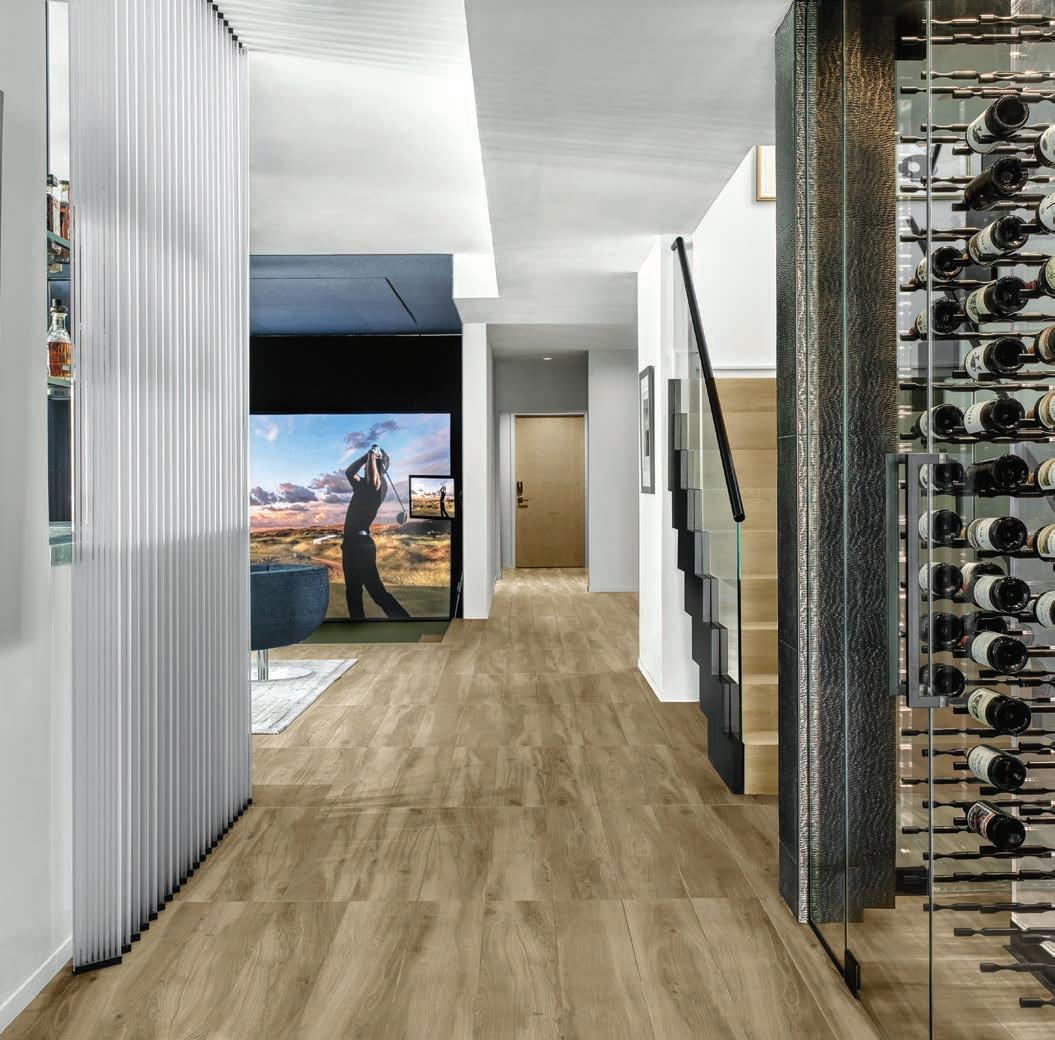
“It’s the smartest home I have ever seen in my life,” Tom says. “The whole thing can be operated from an iPhone.”
Einstein, Tesla and da Vinci would be proud. sl


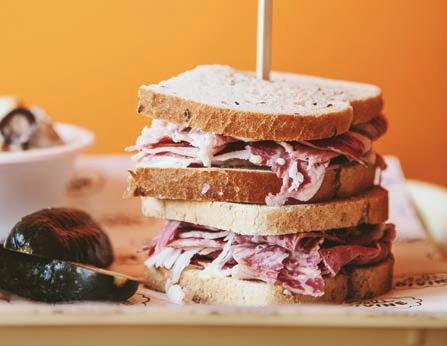


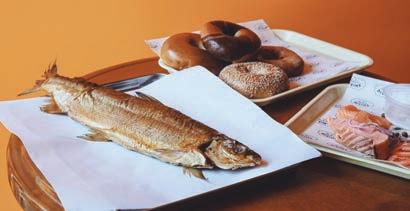
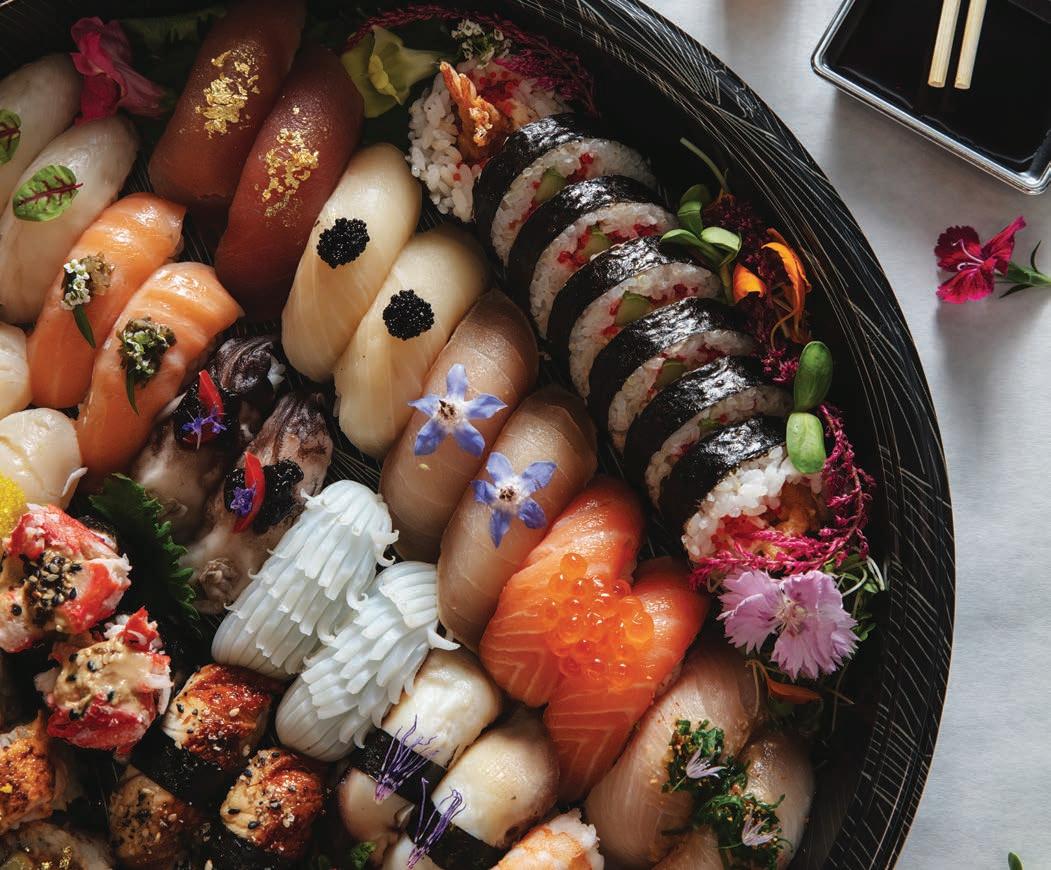 By Grayling Holmes / Photography by Carmen Troesser
By Grayling Holmes / Photography by Carmen Troesser
“If you think you don’t like sushi, it’s because you’ve never had good sushi.” –Chef Heidi Skye Hamamura
When renowned Taberu sushi chef Heidi Skye Hamamura arrived at my home, she carefully balanced a red thermo-insulated bag in one hand, a paper bag in the other. As she opened the red bag with a large green ice pack atop a tray, my anticipation for her signature sushi grew exponentially. She removed the ice and then lifted the tray lid. The aroma of fresh sushi and nose-pleasing spices wafted across my dining room table.
“This is how I reveal my sushi platters to all of my customers,” Heidi begins. She then sat down two bottles of Perrier and a decanter of chilled sake. She decanted the container and filled one with pure sake, the other with Perrier and sake.
“This isn’t just any sake,” she says. “It is pineapple-infused sake, a special recipe my father and I concocted.” I sipped Taberu sake from a champagne flute and the Perrier/Taberu sake from a wine glass.
Heidi’s father, Chef Naomi “Hama San” Hamamura, is one of St. Louis’ OG sushi masters. Although Taberu is primarily available for delivery (IG: @taberu_stl), Heidi caters for individuals and private parties. For parties, she brings along a Taberu bartender; the
Taberu sake/Perrier drink over ice with a candied pineapple garnish is the best seller.
“I warn the ladies that it’s dangerous because it’s so smooth,” she says. “They sometimes giggle and say, ‘Yeah, I wondered how I got so tipsy.’” For those who prefer to dine alcohol-free, Heidi says sushi goes with any beverage of your choosing.
Then it’s showtime. Time to dig into the main event, the beautiful, looks-too-good-to-eat sushi. The platter sitting before us is like a palette from a master painter’s brush, a rainbow awash with vibrant hues and meticulously woven textures.
I ask, “Why the artistry?” Without missing a beat, she says, “It’s because my first passion was to become a traditional artist and get into an art institute. I was a hair’s breadth away from being accepted at the Art Institute of Tampa, but life got in the way.”
Yet to this very moment, that passion for visual art imbues her creations. What I saw before us was a perfect fusion of the two art forms — food and beauty. One look at the kaleidoscope of color on the stunning tray, filled with breathtaking Japanese culinary delights, bespoke years of honing her passions and making them into a masterful skill.
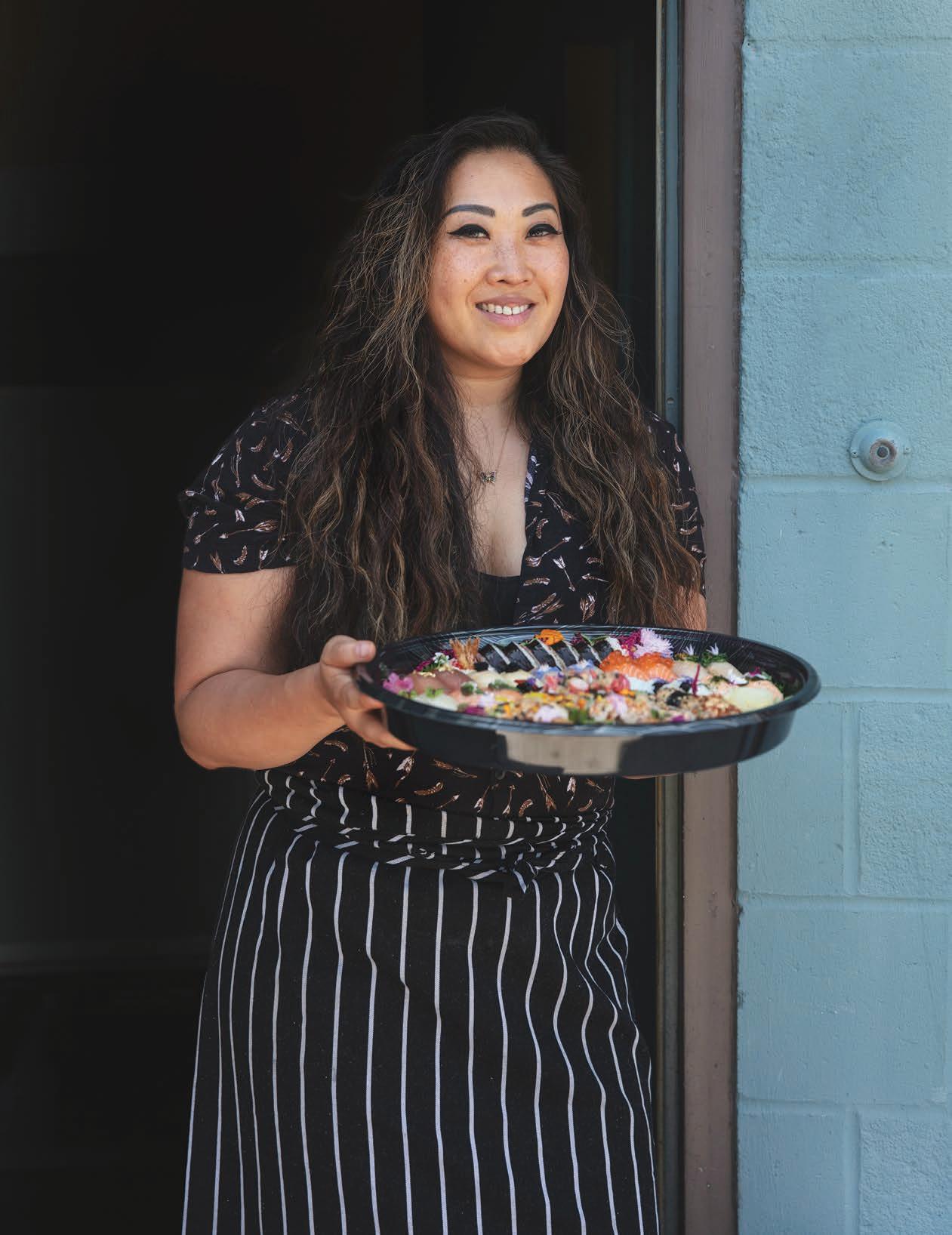
“When I was a girl, my father took me aside and said, ‘Heidi, I don’t care if your passion is to grow up and work at McDonald’s flipping burgers. If that’s what you want you to do, then I will support you 100 percent in whatever makes you happy. I don’t want you to ever regret that you did not follow your dreams. See, look at me. I cook and I’m happy because it’s something I wake up every morning and want to do.’”
The 39-year-old entrepreneur followed her dreams and made them a reality. Heidi forged out a place in the St. Louis culinary stratosphere and skyrocketed to the top. She’s worked at the Saint Louis Club as a sushi chef and for culinary heavyhitters like Elaia and Olio.
Back to the sushi: Heidi places before me a small vial of brown liquid, yet another father-daughter creation. “We take premium Japanese soy sauce and make it low sodium without taking away flavor,” Heidi says. “We give it flavor by halving it with sake and steeping it with shitake mushrooms and kombu seaweed. It gives it a nice umani flavor.”
I start the meal with a piece of shrimp sushi. The shrimp was orange and had its delicate tail attached to the body. Firmly packed rice was underneath. I gasp with pleasure at the taste, not

only of the delicious shrimp, but the subtle flavors and aromas titillate my tastebuds.
“Many people think they don’t like sushi because it tastes fishy,” Heidi says. “I remember the first time that I had salmon and it tasted fishy. ‘Yuck,’ I told whomever gave it to me. That memory sticks with me to this very day. It’s because the fish wasn’t fresh.
“Taberu means eat in Japanese,” she continues. “I named my company that because I’m always telling people to eat. I’m always creating new food items and telling my friends, ‘Here, eat this. Eat. Eat it and tell me what you think. Just eat it anyway,’” she chuckles.
Repeat clients have come to expect edible works of art from Taberu.
“Yeah, as kids we are taught not to play with our food,” Heidi says. “But playing with food is my fun. I use three Japanese food purveyors from Chicago that get everything flown in from Japan. From local famers, I get the edible flowers and micro herbs that I use for garnishes.”
Now that the stage is set, I move onto king crab legs with roasted sesame, tightly-wrapped sushi rolls laden with crab, seared salmon and avocado, and garlic infused albacore. As the meal continued, I found my true sushi love in the most unexpected
months, you’re washing pots; for a whole entire year, you’re making stocks. Then you’re on the hotline for another whole entire year so that you will remember it. You’ll never lose it. So, he learned his craft.
“To inspire one to Taberu, one must prepare only the best, only the freshest, only the most artfully prepared food imaginable,” she says. “Until I find those people, I’m doing just fine inspiring people to eat.” sl
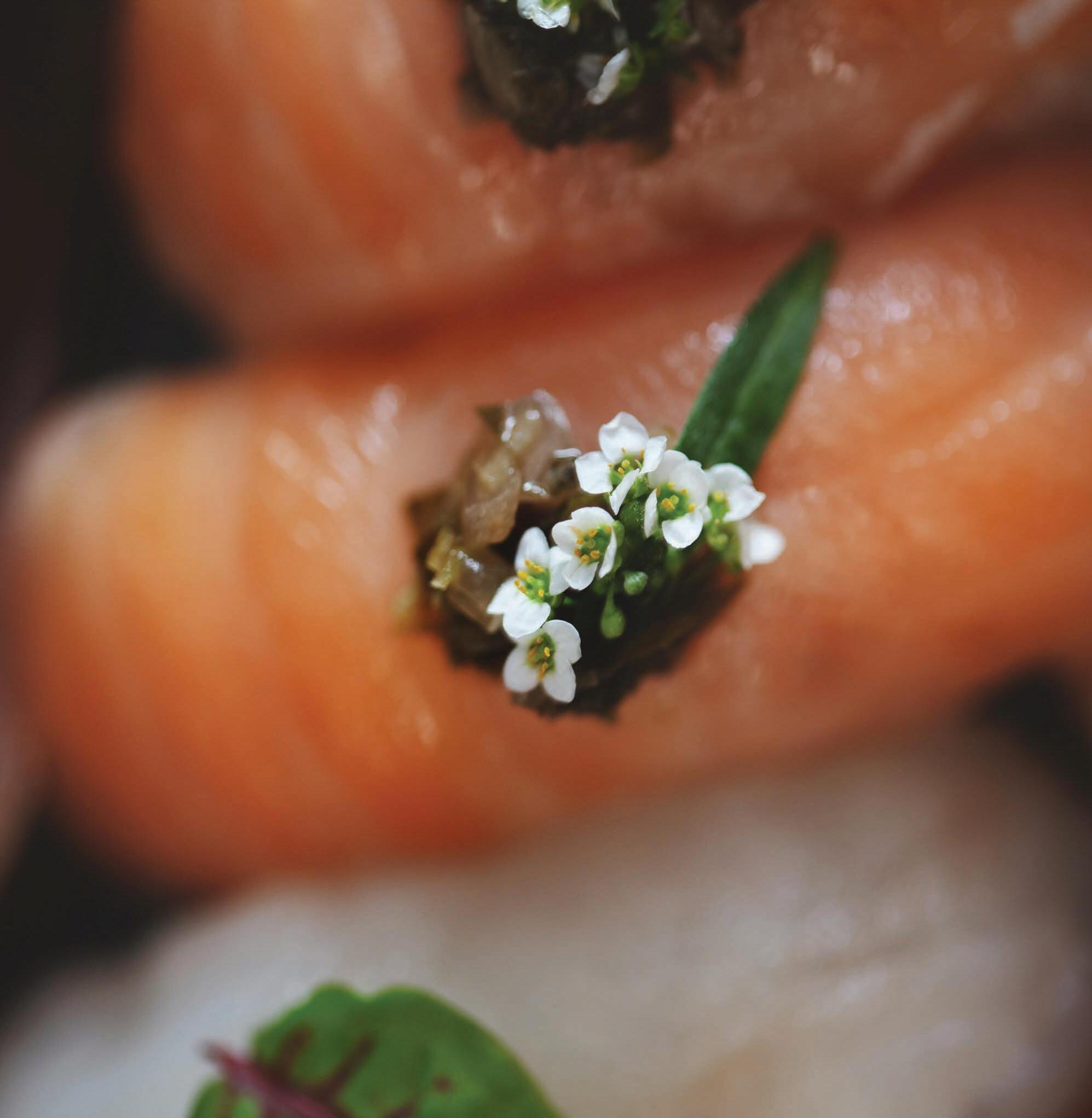
With a little help from Saint Louis Closet Co., you can have a dream closet too.
We all know that when it comes to shoes, more is always better. But where do you put all those fabulous pairs? Carrie Bradshaw famously turned her oven into a shoe closet, but we’ve got a better solution: Saint Louis Closet Co.! With the addition of adjustable shelves and slanted shoe shelves, you’ll have plenty of room for your growing collection. And don’t worry about your beloved purses getting lost in the shuffle – opt for lucite purse dividers, adjustable purse shelves, and chrome purse hooks to keep everything in its place. Trust us, your shoe game (and closet organization) will be on point.

Whether you’re a stilettos kind of gal or thanking the shoe gods that the British Vogue 2023 style guide says ballet flats “are the gift that keeps on giving this season,” you need an organized place to store your shoes. Whether it’s in your closet, your mudroom, or your entry closet adjustable shelving will give you the practical flexibility needed to change styles through the years. But if you’re going for more of a Chanel boutique look, slanted shoe shelves are the key. Either way, whichever style you dip your toe(s) into, organization is key.
Start by organizing your shoe and purse collections by type and then by color.; this allows you to quickly find what you’re looking for and to see all options easily. If you have room, you may want to separate your everyday shoes from your dressy shoes, your athletic shoes from your sandals, etc. Make sure to take your shoes out of the boxes so you can see them. Once you’ve sorted your shoes and purses, put them on adjustable shelving by height so you’re utilizing every inch in your closet.

Winter 2023 Boot Style Prediction from Jennifer Q Williams, owner Saint Louis Closet Co.
Buckled-up Black Boots, envision combat meets punk...grab a copy of the new Scout Guide St. Louis to see what she’s talking about!
Fall 2023 “Must-Have Shoes” from Annie Heyward, Wardrobe Stylist and Owner of Annie Heyward Styling
ON POINT: The ballet shoe has gotten a major upgrade for fall with its elongated and razor-sharp point - as evidenced by footwear seen on the catwalks at both Bottega Veneta and Prada’s fall 2023 shows - look for kitten heel, slingback variations as well!
The STL Working Woman Must-Haves from Claire Flowers, owner Claire Flowers Shoes
Pumps, Wedges, and Mules that are comfortable, stylish, and durable enough to handle the wear and tear a professional woman puts on her footwear.
Carrie Bradshaw is not the only one who needs more room for Shoes!
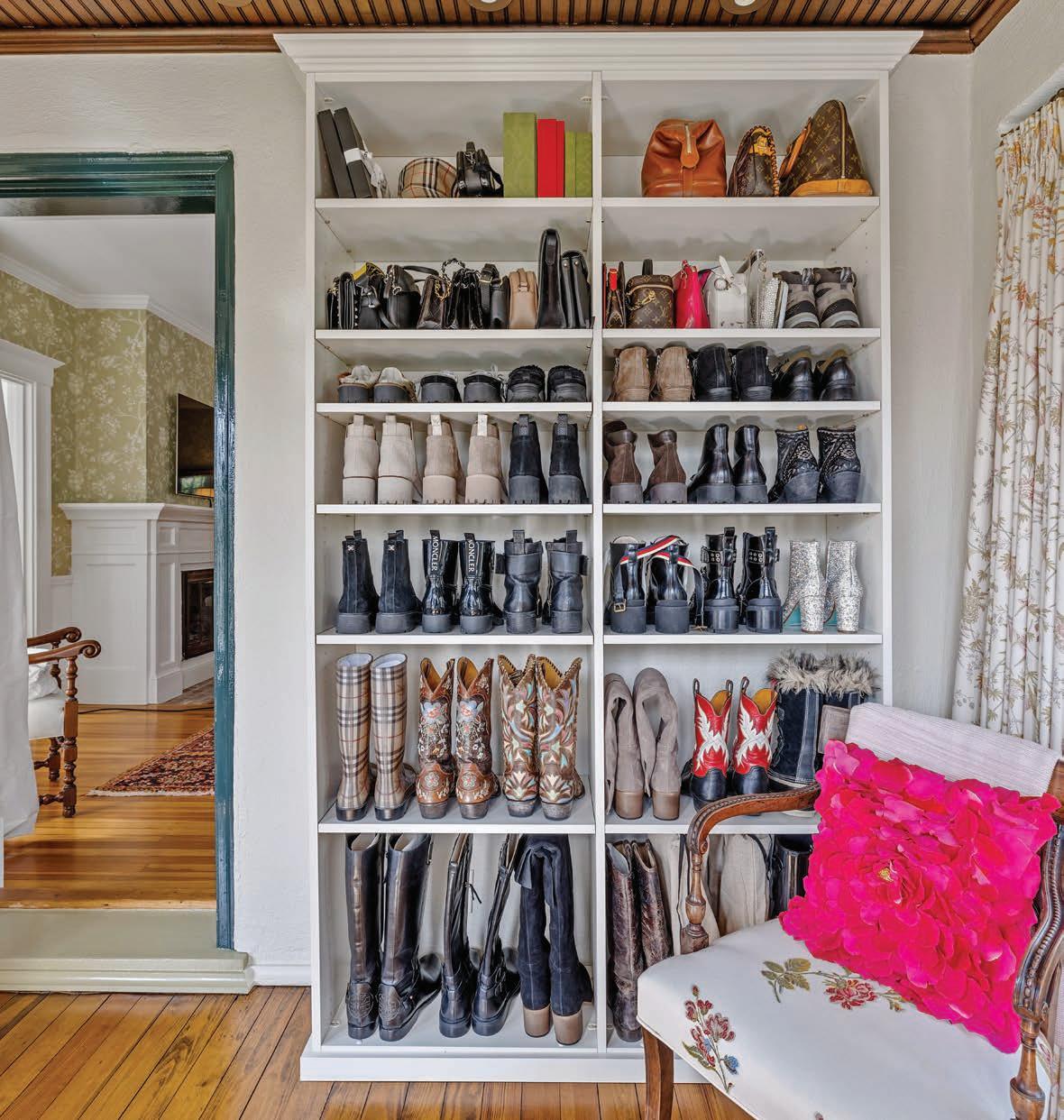

you are
“I cannot recommend Modern Moving Company enough.



Our team of 4 was courteous, helpful, and careful. They talked to us about what they were doing the whole time and were very flexible and accommodating when we asked them to move more than they had planned.
They NEVER stopped working the whole time and were extremely efficient.
Thanks so much!”
We know that moving can be stressful which is why we’ll do whatever it takes to guarantee your complete satisfaction.
FREE ESTIMATES
On-the-spot estimates that we fully stand behind.
PERSONALIZED SERVICE
A designated contact person will professionally manage your move from beginning to end for consistency and attention to detail.
GLOWING REVIEWS
We’re proud to have achieved a 4.9-star Google rating and A+ from Better Business Bureau (BBB).
Our rubber duckies are pretty cute too.
 Luke Heintz, Founder Saint Louis native and Westminster Christian Academy alumni
Luke Heintz, Founder Saint Louis native and Westminster Christian Academy alumni
Sauntering into Hearth & Soul is like visiting the home of an old friend. Albeit, a very wealthy buddy with an extremely well-appointed house but it’s the kind of warm and cozy place where you can simply hang out on a couch or the patio. Have a complementary cuppa. And where you can shop. Til you drop. Everything you see is for sale.
“It’s a gathering place for the community to discover new finds or reunite with old loves,” says Susie Busch Transou, the store’s owner and originator. “So, it can be people or it can be the discovery of an experience or discovery of things, depending on what your needs are and what your desires are. Then if you fall in love with something and want to take it home, you can shop. We believe in immediate gratification.”
The range of products is impressive. “If you want a $25 or $30 gift, we have it for you. If you want a $2,500 gift, we have that for you, too.”
But as anyone with a friend whose tastes are refined and their choices impeccable, we wanted to know what Susie considers the essentials for a home and for inclusion in her store’s inventory.
“Simple, modern, classic,” Susie says. “What comes with that is a space that is uncluttered yet full. It is uncluttered in that you feel peaceful when you’re in it, but it’s full of significance and flavor and texture at the same time. But it’s very livable. I want to be able to sit on the couch and enjoy it.”
Five dogs — a Mastiff, two Labradors, a miniature Labradoodle, and a Lhasa Apso — and three children reside at the Busch Transou house. “I didn’t want to be the mom that would be like, ‘Don’t sit there, don’t stand there.’ No. So, it has to be quality, durable, but also aesthetically pleasing and beautiful. And in my world, that tends to be more neutral with pops of color.”
Take the old and mix it with the new. “I love that kind of eclectic blend of old and new that is timeless,” she says. “I love, as you can see, taking a vintage Hermes scarf and framing it. It’s the unexpected uses of classics.”
Referring to herself as a “less is more” kind of person, she adds that things need to be able to work everywhere. “I love being able to move things. I do this all the time from room to room. So, there is a common palette, if you will, and design aesthetic. You can make a room look new just by bringing something from one room in and swapping.”
Boil it all down and Susie Busch Transou’s aesthetic taps all five senses.
• Sight: “I am claustrophobic so light is very important to me. So that’s why you see a lot of light fixtures, whether it be sconces or chandeliers or lamps.”
• Smell: “I love candles. Surprise and delight.”
• Taste: The store has an entire kitchen nook with everything from local honey to spices, jams, and even steak seasoning made with a recipe created by her father, August Busch III.

• Feel: “The world is pretty chaotic and you want to be in space that brings peace and tranquility. And even just even being in here with our team, we want to energize yet calm.” The overriding consideration is comfort. “And that goes down to our shoes. Seriously.”
• Texture: “I always have loved texture. I think you can see that here in terms of materials and things and art and personality.”
• Hear: “Music is very important to me. And you can see that here at Hearth, we’ve always got our music, and we sell the Turtlebox speakers, which are great speakers, and then also some fun little tiny speakers.”
Another key component to the store: community outreach. “We call it the Shine a Light program where we have a monthly notfor-profit partner. We do three things: We sell a candle to benefit the cause. We spread awareness through our social media and in-store about what the cause does. Then we host an event for them to invite 50 to 75 of their either supporters or constituents or volunteers or staff members to just say thank you.”
The St. Louis store celebrates its first anniversary this fall and Susie is looking forward to more success. “I guess it all makes sense, right? Different textures, diversity of thought, just interesting aesthetics in visual, in thought, and in emotion.”
Hearth & Soul in Ladue welcomes everyone into its cozy and cheerful abode.



Looking at the City of St. Louis, many see mayhem.
Phil Hulse doesn’t. Founder and Chief Executive Office of Green Street Real Estate Ventures, he foresees a “Magic City.” The company’s approach is to buy sizable swathes of land for building apartments, family residences, offices, and, what he terms “the magic sauce,” entertainment.
“A key piece is making it large enough scale in terms of a redevelopment area so you have true impact,” Hulse says. “What’s happened is that more people are interested in an experiential lifestyle and that’s the office, it’s entertainment, it’s how you live. So, all three of those things are our primary focus.
“How do we create workspaces that are energized, full of amenities, that bring people together, that make people want to come into the office because it feels good? If you do that, you have an environment that is not attractive to workers but that will bring them willingly into the office.”
A case in point: 4565 McRee. Green Street bought 18 acres including the old Cardinal Building Supply warehouse, which they converted it into their headquarters.
“We usually take old buildings that are well located and transform them into beautiful new spaces,” Phil says.
The sleek industrial space houses all of the Green Street components and its employees: Green Street Real Estate Ventures, Green Street Brokerage + Management, Green Street Building Group, HAD Architects, O’Toole Design Associates, Emerald
Capital Strategic Advisors, Chapters Living (senior living) and the newest addition, Brick and Bev.
Across the street, the ground has broken on The Rail, an $81 million 269-unit apartment complex. Next door to the Green Street offices is Bar K, the city’s one-and-only park for dogs and restaurant/bar for the owners.
“Bar K [Green Street’s entertainment tenant] draws over 300,000 people a year,” Phil says. “So just think of what bringing that number of people into the neighborhood does. They see what the Grove is like and what other areas of our town are like.”
Green Street has done the same thing with the Armory, a 220,000 square foot space originally built in 1938 to house the 138th Infantry Missouri National Guard Armory. A $60 million investment, it’s now the city’s biggest bar and largest indoor entertainment venue. It includes everything from bars to restaurants, concert space, a two-story slide, 40 interactive games, dozens of tv screens. Under the auspices of Green Street’s affiliate Bricks and Bev, there are plans on adding more spaces on the lower level, additional event space, as well as a rooftop bar.
Once the Armory is fully functioning, Hulse estimates it will draw more than 1.5 million annually. Green Street also bought 21 acres to form to the Armory District.
“St. Louis is filled with historic buildings,” he says. “If you find one of those gems, our position is how do you activate it? It changes how people see the city. It also gives us an opportunity to create these other spaces that are life, work and play experiences.”
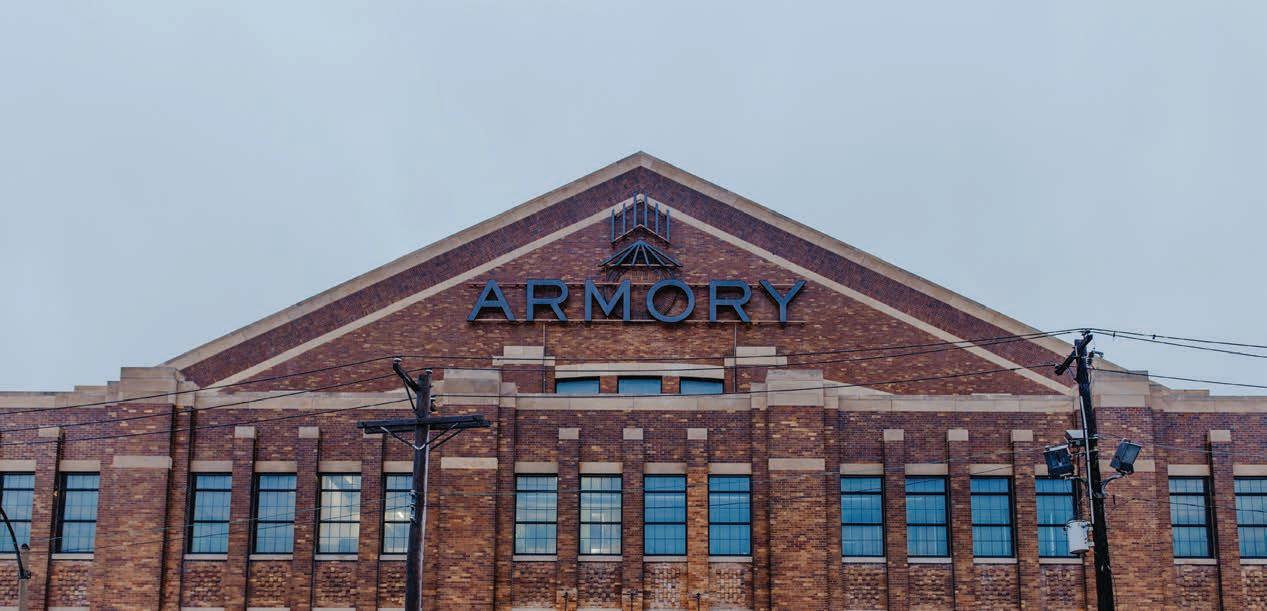
In the past 15 years, Green Street has developed more than 5 million square feet of space in St. Louis. They’ve only just begun.
 Phil Hulse photographed at the Armory
Phil Hulse photographed at the Armory
Projects Completed
• Armory STL
• Terra at the Grove
• Union at the Grove
• Olive + Oak
• The Oscar
• 4565 McRee
• CHROMA
• HUE
• Rockwell Beer Company
• Urban Chestnut Brewing Company
• Market Street Redevelopment
• CSTK-Central States Thermo King of St. Louis
• River City Business Park
• Maryland Redevelopment
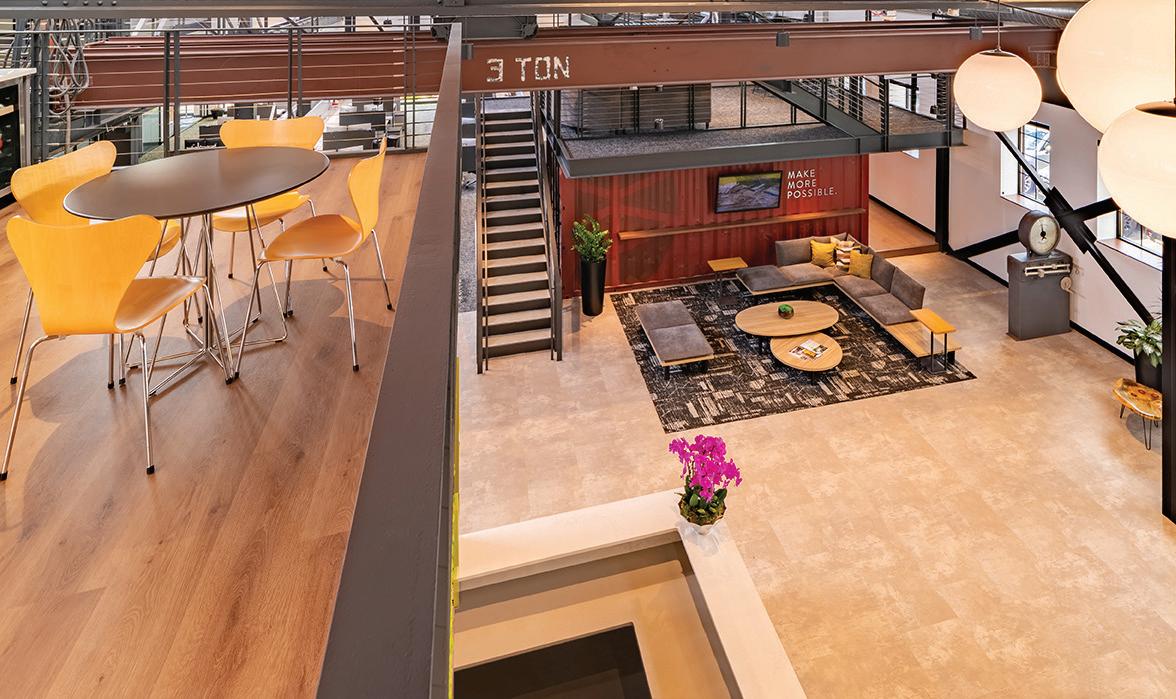
• Jefferson Commons
• Dynalabs
• Sheet Metal Workers Local 36
• Page Business Center
• 8840 Pershall
• Green Park Broadway
• St. Louis Business Center
When asked about suburbanites’ fear of venturing beyond Forest Park, Hulse says the business owners themselves have taken the lead to help the police. Every month, leaders from Cortex, BJC, IKEA, the City Foundry, St. Louis University and Green Street meet to discuss what’s happening and to swap information.
“We have our own security,” Phil says. “Everybody has dialed it up, and everybody knows that crime is our enemy. If the criminals know that you’re out there with watchful eyes and creating an environment that makes it clear that they’re not welcome, it works.
“We have so much momentum going, we can’t let the negative talk slow us down,” he adds. “Yes, it’s there and we need to address it, but we can’t let that stop us.”
Another key element in the Green Street urban development plans are the new segments of the Greenway, including the 20 miles of Brickline. “All of a sudden, you have a way to get somewhere outside of a car,” Hulse says. “And typically, when you build greenways, more people want to be next to that trail than anywhere else,” adding that it becomes primo real estate for restaurants, offices, and residential.
Sustainability has always been a key factor for Green Street, since its inception in 2008 (and hence its moniker). In the lot outside their offices on McRee are a dozen Tesla charging stations.
“I’ve always been sensitive to climate change and being sustainable in how you do business,” Hulse says. “It really opened up a new window of how you can create these dynamic buildings that have good sustainable principles, because the buildings that we are in have the biggest impact on our environment. They consume a lot of energy. So, you’ve got to rethink about what are the heating
• The Rail. Multi-family; 268 units in St. Louis
• 50 S. Bemiston. Mixed-use; 25 stories; 254 units; 300,000-plus square feet in Clayton
• Market Hotels. Joint venture with Midas Hospitality LLC; Kimpton Boutique Hotels (175 rooms); Staybridge Hotel (129 rooms)
• Forsyth + Central Hotel. Joint venture with Midas Hospitality LLC; 21 stories; 240 units in Clayton
• Brentwood Master Plan. Mixed-use development to include multi-family, destination entertainment, retail, restaurants, services, etc.; 40-plus acres
• Famous Barr downtown headquarters. Mixed-use to include residential, retail and office
and cooling systems? How do you orient buildings to use natural light to create a better feeling? How do you use the right materials? How do you take sites that are underutilized, that are in good locations so people can live, work, and play in the same area and so they don’t have to drive a car for 30 minutes or an hour.”
Green Street’s visions for the city range far beyond midtown. The company recently announced plans for a high-rise hotel with jazz club in Clayton on the old World News site, a joint venture with Midas Hospitality; apartments and retail branch and corporate offices for Sterling Bank at 50 South Bemiston; a mixed-use development on 40 acres in Brentwood along Manchester from Hanley to near Brentwood roads; converting the old 54-acre Carondelet Coke plant (now dubbed the River City Business Park) on South Broadway; transforming 100 acres on the north riverfront between Broadway and Wall Street, as well as building hotels on Market (with joint venture partner Midas), in Clayton, and Brentwood. They have done or are planning projects in both North and South St. Louis.
The biggest obstacle Hulse sees is the St. Louisans’ mindset. He’s working hard to try to get the residents to see the city through a more positive lens.
“I bring investors in here from all over the country and they are blown away by what’s going on here,” Phil says. “Most of our big lenders who come here are from the coasts or Chicago or Texas. They come in and go, ‘Wow.’ What they see is what we should be seeing. We take pride in downplaying who we are and what we’re doing versus being cheerleaders.
“Well, I think we have an opportunity to be that Magic City, and we’re headed that way.” sl




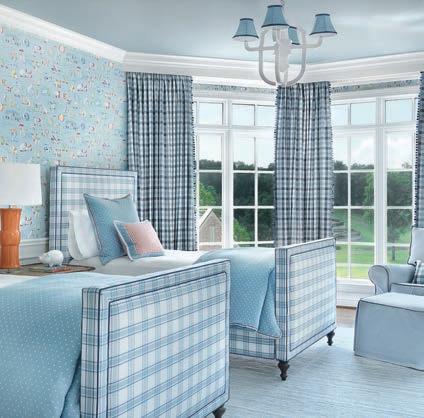

With a masters in journalism and a PhD in American studies, Jody Sowell knows how to find, write, and narrate a great story.
In his second year as the chief executive officer of the Missouri Historical Society but in his 18th with the institution, he also knows how to draw crowds. Big crowds.
Jody Sowell’s a master of exhibits. His first as a full-time MHS employee was “Our Olympics,” detailing the first Olympics held in the United States—and in St. Louis—in the summer of 1904. After being named director of exhibitions and research in 2013, he and his staff created such award-winners as “250 in 250,” an exhibit commemorating the 250th anniversary of the founding of St. Louis that included the stories of 50 people, 50 places, 50 objects, 50 images and 50 memorable moments; “#1 in Civil Rights: The African American Freedom Struggle in St. Louis”; “The Louisiana Purchase”; and “A Walk in 1875 St. Louis.”
Before the pandemic, the museum welcomed more than 400,000 visitors annually. Then 2020 swooped in and Sowell had to make some quick pivots. He oversaw “Uplifting STL,” a social media series featuring inspirational stories from the city’s past, and created a video “St. Louis Strong.” The following year, he debuted as the host of STL History Minutes, which is aired weekly during CBS’ “Sunday Morning.” The museum also implemented a series of walking tours dubbed See STL (followed by either the name of the neighborhood or the subject, i.e. Urban Renewal, Gay Liberation in the Gateway, Downton Origins, Beyond the Ballot, Vietnam in St. Louis.)
Fast forward to 2023 and the current “Color St. Louis” exhibit, an interactive display where visitors can color on a St. Louis skyline illustration on dry-erase wallpaper covering the gallery walls. During peak hours, the lines snake out the door and the patrons are lined up in neat stanchions.
“I’m heartened to see the lines again and to hear the cacophony of chatter, watch the delight of visitors, and feel the electric buzz as patrons flit from room to room to soak it all in,” Jody says.
The CEO’s focus is myopic and zeroed in on St. Louis. He says the historical society has reverted back to its earliest days in 1866, when the founders started it to save St. Louis’ history from being lost. At that time, the terms Missouri Historical Society and St. Louis Historical Society were used interchangeably. In 1913, when the Missouri History Museum was built on the site of the entrance to the 1904 Word’s Fair, “There are those who say that it should have been more aptly named the St. Louis History Museum because of our city’s explosion in population and it’s prominence on the world map.”

Sowell says that interest hasn’t waned. “When local and out-of-town visitors come to our steps, they want to hear about St. Louis and its pivotal role in this country’s history.
“Our city is steeped in the history of America’s founders and has always inspired greatness,” he adds. “What other city can boast that it has played a pivotal role in shaping the soundtrack of America? Scott Joplin, Josephine Baker, Henry Townsend, Tina Turner, Fontella Bass, Miles Davis, and even today’s Nelly? Not many cities can claim people who launched their careers or changed them because of a city. That’s really what we are trying to do in all our work at the museum is to share a past of this place that people can take inspiration from.”
Sowell has announced plans to open three new signature galleries: A brand new 1904 World’s Fair exhibit, a new artifact showcase gallery, and in 2027, a decade-by-decade walkthrough of St. Louis history. That collection, which will be located on the second floor, will detail what St. Louisans were eating, wearing, discussing for each of the time periods.
Other plans include exhibiting more of the Historical Society’s treasures, digitizing more for online consumption, and opening a showcase gallery called “Collected,” starring one single object and exemplifying a significant piece of St. Louis history.
One specific area Sowell is focusing on is St. Louis’ Black population. A story he likes to tell regards an early civil rights activist, Charlton Tandy.
“He was a preacher, accomplished equestrian, as well as a problem solver,” Sowell says. “During segregation, blacks were forbidden to ride inside horse-driven streetcars. Instead, they had stand on narrow exterior platforms holding onto subway-like straps. A pregnant woman was killed by falling off the trolly car and St. Louis was forced to change the law. As you know, one can change a law, but it is another thing to enforce it.”
White streetcar drivers habitually drove past blacks congregated at stops, Sowell explains. One day Carlton Tandy parked his horse in the middle of the street and blocked the oncoming streetcar. The driver was forced to stop and stubbornly exited the streetcar, effectively stranding his passengers.
“Tandy came to the rescue by tethering his horse and taking the reins of the streetcar horse,” Sowell says. “Then he completed the route by picking up waiting black passengers at every stop. Instead of hanging on by straps on dangerous streetcar ledges, they now sat inside the car. Again, St. Louis innovation. The problem necessitates the solution. Even in our darkest and most difficult moments, there are St. Louisans who are trying to make this world a better place. We should imitate the model.”
Jody Sowell has a million stories like that one, all about his adopted city.
“My career has come full circle. My wife Shannon and I came to St. Louis and fell in love,” he says. “We get to stay because that love affair continues. Our hope is that through my work, we can spread that feeling to every visitor who walks through the museum doors by showing them that the past is present and that St. Louis continues to build a gateway to the future. One might say that St. Louis remains a light on the hill, just as it was when it stole the world’s spotlight at the World’s Fair.” sl

With over 40 years of industry experience, we have numerous options to accommodate your travel needs, competitive charter rates, and an exclusive Charter Shares membership program.

September
16 BALLOON GLOW! The Great Forest Park Balloon Race, Forest Park, greatforestparkballoonrace.com
16 Glennon Gallop, August Busch Polo Club, Glennon.org
16 Old Webster Jazz & Blues Festival, 483 E. Lockwood, oldwebsterjazzfest.com
21 16th Annual Girls Night Out for Marian School, Knight Hall at Washington University, marianmiddleschool.org
23 St. Louis Symphony’s Opening Weekend with Hilary Hahn, Stifel Theatre, slso.org
23 Block Party: 20 Years of CAM (Contemporary Art Museum), camstl.org
23-24 Pedal The Cause, Chesterfield, pedalthecause.org
29 The Magic Ball La Dolce Vita, The Magic House, the magichouse.org
1 St. Louis VegFest 2023, World’s Fair Pavilion, Forest Park, stlouisvegfest.org
6-8 The Best of Missouri Market, Missouri Botanical Garden, missouribotanicalgarden.org
6 “The Temptations,” The Fabulous Fox, fabulousfox.com



7 St. Louis Walk fundraiser for Autism Speaks, Muncipal Theatre Association, Forest Park, autismspeaks.org
18-21 Couturier sale, The Resale Shop, National Council of Jewish Women St. Louis, ncjwstl.org
28 An Evening with John Cusack and a Screening of “Say Anything,” Stifel Theatre, ticketmaster.com



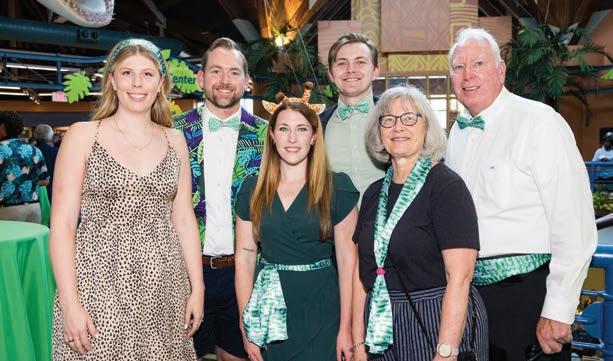

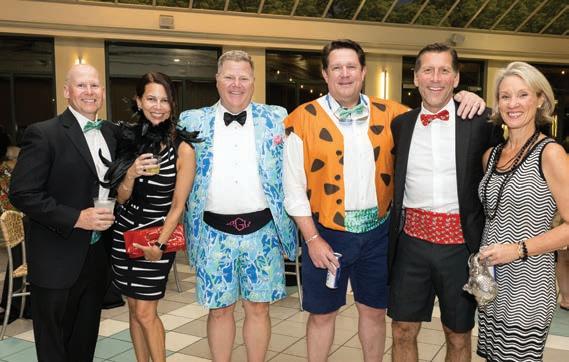
The quintessential Zoofari, presented by Well Fargo and held at the Saint Louis Zoo, hosted approximately 2,400 guests. All decked out in creative black tie, the guests dined on food provided at 40 local restaurant and caterer stations. On the main stage, The Downtown Band serenaded partygoers throughout the evening. By the end of the night, the signature event had raised more than $944,000, earmarked to support the Zoo and its conservation efforts locally and internationally.







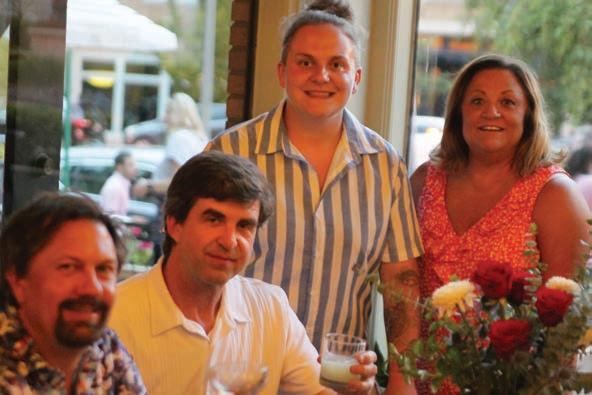
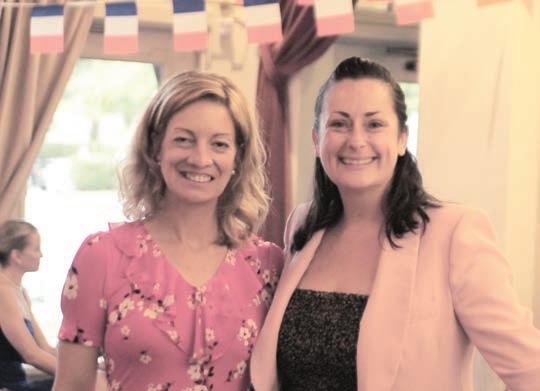
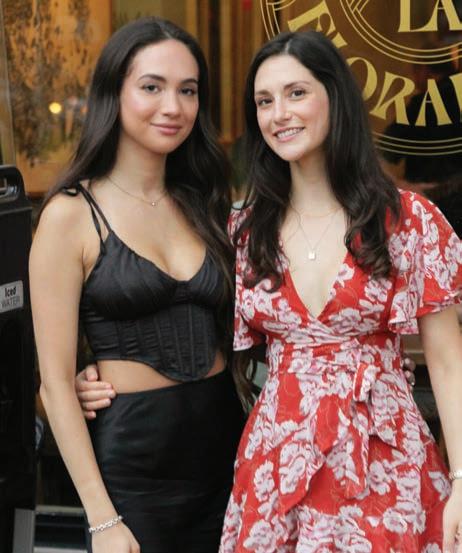
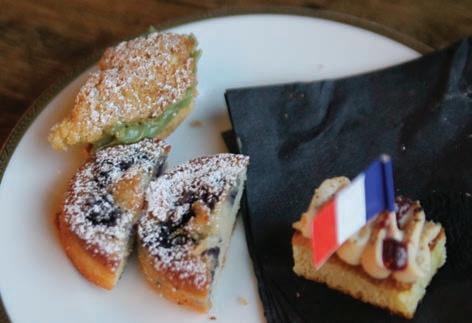
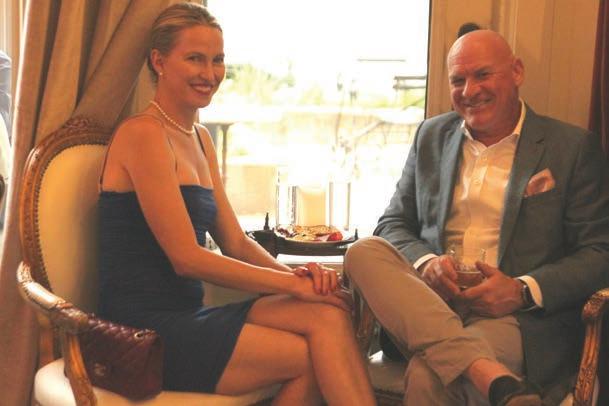
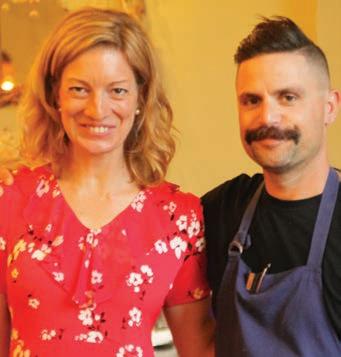
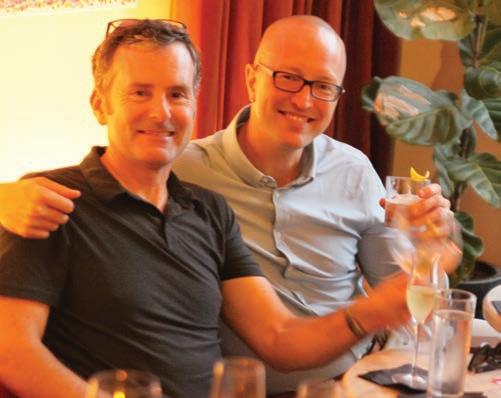
In celebration of Bastille Day and Bistro La Floraison’s one-year anniversary, owners Chef Michael and Tara Gallina cleared out the restaurant’s dining room and threw a party. Guests toasted the holiday in true French fashion as they ate delectable hors d’oeuvres and enjoyed specialty cocktails and featured French wines. Partygoers were “whisked away” to the streets of Paris and many came dressed in Parisian attire befitting Bastille Day.

FOR A FAMILY RETREAT OR PRIVATE CORPORATE NEEDS, OVERLOOK FARM IS A SURPRISING AND INSPIRING OASIS OFFERING ITS FIVE INNS AVAILABLE FOR LEASE FOR THE FIRST TIME IN ITS STORIED HISTORY.




RELAX. PLAY. LIVE.
Just 75 minutes north of St. Louis!

overlookfarmmo.com
CEDARCREST MANOR Nestled among a cluster of towering cedars and tucked away just up the hill from the city of Clarksville. Built in 1842 by Captain Benjamin Clifford, a prominent riverboat captain, Cedarcrest began its life as a plantation home and quickly became the archetype for a number of houses built in the Mississippi River Valley. Romanesque pool which creates a quiet, and restful place to relax and recharge. Rich with amenities, this enchanting Missouri inn is adorned with antiques and features a fireplace in every room.
RACKHEATH HOUSE Perched atop the hills of the Mississippi River Valley, and situated just a short walk from the Overlook—one of the highest spots along the river. Built in 1860 and restored in 2006 by Nathalie Pettus, this Greek revival-style manor features sprawling grounds, a spacious veranda, and a romantic, flourishing garden filled with gorgeous walking paths. Its accessible, state-of-the art kitchen and elegant dining room provide guests with the ideal place to uncork a bottle of wine or sip a cup of coffee.
GREGG WILLIAMSON

(cell) 314-359-9210
(office) 314-677-6254
GreggWilliamson.com

BRIDAL COTTAGE An intimate space for couples to get away. Perched above the meadow, surrounded by rolling hills, it provides beautiful views of the sunrise and sunsets. A guest will find a full kitchen and beautifully decorated bedroom creating a weekend you’ll never forget!
AVALON HOUSE By far one of the most breath-taking views on the property overlooking the Mississippi River. This home is perfect for retreats of any occasion. Avalon House is fully furnished with four bedrooms, four bathrooms, a kitchen, and a wrap-around deck.



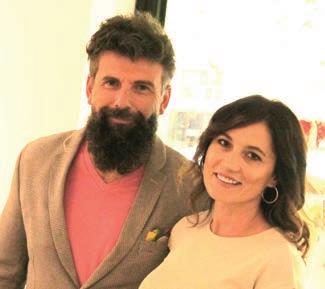
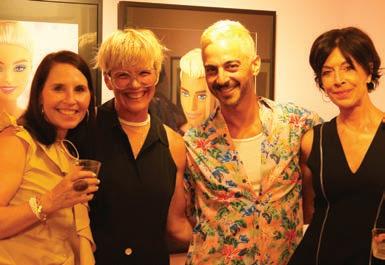
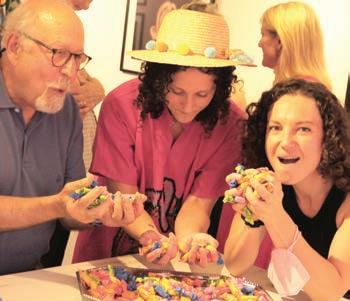





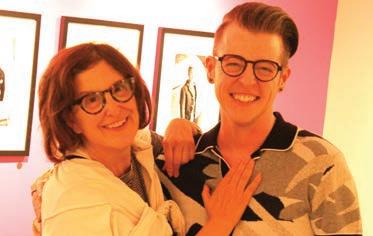

Houska Gallery showcased area artists during their July 14th Summer Group show. Featured artist Larry Tornos unveiled “Glamourous,” an exhibition of new works of this summer’s most glamourous retro icons, Ken and Barbie. Gallery viewers sipped white wine and chatted with artists while also viewing their newest exhibitions, POP and PREP with cultural references imagined in color, image, and pattern.








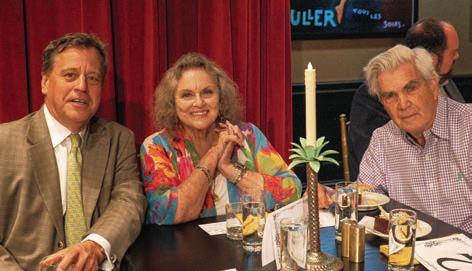
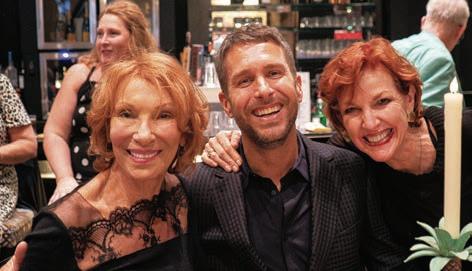
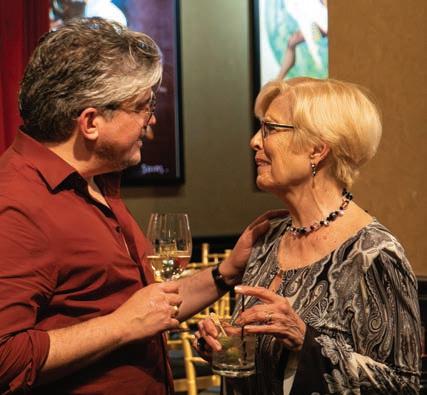


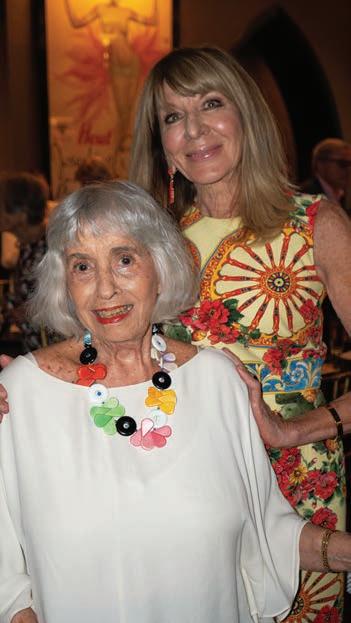
The Tennessee Williams Festival St. Louis proudly presented The Brass Menagerie Benefit, a cabaret/gala honoring St. Louis legend, Mary Strauss, at the Curtain Call Lounge. Amy Jo Jackson and Brian Nash conceived and performed a mesmerizing cabaret showcasing Tennessee Williams’ iconic female characters through the lens of golden age musical theatre.


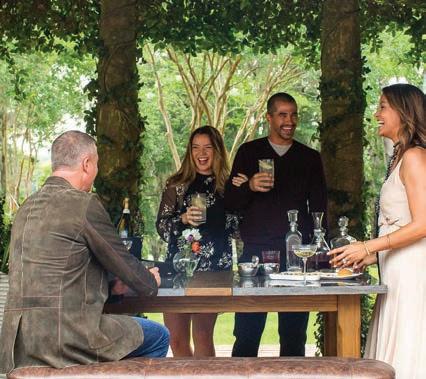




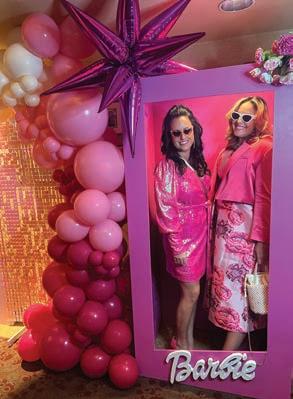






Model Kelly Bagwe brought together fashion, film, and girly fun at the Chase Theater for the premiere of the blockbuster “Barbie.” Kelly reached out to the St. Louis Fashion Fund who is celebrating their 10th anniversary to help with the event. A giant Barbie doll box designed by Bounce and Bash Co. took center stage as models and others came to life fit for a shelf. Kelly and her crew later gave out more than 100 Barbie and Ken dolls to patients at Cardinal Glennon Children’s Hospital.

SEE ALL THERE IS
AUGUSTA,MO - AMERICA’S FIRST WINE REGION






BOUTIQUE SHOPPING

RIVER CRUISES
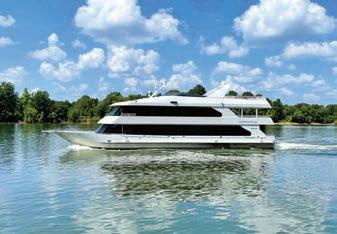
WINE TASTING
GUEST COTTAGES
BIKE RENTALS
FREE WINE TROLLEYS
WEDDINGS & PRIVATE EVENTS
FINE DINING, BAKERY & BISTROS


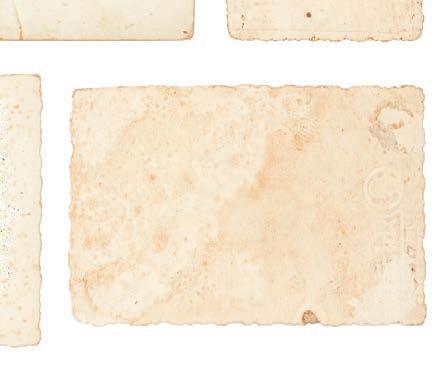
VINEYARD & CELLAR TOURS

WEEKEND LIVE MUSIC AND SO MUCH MORE!

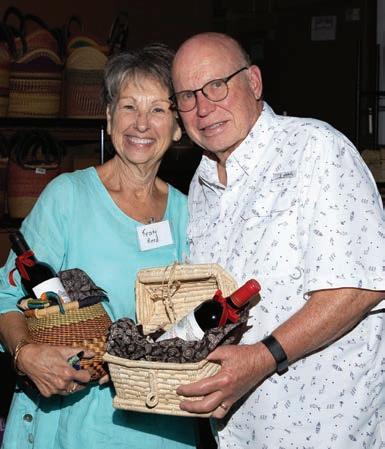
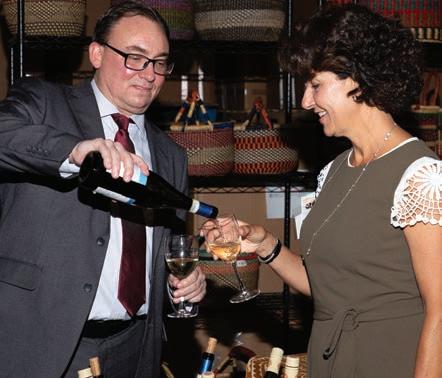
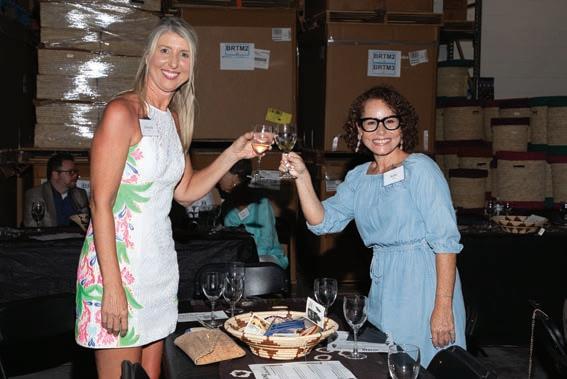
Local nonprofit Ten By Three invited guests to its World Headquarters for Wine in the Warehouse. The evening included a wine tasting and check-in with founder/ CEO Theresa Carrington live from Uganda! Ten By Three reduces poverty in developing countries by paying artisans Prosperity Wages® for handwoven products, which enables them to become entrepreneurs and gain financial independence.
